D Link IR516A1 Wireless AC Router User Manual DIR 516 Manual
D Link Corporation Wireless AC Router DIR 516 Manual
D Link >
User Manual.pdf
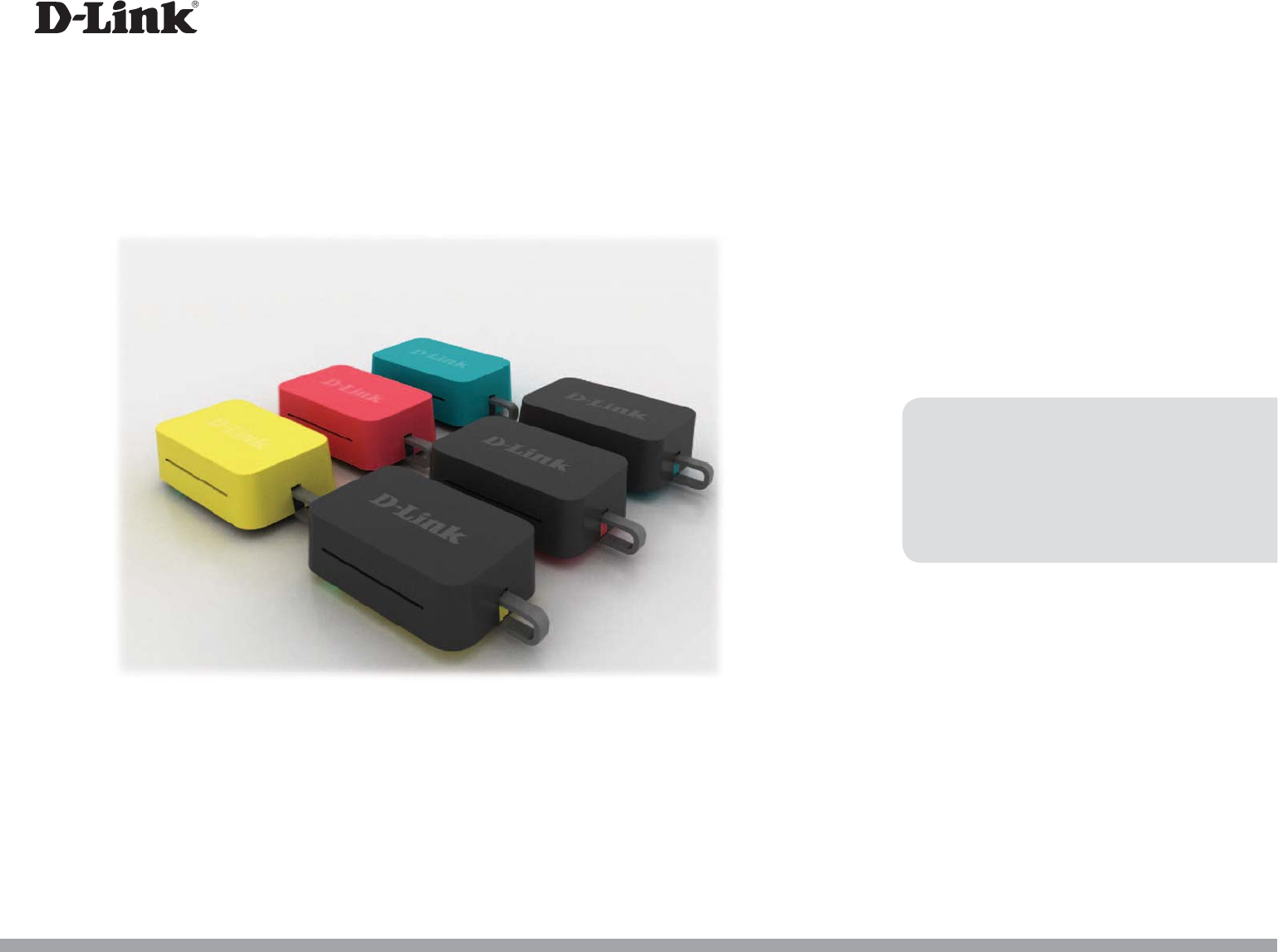
Version 1.0 | December 12, 2013
DIR-516
User Manual

iD-Link DIR-516 User Manual
D-Link reserves the right to revise this publication and to make changes in the content hereof without obligation to notify any
person or organization of such revisions or changes.
Manual Revisions
Trademarks
D-Link and the D-Link logo are trademarks or registered trademarks of D-Link Corporation or its subsidiaries in the United
States or other countries. All other company or product names mentioned herein are trademarks or registered trademarks of
their respective companies.
Copyright © 2013 by D-Link Corporation.
All rights reserved. This publication may not be reproduced, in whole or in part, without prior expressed written permission
from D-Link Corporation.
This purpose of this product is to create a constant network connection for your devices. As such, it does not have a standby
mode or use a power management mode. If you wish to power down this product, please simply unplug it from the power
outlet.
Revision Date Description
1.0 December 16, 2013 • Initial release
Preface

iiD-Link DIR-516 User Manual
Table of Contents
Preface ................................................................................. i
Manual Revisions ........................................................................... i
Trademarks ...................................................................................... i
Product Overview .............................................................. 1
Package Contents ......................................................................... 1
System Requirements ................................................................. 2
Introduction ................................................................................... 3
Features ............................................................................................ 4
Hardware Overview ..................................................................... 5
Front/Side ................................................................................5
Bottom ......................................................................................6
Operation Modes ..........................................................................7
Router Mode ...........................................................................8
Access Point Mode ............................................................... 9
Wireless Installation Considerations ....................................10
Setting Up With a Web Browser ......................................11
Router Mode .........................................................................12
Access Point Mode .............................................................12
Router Mode ................................................................................13
Initial Setup Wizard ............................................................13
Manual Conguration .......................................................15
Setup ..................................................................................16
Wizard ..........................................................................16
Local Network ...........................................................20
Internet Setup ...........................................................24
Wireless..............................................................................27
Wireless Basics ...........................................................27
Wi-Fi Protected (WPS) Setup ................................30
Advanced Wireless ...................................................31
Advanced ..........................................................................33
Access Control List ...................................................33
Port Triggering ..........................................................34
DMZ ..............................................................................35
URL Block ....................................................................36
Dynamic DNS ............................................................37
QoS ................................................................................ 38
UPnP .............................................................................40
Virtual Server .............................................................41
Maintenance .................................................................... 43
Reboot .........................................................................43
Firmware Upgrade ...................................................44
Backup/Restore.........................................................45
Admin ...........................................................................46
Time and Date ...........................................................47
Status ..................................................................................48
Device Info ..................................................................48
Active Client Table ...................................................49
Statistics ......................................................................50
Help.....................................................................................51
Access Point Mode .....................................................................52
Manual Conguration .......................................................52
Table of Contents

iiiD-Link DIR-516 User Manual
Table of Contents
Setup ..................................................................................53
Local Network ...........................................................53
Wireless..............................................................................54
Wireless Basics ...........................................................54
Wi-Fi Protected (WPS) Setup ................................57
Advanced Wireless ...................................................58
Maintenance .................................................................... 60
Reboot .........................................................................60
Firmware Upgrade ...................................................61
Backup/Restore.........................................................62
Admin ...........................................................................63
Time and Date ...........................................................64
Status ..................................................................................65
Device Info ..................................................................65
Active Client Table ...................................................66
Statistics ......................................................................67
Help.....................................................................................68
Connecting a Wireless Client ..........................................69
WPS Button ...................................................................................69
Windows® 8 ...................................................................................70
WPA/WPA2 ............................................................................70
Windows® 7 ...................................................................................72
WPA/WPA2 ............................................................................72
WPS ..........................................................................................75
DIR-516 ...................................................................................76
Windows Vista® ............................................................................79
WPA/WPA2 ............................................................................80
WPS/WCN 2.0 .......................................................................82
Windows® XP ................................................................................83
WPA/WPA2 ............................................................................84
Troubleshooting ..............................................................86
Wireless Basics .................................................................90
What is Wireless? .........................................................................91
Tips ...................................................................................................93
Networking Basics ...........................................................94
Statically Assign an IP address ...............................................95
Technical Specications ..................................................96
Safety Statements ...........................................................97

1D-Link DIR-516 User Manual
Section 1 - Product Overview
Package Contents
DIR-516
Quick Installation Guide
If any of the above items are missing from your package, please contact your reseller.
Product Overview

2D-Link DIR-516 User Manual
Section 1 - Product Overview
Network Requirements
• An Ethernet-based Cable or DSL modem
• IEEE 802.11ac, 802.11a, 802.11n or 802.11g wireless clients
• 10/100 Ethernet
Web-based Conguration
Utility Requirements
Computer with the following:
• Windows®, Macintosh, or Linux-based operating system
• An installed Ethernet adapter
Browser Requirements:
• Microsoft Internet Explorer® v7, Mozilla® Firefox® v9.0,
Google® Chrome 16.0, or Safari® v4 or higher version
Windows® Users: Make sure you have the latest version of Java
installed. Visit www.java.com to download the latest version.
System Requirements

3D-Link DIR-516 User Manual
Section 1 - Product Overview
Introduction
TOTAL COVERAGE
Provides greater wireless signal rates even at farther distances for incredible wireless coverage.
ULTIMATE PERFORMANCE
The D-Link DIR-516 lets you create a secure wireless network to share photos, les, music, video, printers, and network storage throughout
your home. Connect the DIR-516 router to a cable or DSL modem and share your high-speed Internet access with everyone on the network.
TOTAL NETWORK SECURITY
The DIR-516 router supports all of the latest wireless security features to prevent unauthorized access, be it from over the wireless
network or from the Internet. Support for WPA/WPA2 standards ensure that you’ll be able to use the best possible encryption method,
regardless of your client devices. In addition, this router utilizes dual active rewalls (SPI and NAT) to prevent potential attacks from
across the Internet.
* Maximum wireless signal rate derived from IEEE Standard 802.11a, 802.11g, 802.11n and draft 802.11ac specications. Actual data throughput will vary. Network conditions
and environmental factors, including volume of network trac, building materials and construction, and network overhead, lower actual data throughput rate. Environmental
conditions will adversely aect wireless signal range.

4D-Link DIR-516 User Manual
Section 1 - Product Overview
• Faster Wireless Networking - The DIR-516 provides an up to 150Mbps wireless connection in 2.4GHz band,
433Mbps wireless connection in 5GHz with other 802.11ac and draft 802.11n wireless clients. This capability allows
users to participate in real-time activities online, such as video streaming, online gaming, and real-time audio.
• Portable and Easy to Use - Simply plug the DIR-516 into a power outlet at home or abroad to create an instant
wireless network wherever you are.
• Compatible with 802.11a/g/n Devices - The DIR-516 is still fully compatible with the IEEE 802.11a, 802.11g
and 802.11n, so it can connect with existing 802.11a, 802.11g and 802.11n PCI, USB, and Cardbus adapters.
• User-friendly Setup Wizard - Through its easy-to-use web-based user interface, the DIR-516 lets you control what
information is accessible to those on the wireless network, whether from the Internet or from your company’s
server. Congure your router to your specic settings within minutes.
* Maximum wireless signal rate derived from IEEE Standard 802.11a, 802.11g, 802.11n and draft 802.11ac specications. Actual data throughput will vary. Network conditions
and environmental factors, including volume of network trac, building materials and construction, and network overhead, lower actual data throughput rate. Environmental
conditions will adversely aect wireless signal range.
Features
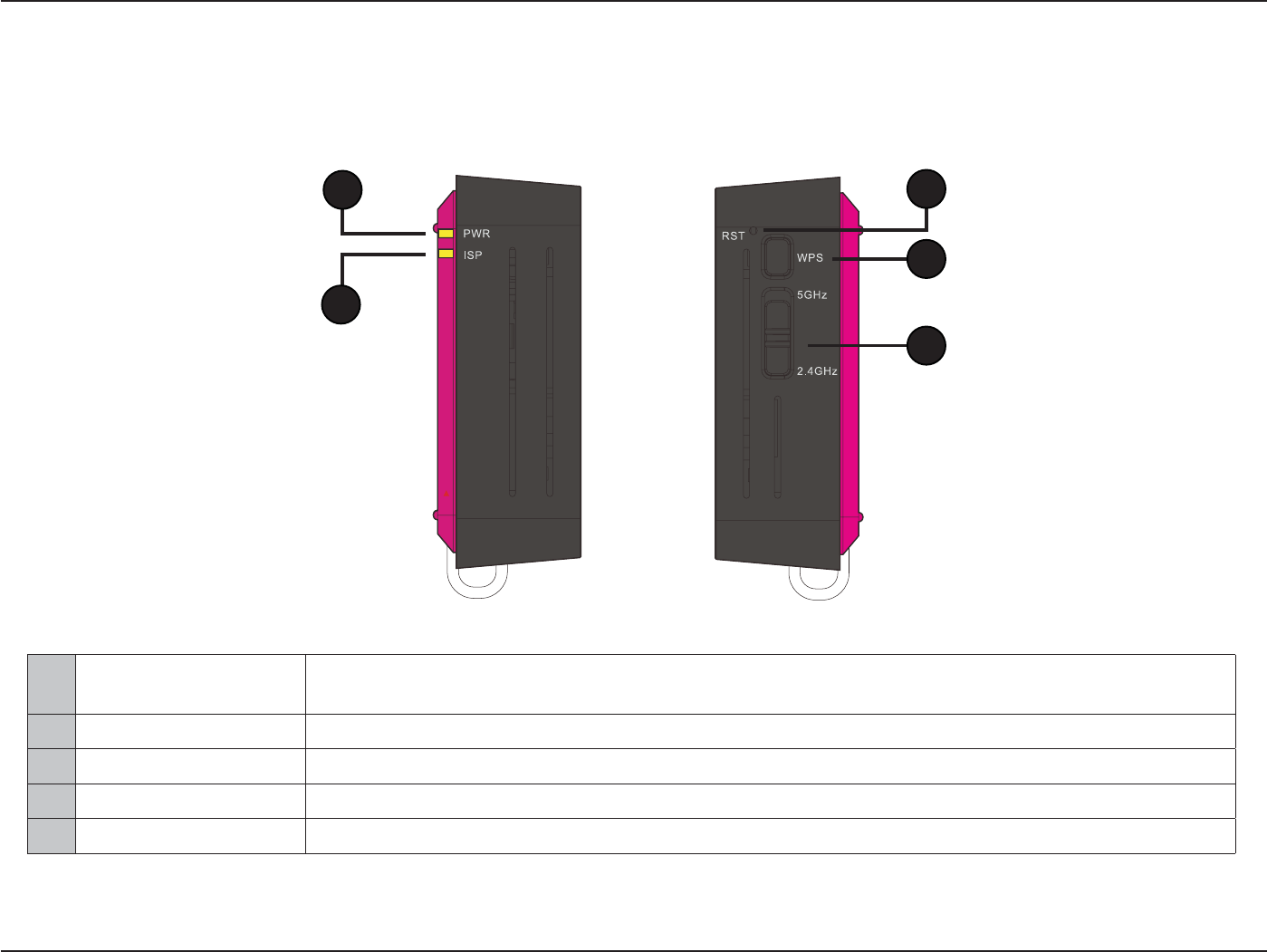
5D-Link DIR-516 User Manual
Section 1 - Product Overview
Hardware Overview
Front/Side
1Power (PWR LED) A solid green light indicates a proper connection to the power supply. The light will blink when connectiong
to a device through WPS.
2Internet (ISP) LEd A solid light indicates connection on the Internet port.
3Selector Switch Slide this switch to select between 2.4GHz and 5GHz
4WPS Button Press this to activate Wi-Fi Protected Setup(WPS) to connect other wireless devices automatically.
5Reset Button Pressing the Reset button for 5 seconds restores the router to its original factory default settings.
1
3
4
5
2

6D-Link DIR-516 User Manual
Section 1 - Product Overview
Hardware Overview
Bottom
1Ethernet Port The auto MDI/MDIX Internet port is the connection for the Ethernet cable to the cable or DSL modem.
1

7D-Link DIR-516 User Manual
Section 1 - Product Overview
Operation Modes
Depending on how you want to use your DIR-516 will determine which mode you use. The following pages describe each
mode to help you gure out which one to use.
• Router Mode: page 8
• Access Point Mode: page 9
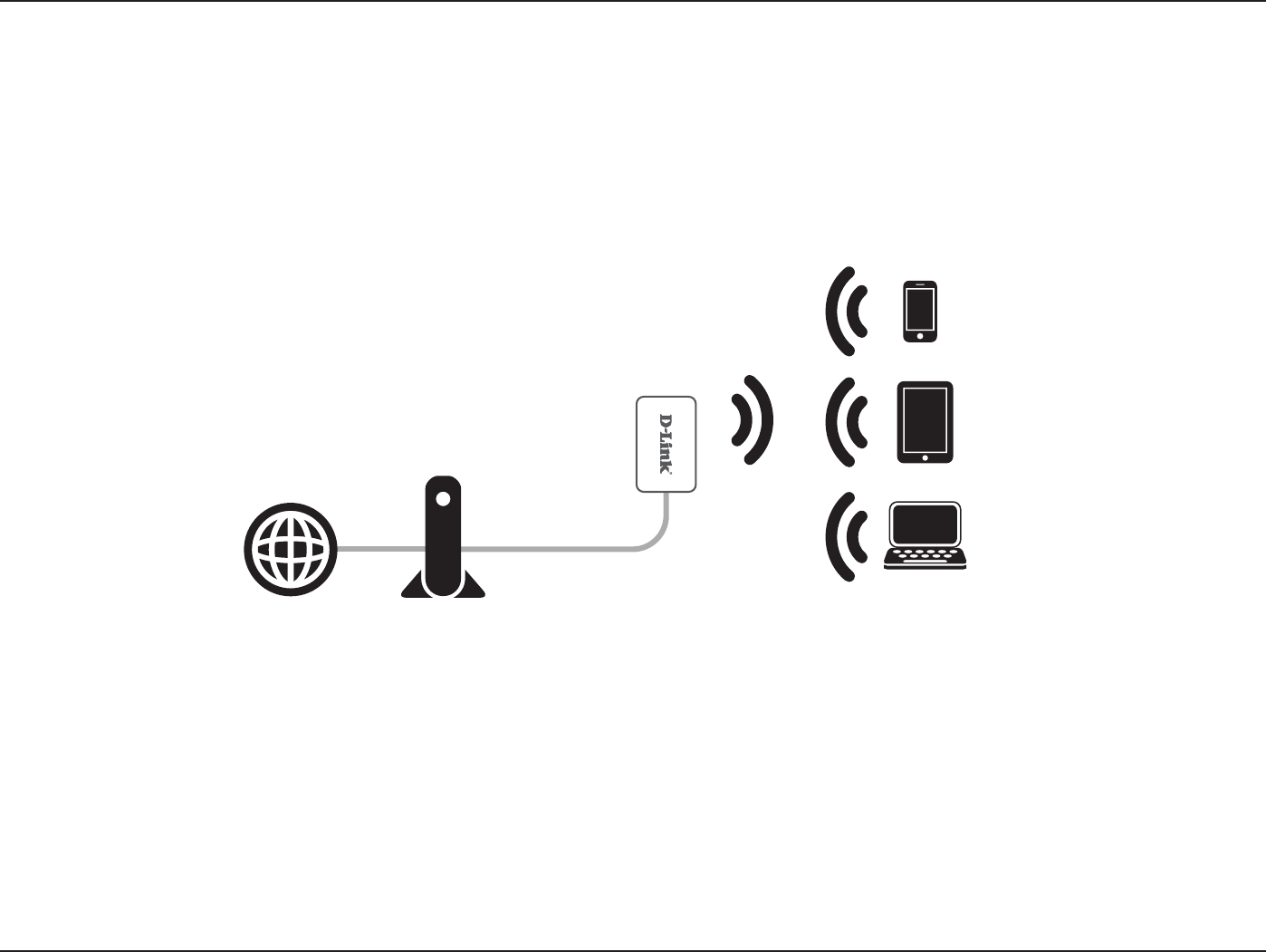
8D-Link DIR-516 User Manual
Section 1 - Product Overview
Router Mode
In Router Mode, the DIR-516 connects to your cable modem, DSL modem, or other Internet source and shares your Internet
connection with your devices wirelessly, providing Internet access for an entire home or oce.
Router Mode
Cable/DSL Modem Wireless Devices
Internet
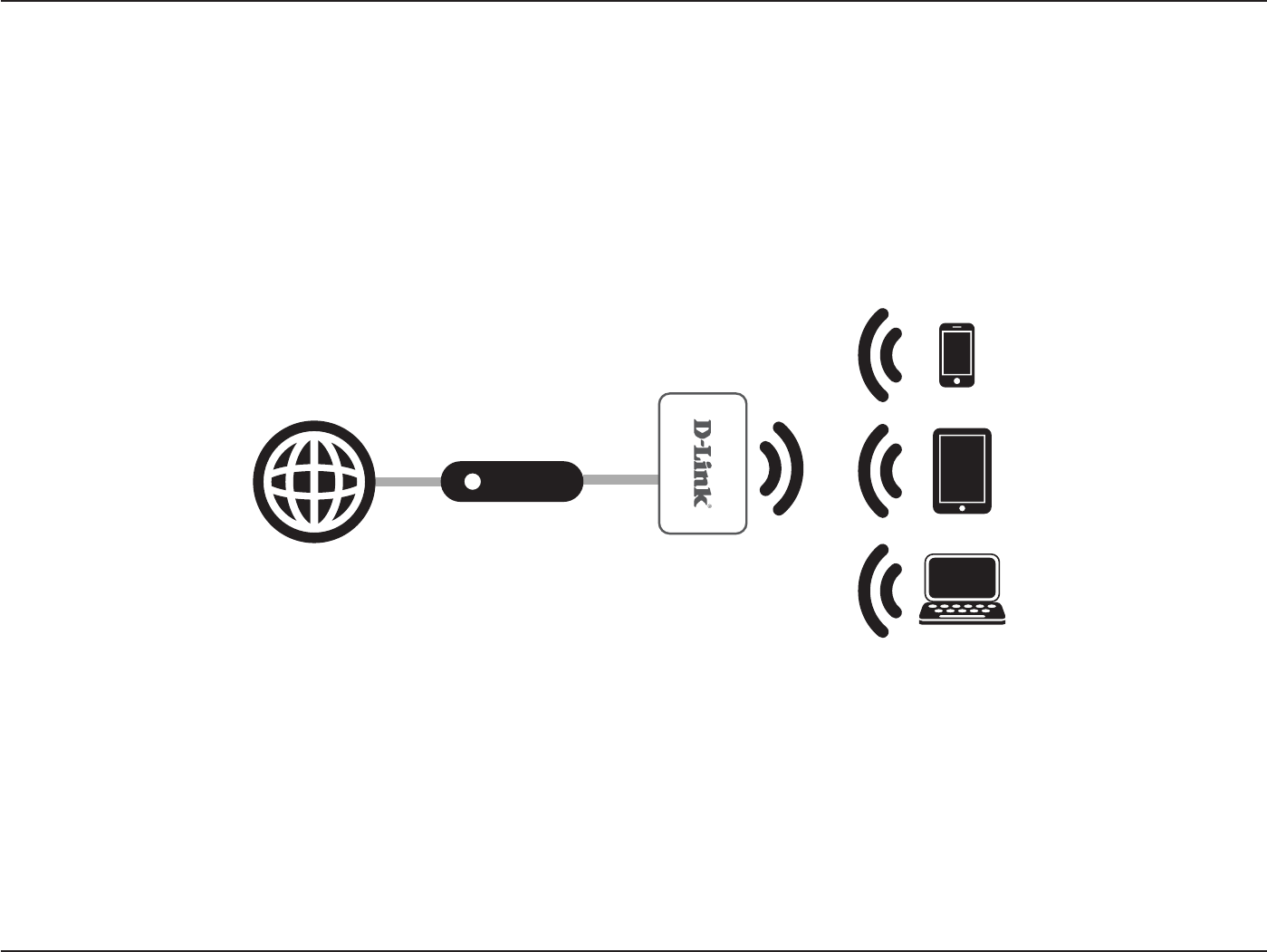
9D-Link DIR-516 User Manual
Section 1 - Product Overview
Access Point Mode
In Access Point Mode, the DIR-516 connects your wireless devices together, but does not provide routing functionality. It also
allows a connected wired device to connect to your other devices wirelessly. This can be useful if you already have an existing
Internet router that does not have built-in wireless capabilities. You can also use this to create a private wireless network
without Internet access so that your devices can securely connect to one another without being exposed to the Internet or
other computers.
Access Point Mode
Router
(optional)
Wireless Devices
Internet
(optional)

10D-Link DIR-516 User Manual
Section 1 - Product Overview
Wireless Installation Considerations
The D-Link wireless router lets you access your network using a wireless connection from virtually anywhere within the
operating range of your wireless network. Keep in mind, however, that the number, thickness and location of walls, ceilings,
or other objects that the wireless signals must pass through, may limit the range. Typical ranges vary depending on the types
of materials and background RF (radio frequency) noise in your home or business. The key to maximizing wireless range is to
follow these basic guidelines:
1. Keep the number of walls and ceilings between the D-Link router and other network devices to a minimum -
each wall or ceiling can reduce your adapter’s range from 3-90 feet (1-30 meters.) Position your devices so that
the number of walls or ceilings is minimized.
2. Be aware of the direct line between network devices. A wall that is 1.5 feet thick (.5 meters), at a 45-degree angle
appears to be almost 3 feet (1 meter) thick. At a 2-degree angle it looks over 42 feet (14 meters) thick! Position
devices so that the signal will travel straight through a wall or ceiling (instead of at an angle) for better reception.
3. Building materials make a dierence. A solid metal door or aluminum studs may have a negative eect on range.
Try to position access points, wireless routers, and computers so that the signal passes through drywall or open
doorways. Materials and objects such as glass, steel, metal, walls with insulation, water (sh tanks), mirrors, le
cabinets, brick, and concrete will degrade your wireless signal.
4. Keep your product away (at least 3-6 feet or 1-2 meters) from electrical devices or appliances that generate RF
noise.
5. If you are using 2.4 GHz cordless phones or X-10 (wireless products such as ceiling fans, lights, and home security
systems), your wireless connection may degrade dramatically or drop completely. Make sure your 2.4 GHz phone
base is as far away from your wireless devices as possible. The base transmits a signal even if the phone in not
in use.
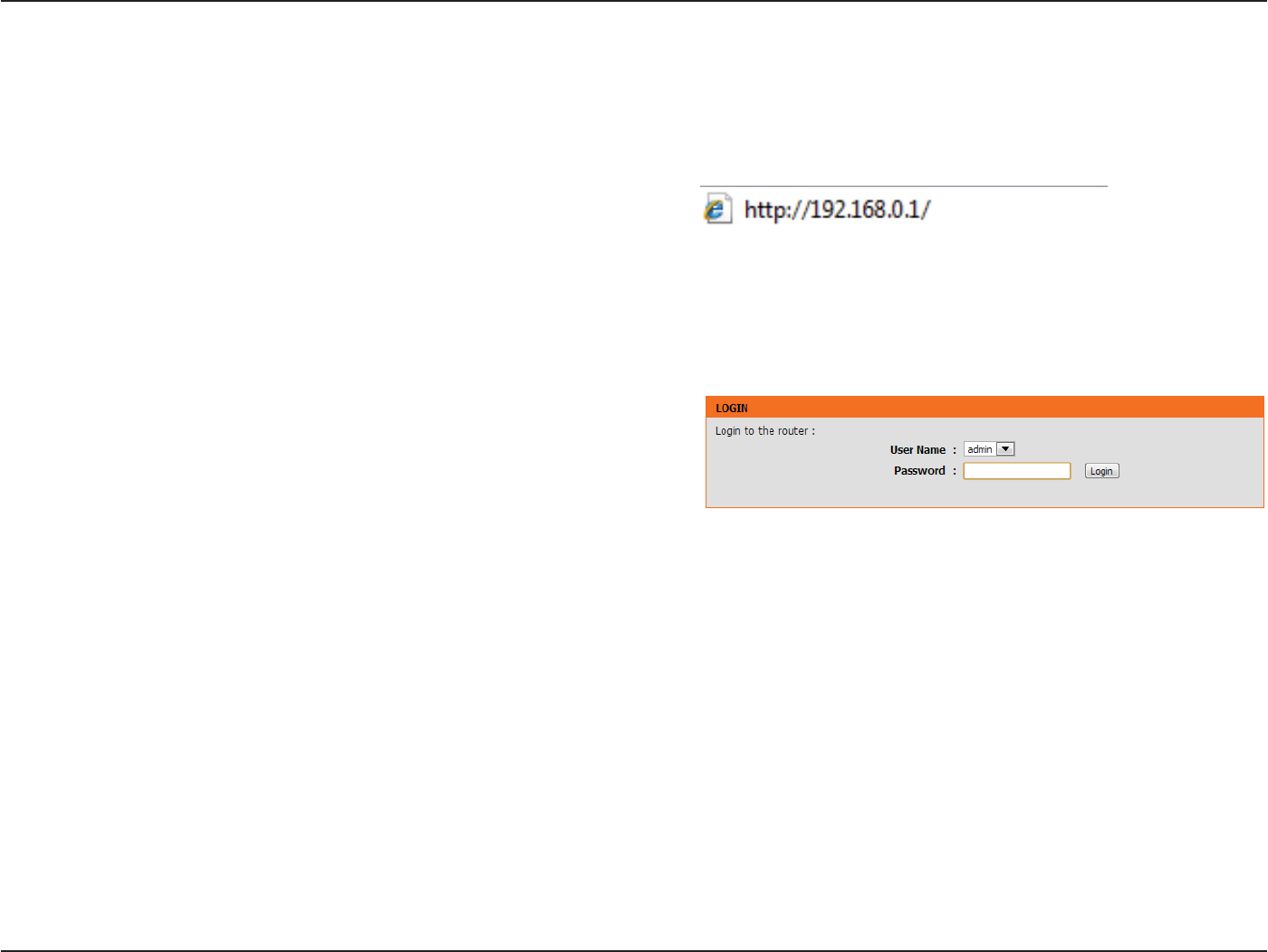
11D-Link DIR-516 User Manual
Section 2 - Setting Up With a Web Browser - Router Mode
This section will show you how to congure your new D-Link wireless router using the web-based conguration utility.
To access the conguration utility, open a web-browser such
as Internet Explorer and enter the IP address of the router
(192.168.0.1).
Enter admin in the User Name eld. By default, the password
should be left blank.
If you get a Page Cannot be Displayed error, please refer to the
Troubleshooting section for assistance.
Router Mode
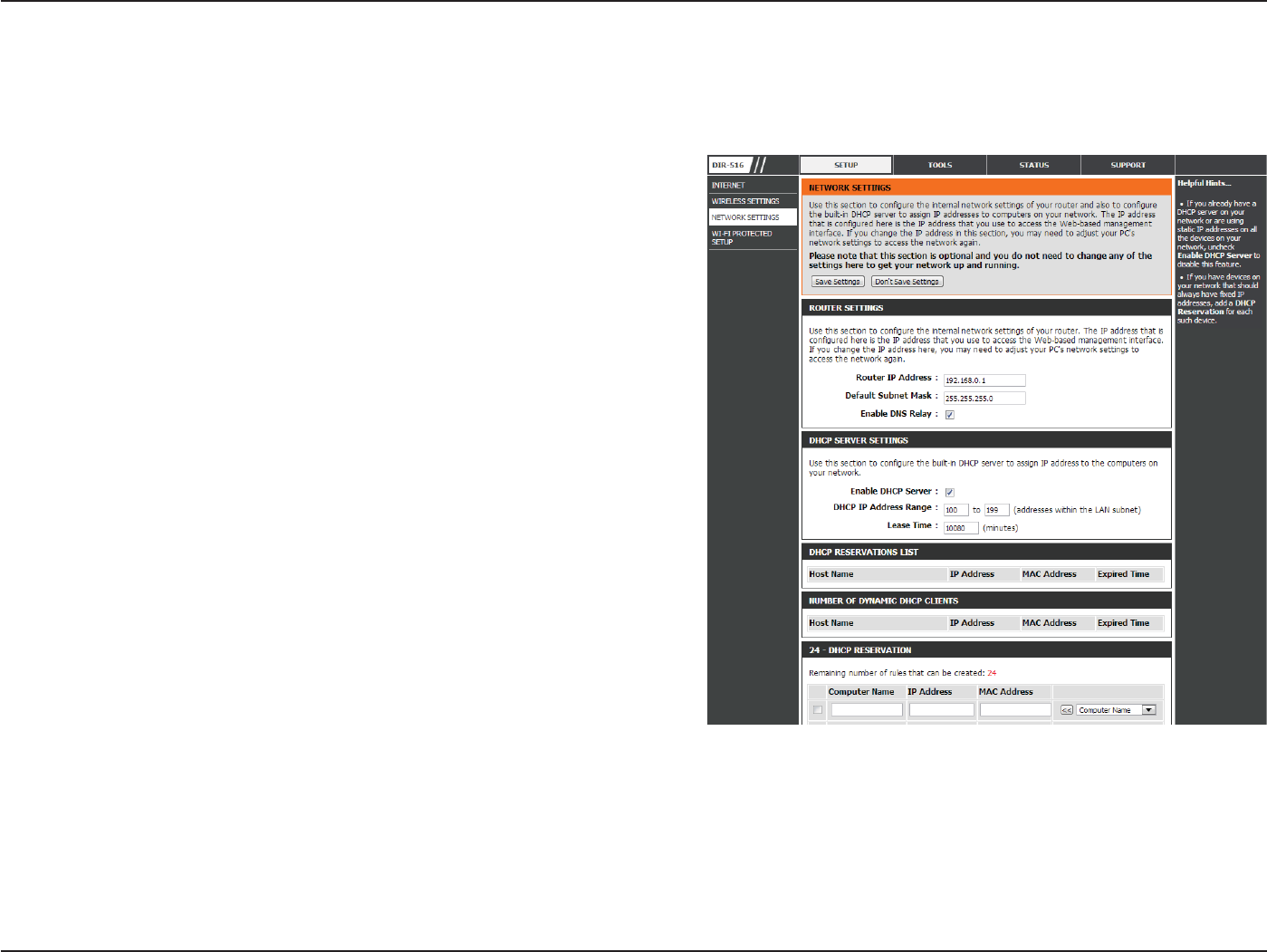
12D-Link DIR-516 User Manual
Section 2 - Setting Up With a Web Browser - Router Mode
This section will allow you to change the local network settings of the router and to congure the DHCP settings.
Network Settings
Use this section to congure the router’s local network
settings.
Use this section to congure the DIR-516’s built-in DHCP
server settings.
Use this section to add a new DHCP Static IP conguration.
Displays information about the devices that have a static
DHCP assigned from the DIR-516. The information includes
the IP Address and MAC Address. You can delete or edit an
existing static IP conguration in the table.
LAN Interface:
DHCP Server
Settings:
DHCP Static IP
Conguration:
DHCP Static IP
Table:

13D-Link DIR-516 User Manual
Section 2 - Setting Up With a Web Browser - Router Mode
Enter the IP address of the router. The default IP address is
192.168.0.1.
If you change the IP address, once you click Apply, you will
need to enter the new IP address in your browser to get back
into the conguration utility.
Enter the subnet mask. The default subnet mask is
255.255.255.0.
IP Address:
Subnet Mask:
Click the Apply Changes button to save any changes made.
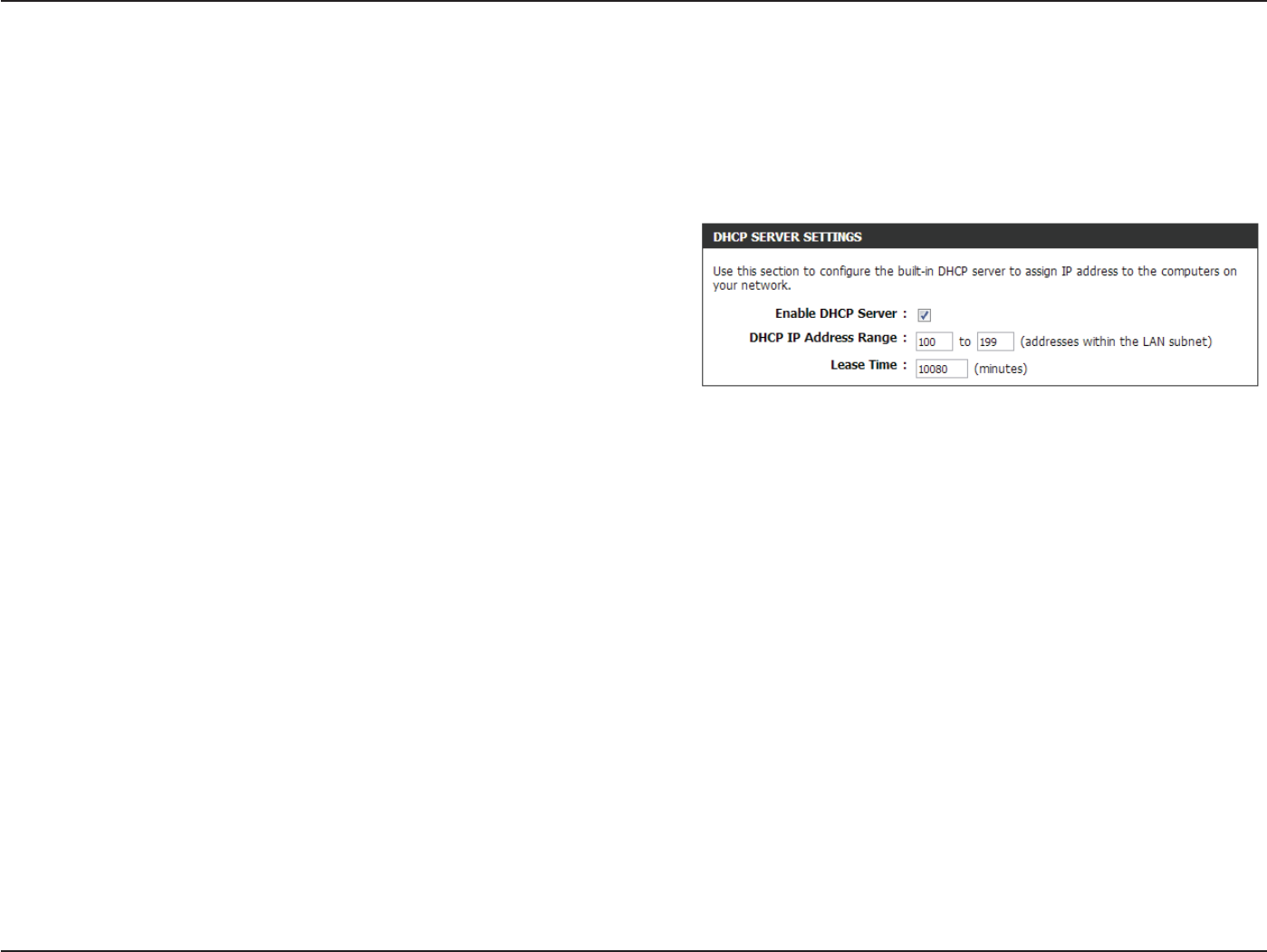
14D-Link DIR-516 User Manual
Section 2 - Setting Up With a Web Browser - Router Mode
DHCP stands for Dynamic Host Control Protocol. The DIR-516 has a built-in DHCP server. The DHCP Server will automatically
assign an IP address to the computers on the LAN/private network. Be sure to set your computers to be DHCP clients by setting
their TCP/IP settings to “Obtain an IP Address Automatically.” When you turn your computers on, they will automatically load
the proper TCP/IP settings provided by the DIR-516. The DHCP Server will automatically allocate an unused IP address from
the IP address pool to the requesting computer. You must specify the starting and ending address of the IP address pool.
Enable the DHCP Server option in the pulldown menu to
enable the DHCP server on your router. Choose None to
disable this function.
Enter the starting and ending IP addresses for the DHCP
server’s IP assignment.
Note: If you statically (manually) assign IP addresses to your
computers or devices, make sure the IP addresses are outside
of this range or you may have an IP conict.
The maximum length of time for the IP address lease. Enter
the Lease time in minutes.
Enter the IP address of the rst DNS Server.
Enter the IP address of the second DNS Server, if there is one.
DHCP Server:
DHCP IP
Address Range:
Lease Time:
DNS Server 1:
DNS Server 2:
When you have finished configuring the new DHCP Server
Settings, click the Save Setting button.
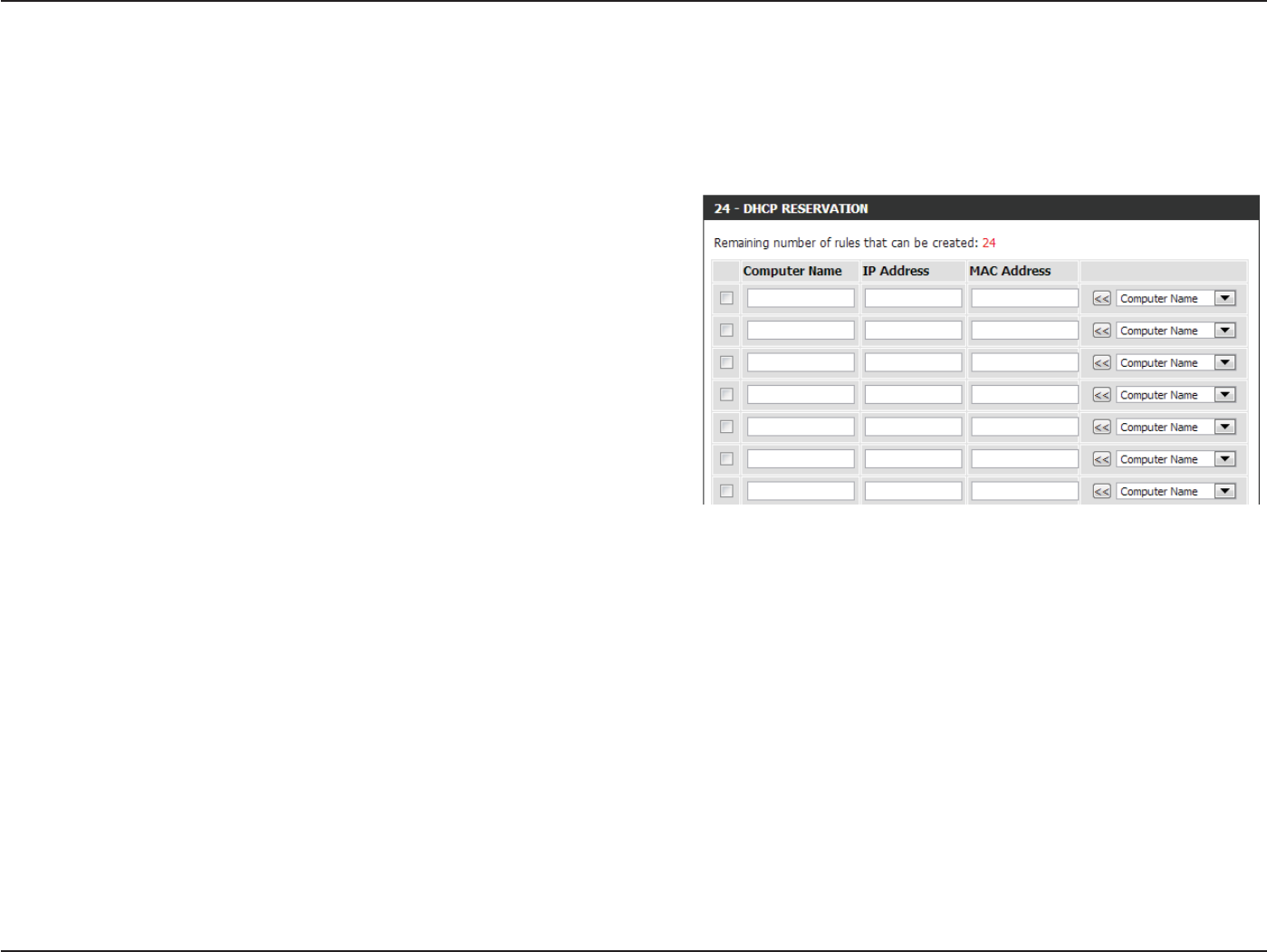
15D-Link DIR-516 User Manual
Section 2 - Setting Up With a Web Browser - Router Mode
If you want a computer or device to always have the same IP address assigned, you can create a DHCP reservation. The router
will assign the IP address only to that computer or device.
Note: This IP address must be within the DHCP IP address range.
Enter the IP address you want to assign to the computer or
device. This IP address must be within the DHCP IP address
range.
Enter the MAC address of the computer or device.
IP Address:
MAC Address:
When you have nished conguring the new DHCP reservation,
click the Add button to activate your reservation. It will then be
displayed in the DHCP Static IP Table below.
The DHCP Static IP Table displays the IP reservations that have
been created. To make any changes, select a reservation in the
table by clicking the circle next to it and click Update. To delete
a reservation, select a reservation and click Delete Selected.
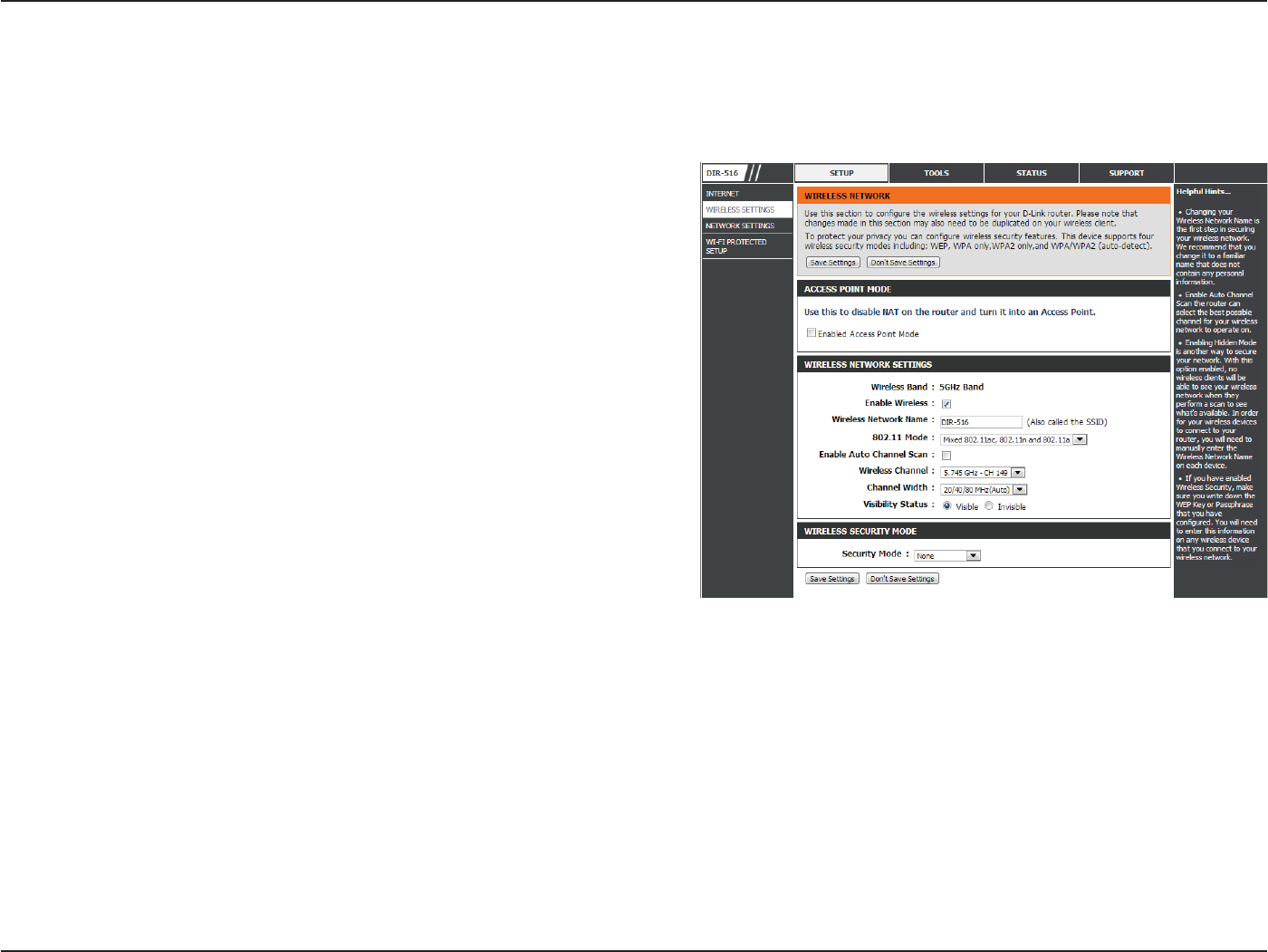
16D-Link DIR-516 User Manual
Section 2 - Setting Up With a Web Browser - Router Mode
Internet Setup
This section allows you to manually congure your router’s Internet WAN settings.
Select the WAN interface type.
If you choose DHCP, please congure the following
elds:
Enter the host name of the router.
Enter the MTU size.
Click this if the DNS is to be obtained automatically.
Click this to specify a DNS server. You can enter up to two
DNS servers.
Select the MAC address to be used for the connection.
Select Default MAC to use the router’s MAC address. Select
MAC from PC to copy your PC’s MAC address, or select
MAC Manual to manually enter a MAC address in the eld
provided.
WAN Access
Type:
Host Name:
MTU Size:
Attain DNS
Automatically:
Set DNS
Manually:
MAC Clone
When you have nished conguring the WAN settings, click the
Save Settings button.
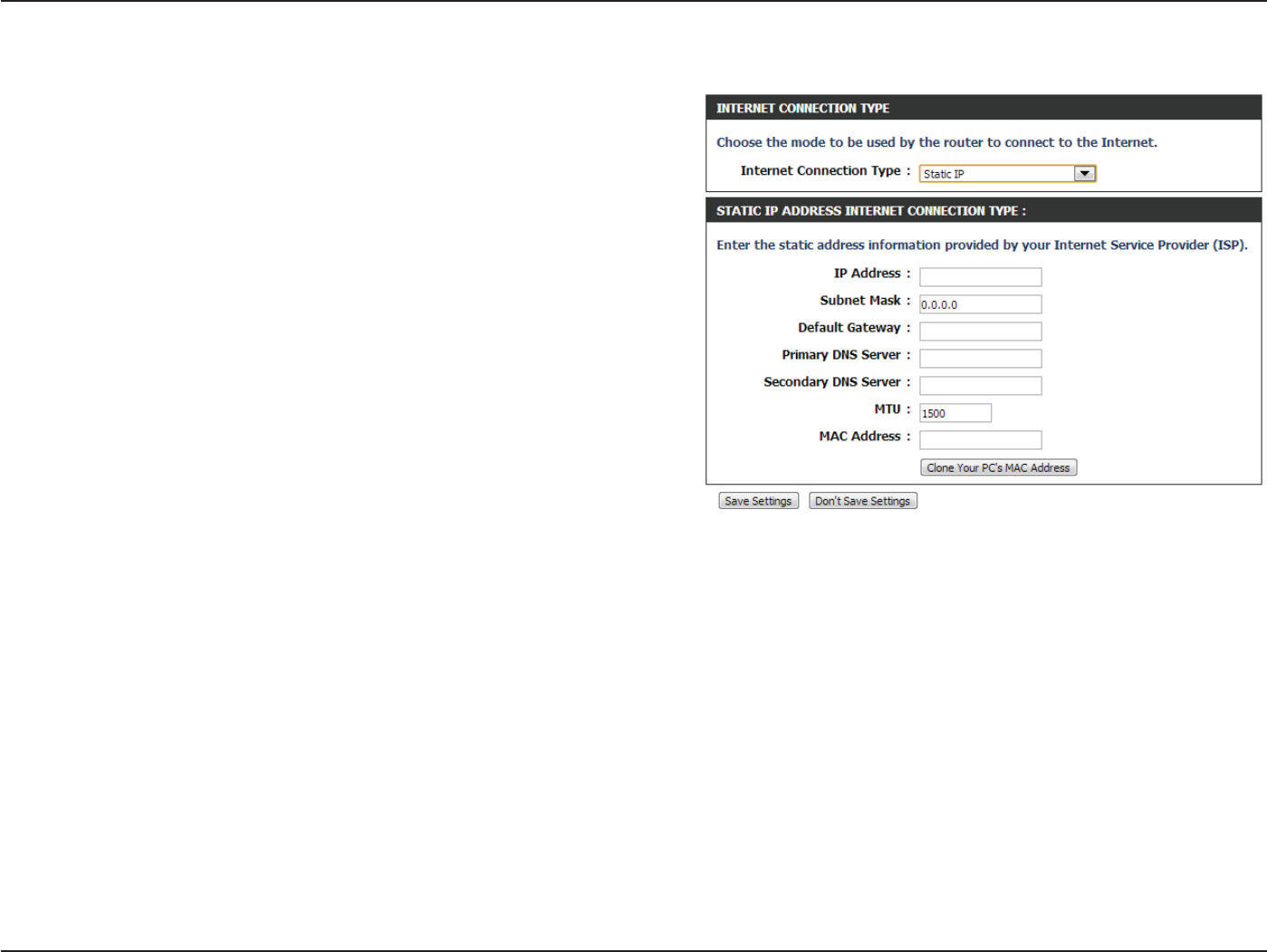
17D-Link DIR-516 User Manual
Section 2 - Setting Up With a Web Browser - Router Mode
Select Static IP from the drop-down menu.
Enter the static IP address which was provided to you by
your Internet Service Provider (ISP).
Enter the subnet provided by your ISP.
Enter the default gateway provided by your ISP.
Enter the Maximum Transmission Unit size. The default value
is 1500.
Enter the primary DNS server address provided by your ISP.
Enter the secondary DNS server address provided by your ISP.
Select the MAC address to be used for the connection.
Select Default MAC to use the router’s MAC address. Select
MAC from PC to copy your PC’s MAC address, or select
MAC Manual to manually enter a MAC address in the eld
provided.
Click Save Settings to save the current conguration, or
click Don’t Save Settings to discard.
WAN Access
Type:
IP Address:
Subnet Mask:
Default
Gateway:
MTU Size:
DNS Server 1:
DNS Server 2:
MAC Clone:
If you choose Static IP, please congure the following elds;
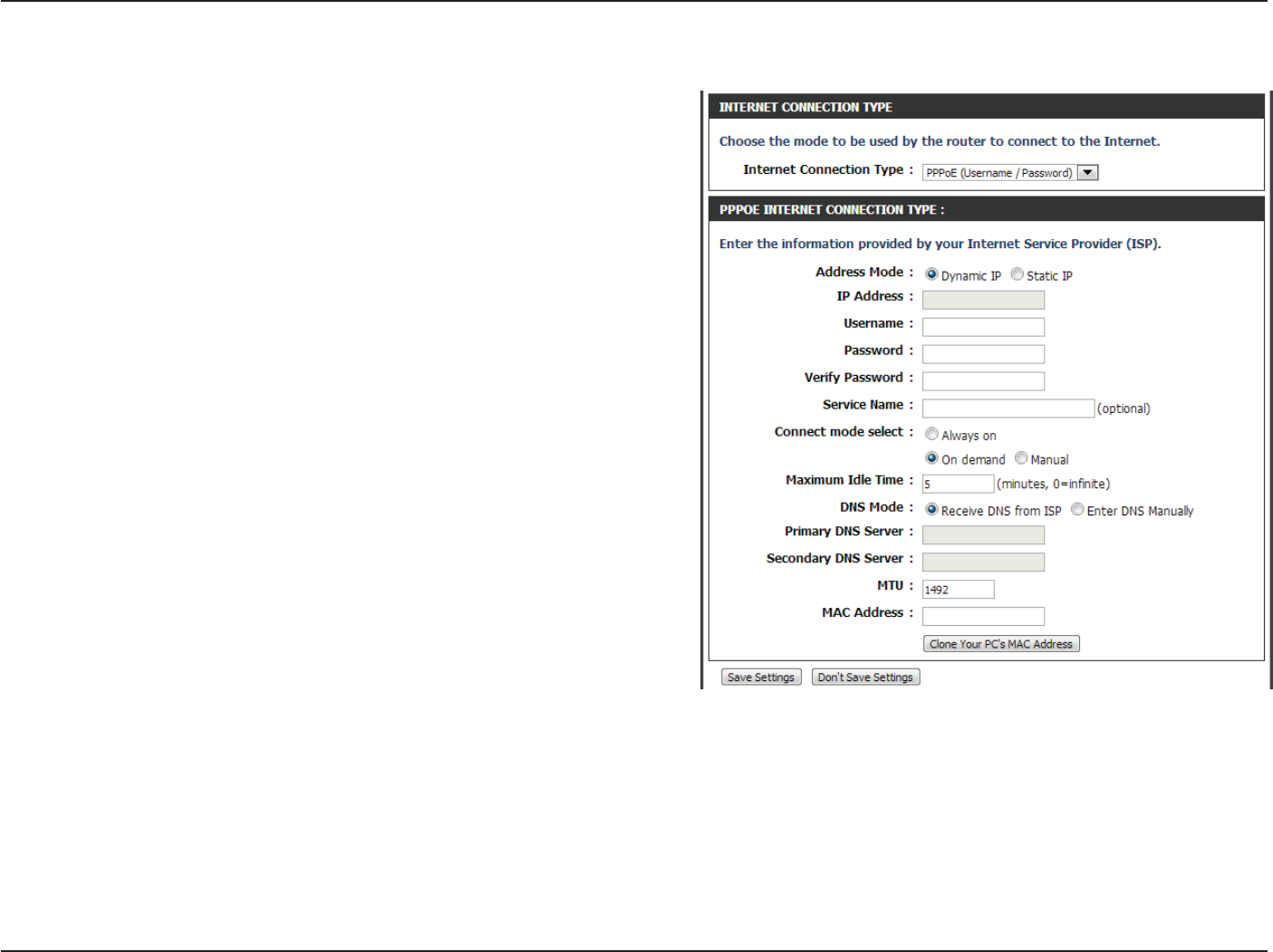
18D-Link DIR-516 User Manual
Section 2 - Setting Up With a Web Browser - Router Mode
If you choose PPPoE, please congure the following elds:
When you have nished conguring the WAN settings, click the
Save Settings button.
Select PPPoE from the drop-down menu.
Enter the user name provided to you by your ISP.
Enter the password provided to you by your ISP.
Enter the service name if your ISP provided you with one,
otherwise leave this eld empty.
Enter the Maximum Transmission Unit size. The default value
is 1492.
If your ISP or network administrator requires you to have a
static IP address for your connection, enter it here.
Select Continuous, Connect on Demand, or Manual as
the connection type from the drop-down menu. If you
select Manual, the connect and disconnect buttons will be
available.
Click this if the DNS is to be obtained automatically.
Click this to specify a DNS server. You can enter up to two
DNS servers.
Select the MAC address to be used for the connection.
Select Default MAC to use the router’s MAC address. Select
MAC from PC to copy your PC’s MAC address, or select
MAC Manual to manually enter a MAC address in the eld
provided.
WAN Access
Type:
User Name:
Password:
Service Name:
MTU Size:
Static IP
Address:
Connection
Type:
Attain DNS
Automatically:
Set DNS
Manually:
MAC Clone:
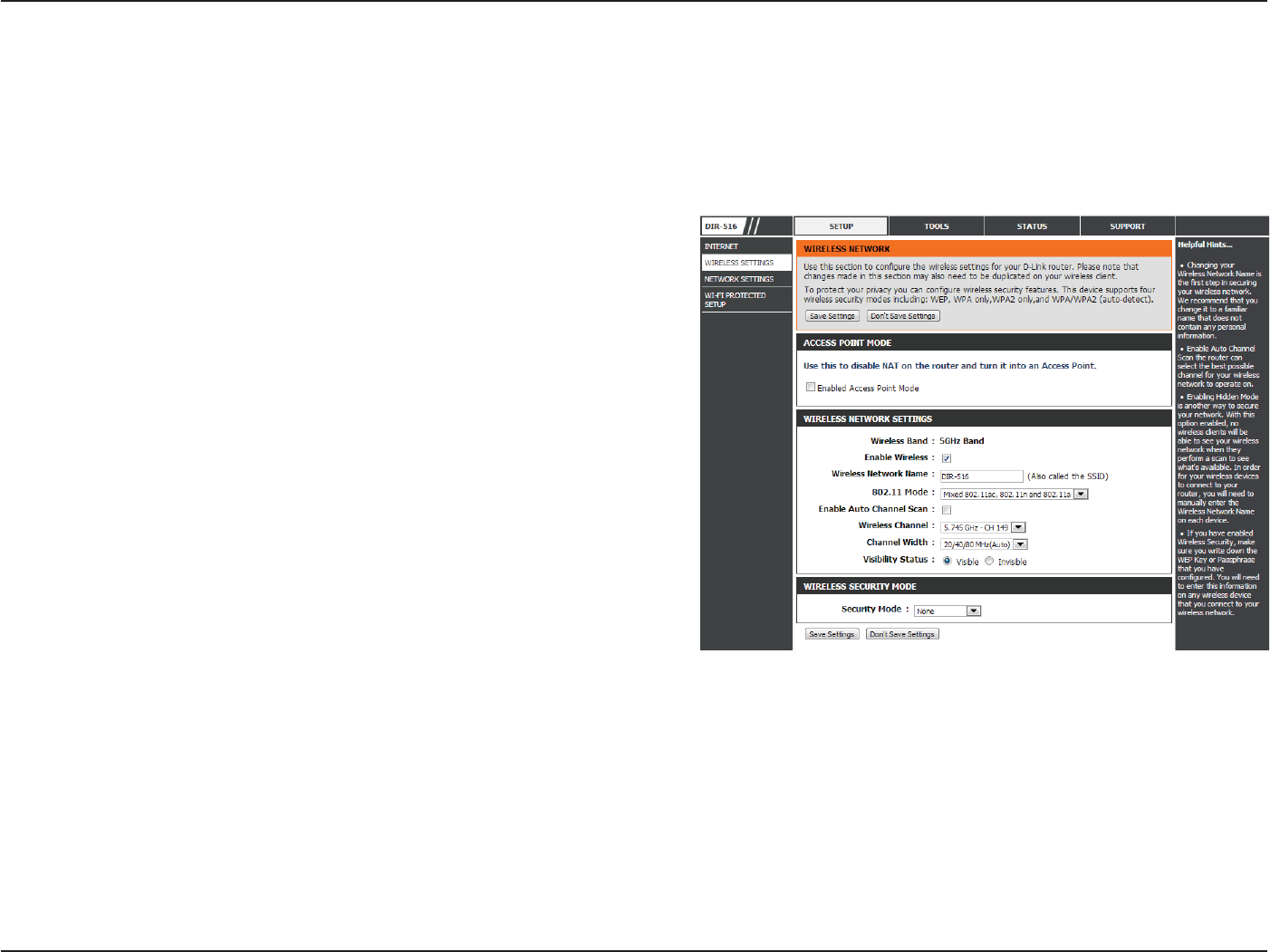
19D-Link DIR-516 User Manual
Section 2 - Setting Up With a Web Browser - Router Mode
• Wireless Settings
Wireless
Use this to disable NAT on the router and turn it into an
Access Point.
Enable SSID broadcast if you want the router to transmit its
SSID publicly so other wireless devices can discover it.
Enter the SSID name you want to use for your wireless
network.
Use the dropdown menu to specify the wireless mode.
Use the dropdown menu to select the wireless channel.
Use the dropdown menu to select the channel bandwidth.
If you selected the 802.11ac, 802.11n, 802.11 b/g, or 802.11
b/g/n wireless modes, the available options are 20 MHz and
20/40 MHz. 20/40/80MHz(Auto) For the others, 20 MHz is
the only option.
Select a wireless security encryption option. You can also
choose to not use one by selecting None, but this is not
recommended.
Enabled Access
Point Mode:
Enable Wireless:
Name (SSID):
Mode:
Channel:
Band Width:
Security
Options:
T
his page allows you to congure the wireless LAN settings. You can also congure the wireless encryption and wireless network
parameters.
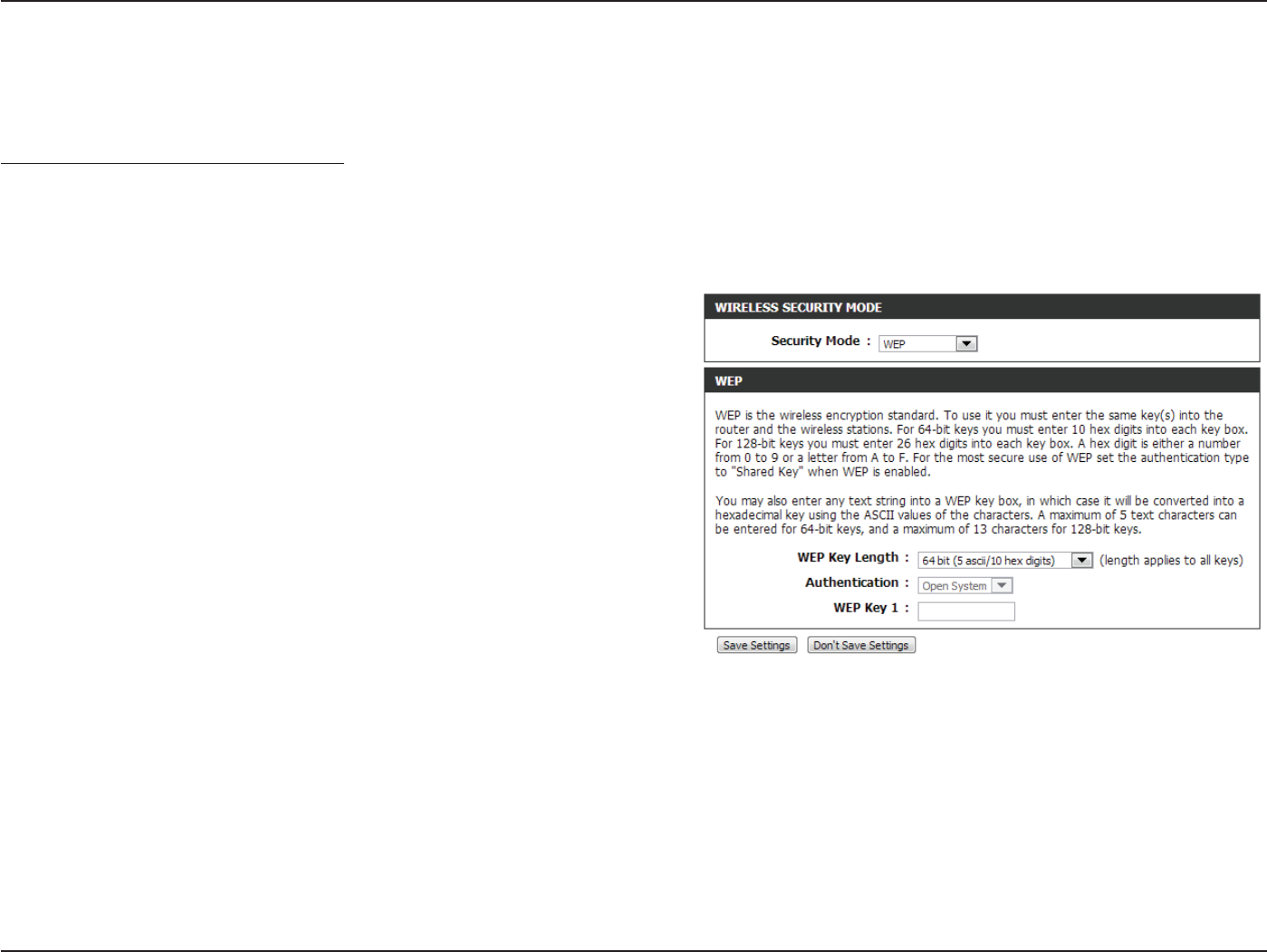
20D-Link DIR-516 User Manual
Section 2 - Setting Up With a Web Browser - Router Mode
Wireless security helps to prevent unauthorized users from accessing your wireless network, or seeing data being passed
between the router and wireless clients. The DIR-516 supports two popular wireless security protocols, you should select a
protocol based on the wireless clients which will be accessing your network.
Wired Equivalent Privacy (WEP)
This is an older form of wireless security and should only be used if your wireless clients do not support the newer WPA or
WPA2 protocols.
Select WEP from the drop-down menu.
Select either Automatic or Shared Key as the
authentication type.
Select the encryption strength from the drop-down
menu. 64-bit - A 64-bit key comprises a string of 10
hexadecimal characters, or 5 ASCII characters.
128-bit - A 128-bit key comprises a string of 26
hexadecimal characters, or 13 ASCII characters.
You can predetermine up to 4 WEP keys. Select the WEP
key you wish to use by clicking on the radio buttons next
to the keys. Select whether you wish to use HEX or ASCII
characters in your key using the drop-down menu. Enter
the desired key in the eld provided.
Click Apply to save the current settings.
Security
Options:
Authentication
Type:
Encryption
Strength:
Key 1-4:
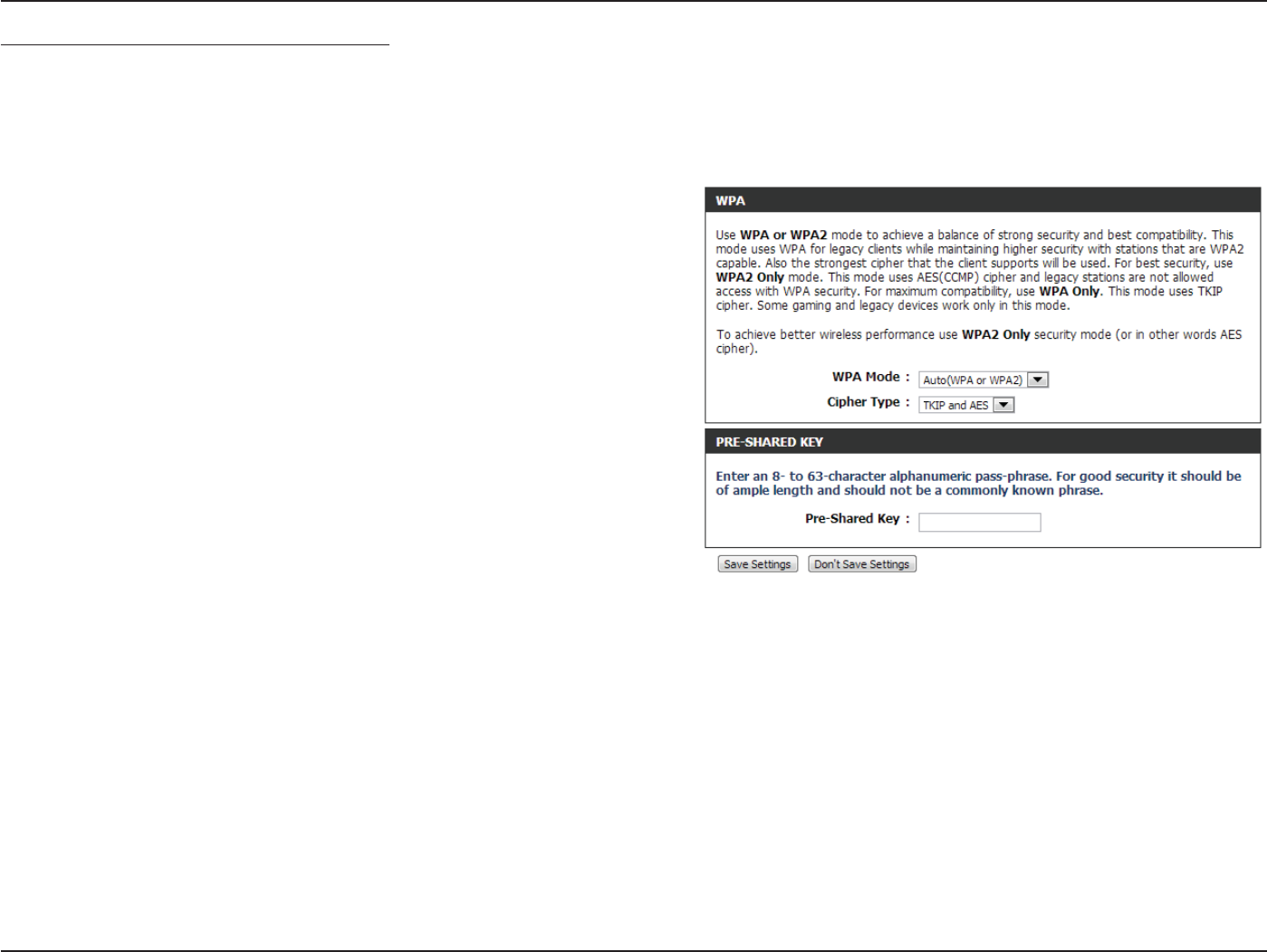
21D-Link DIR-516 User Manual
Section 2 - Setting Up With a Web Browser - Router Mode
Wi-Fi Protected Access (WPA/WPA2)
This is a newer and more secure protocol for wireless security. It uses a cipher combined with a pre-shared key (password) to
encrypt data being sent over the wireless network. It is recommended that you use this security method if it is supported by
your wireless clients.
Select WPA-PSK/WPA2-PSK AES from the drop-down
menu.
Enter a pre-shared key (password) to secure your wireless
network. Wireless clients will require this password in
order to connect to your network. It is recommended that
you make a record of this password for future reference.
Click Save Settings to save the current settings.
Security
Options:
Pre-Shared Key:
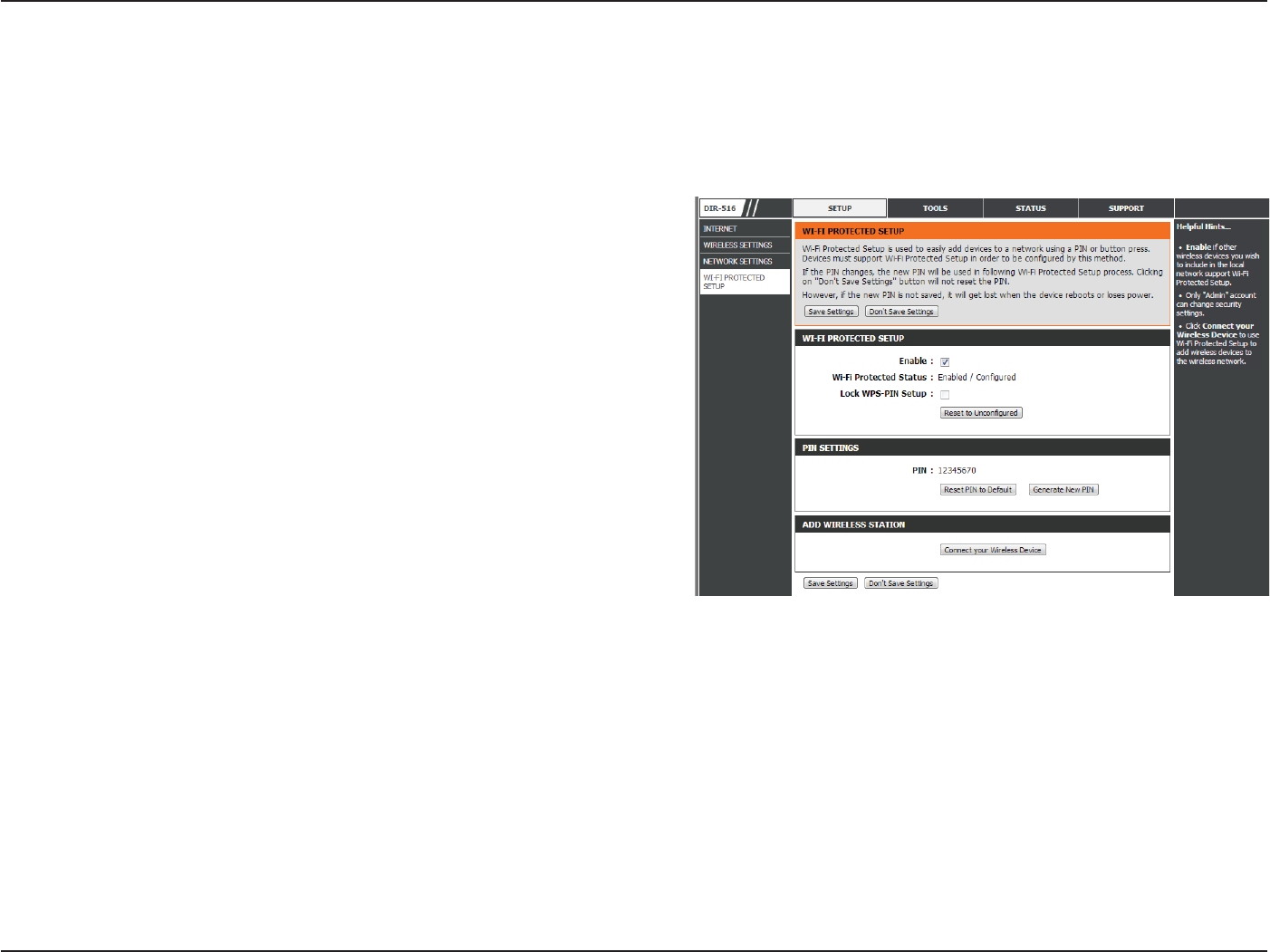
22D-Link DIR-516 User Manual
Section 2 - Setting Up With a Web Browser - Router Mode
Wi-Fi Protected (WPS) Setup
Wi-Fi Protected Setup (WPS) System is a simplied method for securely connecting new devices to your network. The process
as easy as pressing a button (the Push-Button Connection method) or correctly entering the 8-digit code (the PIN method).
If you wish to use the Push-Button Connection (PBC) method, simply press
the WPS button on the side of the router. The power LED will begin to ash.
Within 120 seconds, press the WPS button on the device that you wish to
connect. The power LED will turn solid green if the connection is successful.
To connect using the PIN method, click Next to begin the WPS setup process.
Enter the PIN for the wireless NIC and click Start PIN. If successful, you will
then be taken to another screen and a message will tell you to run WPS in
the client device within 2 minutes.
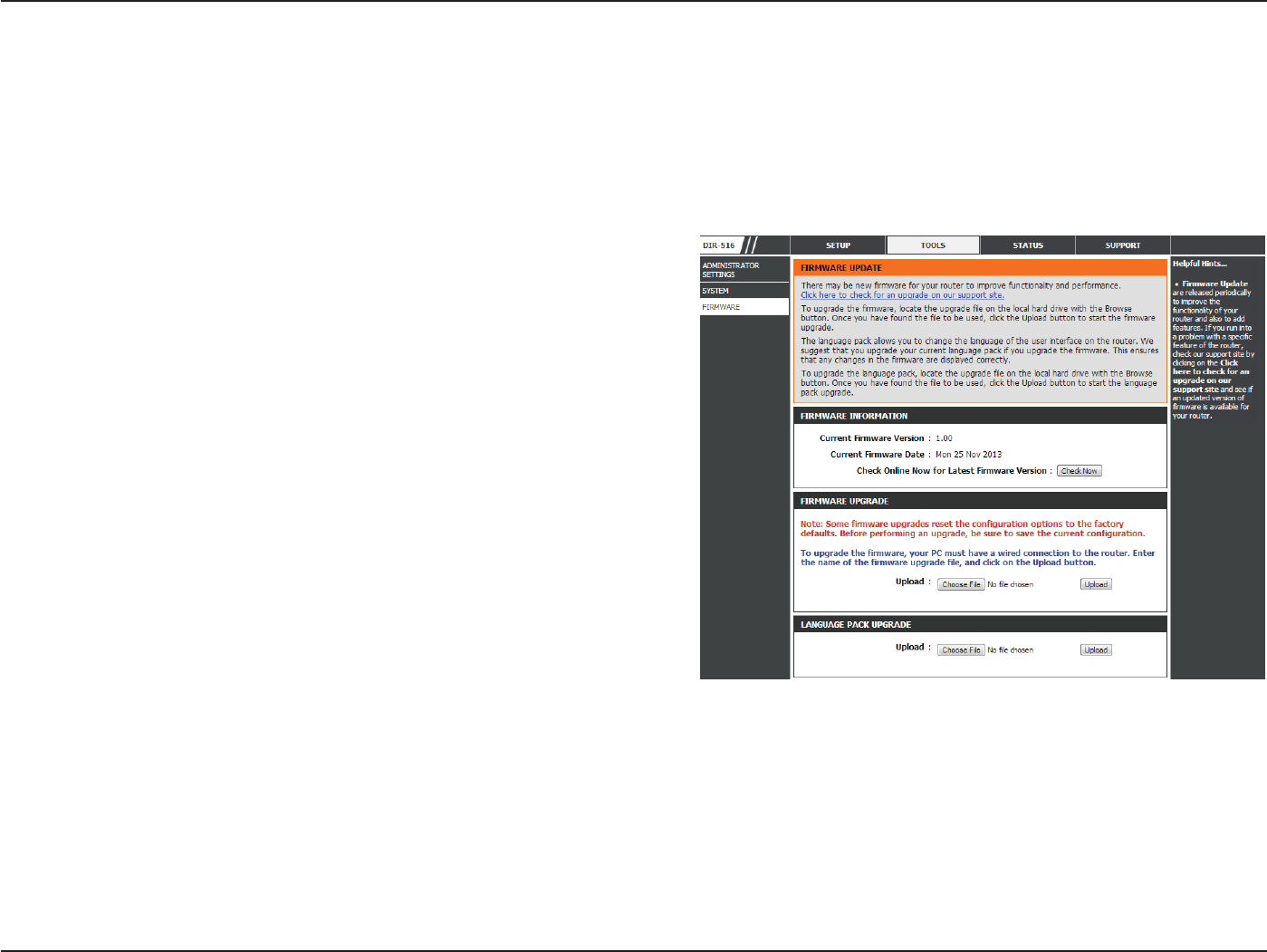
23D-Link DIR-516 User Manual
Section 2 - Setting Up With a Web Browser - Router Mode
Firmware
This page allows you to upgrade the rmware of the router. If you plan to install new rmware, make sure the rmware
you want to use is on the local hard drive of the computer. Please check the D-Link support site for rmware updates at
http://support.dlink.com. You can download rmware upgrades to your hard drive from the D-Link support site.
After you have downloaded the new rmware, click
Browse to locate the rmware update on your hard
drive.
If you want to reset the router’s settings to their default
values, then check the Automatically reset default after
rmware upgraded box.
Select File:
Click the Upload button to upload a le to the router after you
have selected it.
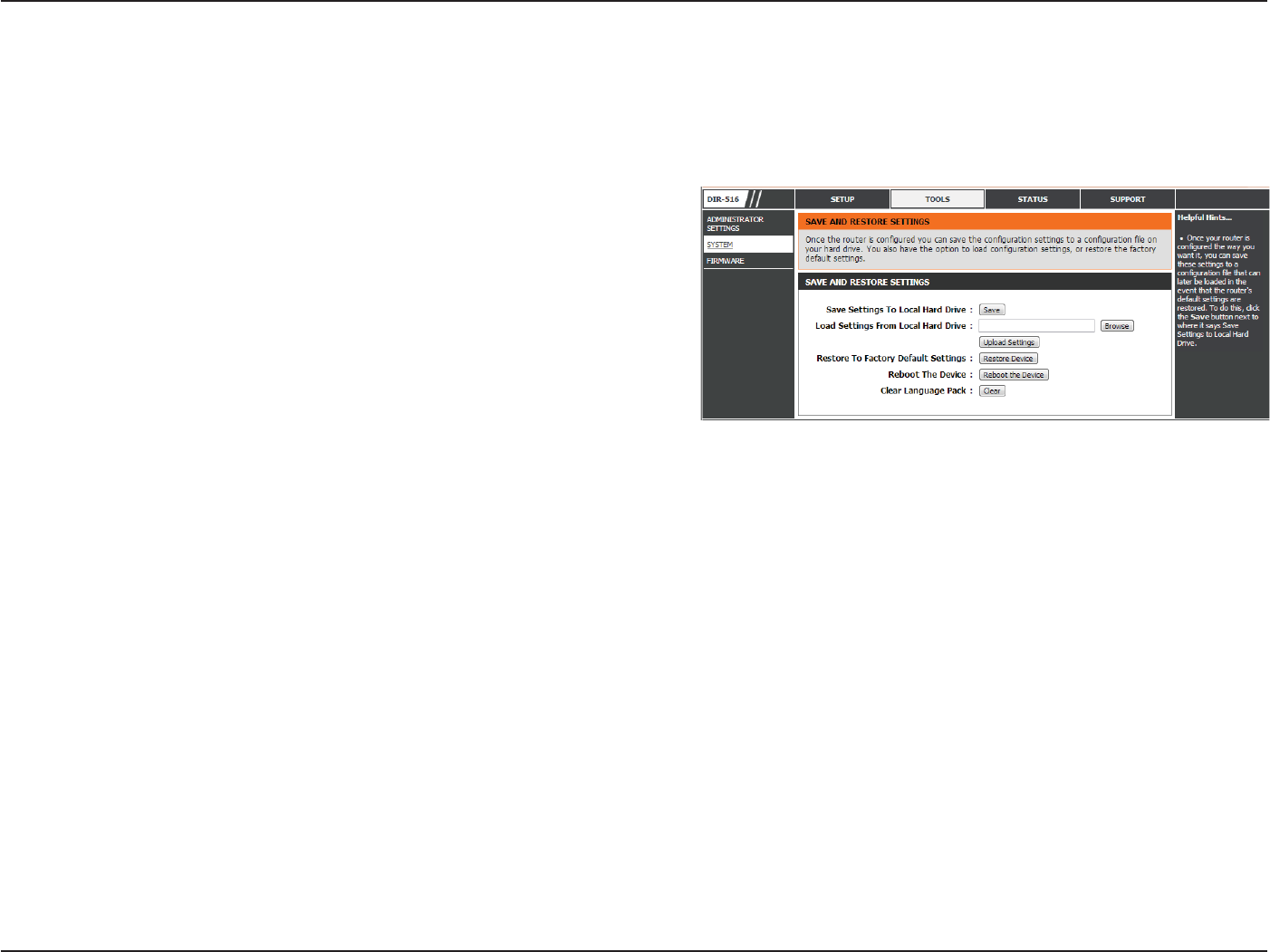
24D-Link DIR-516 User Manual
Section 2 - Setting Up With a Web Browser - Router Mode
System
This page allows you to save the router’s current conguration le onto your computer’s hard drive or load a saved le from
your hard drive.
Click the Save Settings to File button to download the current
conguration settings as a le onto your hard drive.
To load a previously saved settings le, click the Browse button to
locate the le on your hard drive, then click the Upload button.
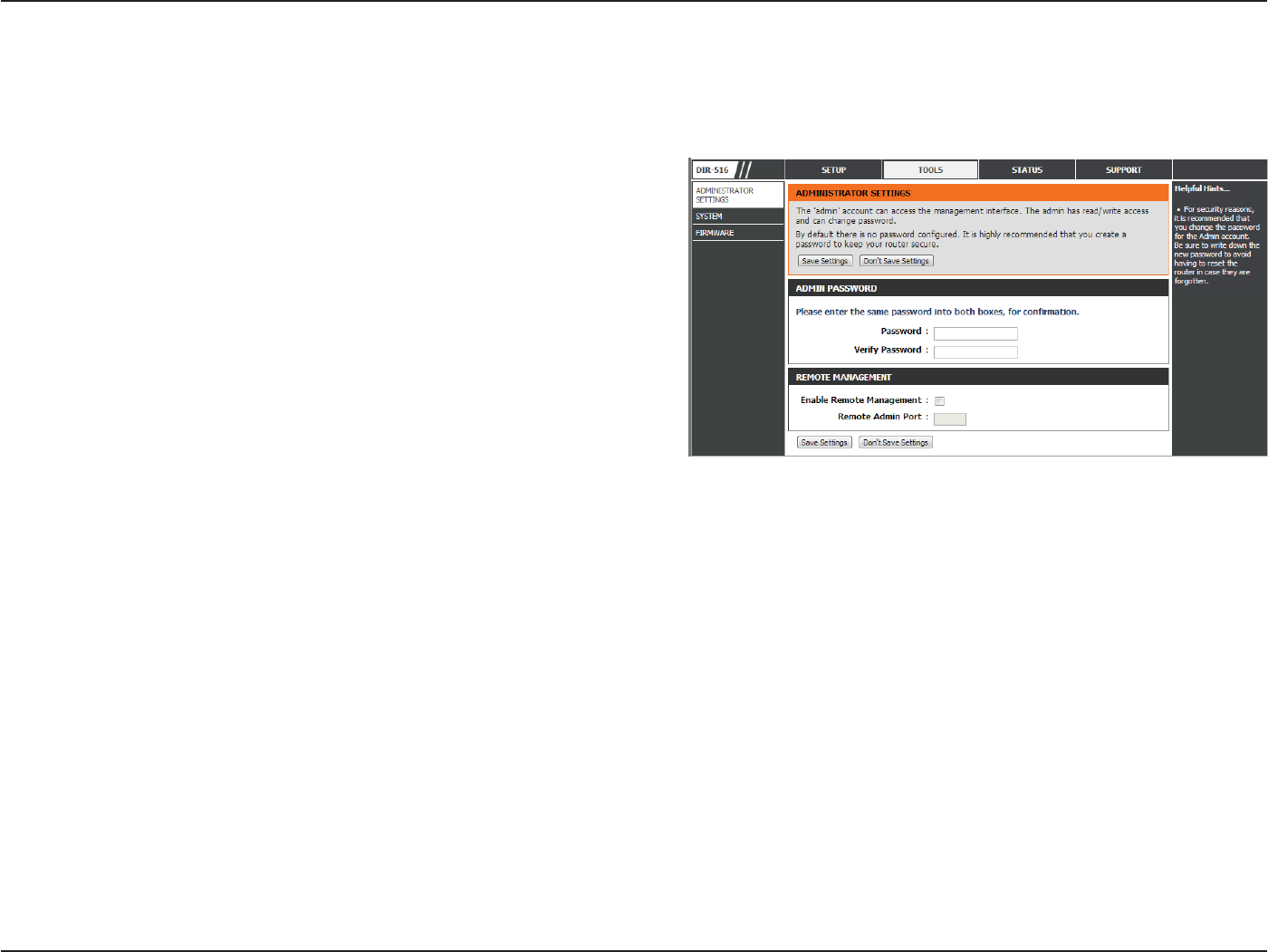
25D-Link DIR-516 User Manual
Section 2 - Setting Up With a Web Browser - Router Mode
Admin
Retype the new password.
Conrm
Password:
This page allows you to add a user account to the router’s web server. You can also delete or modify existing accounts.
To delete an existing account, click the Select tab next to the user
account in the table and then click the Delete button.
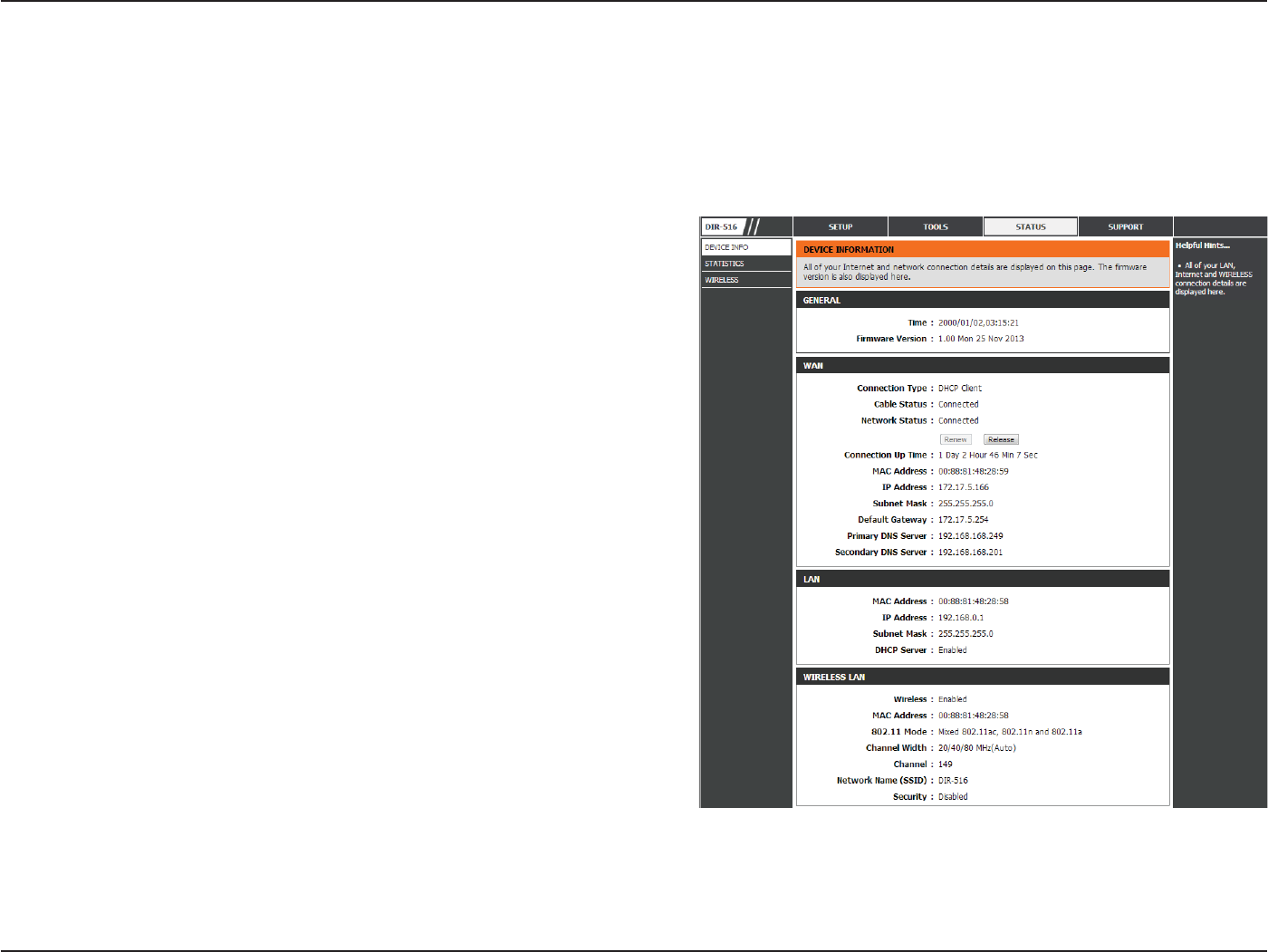
26D-Link DIR-516 User Manual
Section 2 - Setting Up With a Web Browser - Router Mode
Displays the router’s time and rmware version.
Displays the MAC address and the private (local) IP
settings for the router.
Displays the wireless MAC address and your wireless
settings such as SSID and Channel.
Displays the MAC address and the public IP settings for
the router.
System:
Device Info
T
his page displays the current status and basic settings of the router.
Status
LAN
Conguration:
WLAN
Conguration:
WAN
Conguration:
Click the Refresh button to view the most current information.
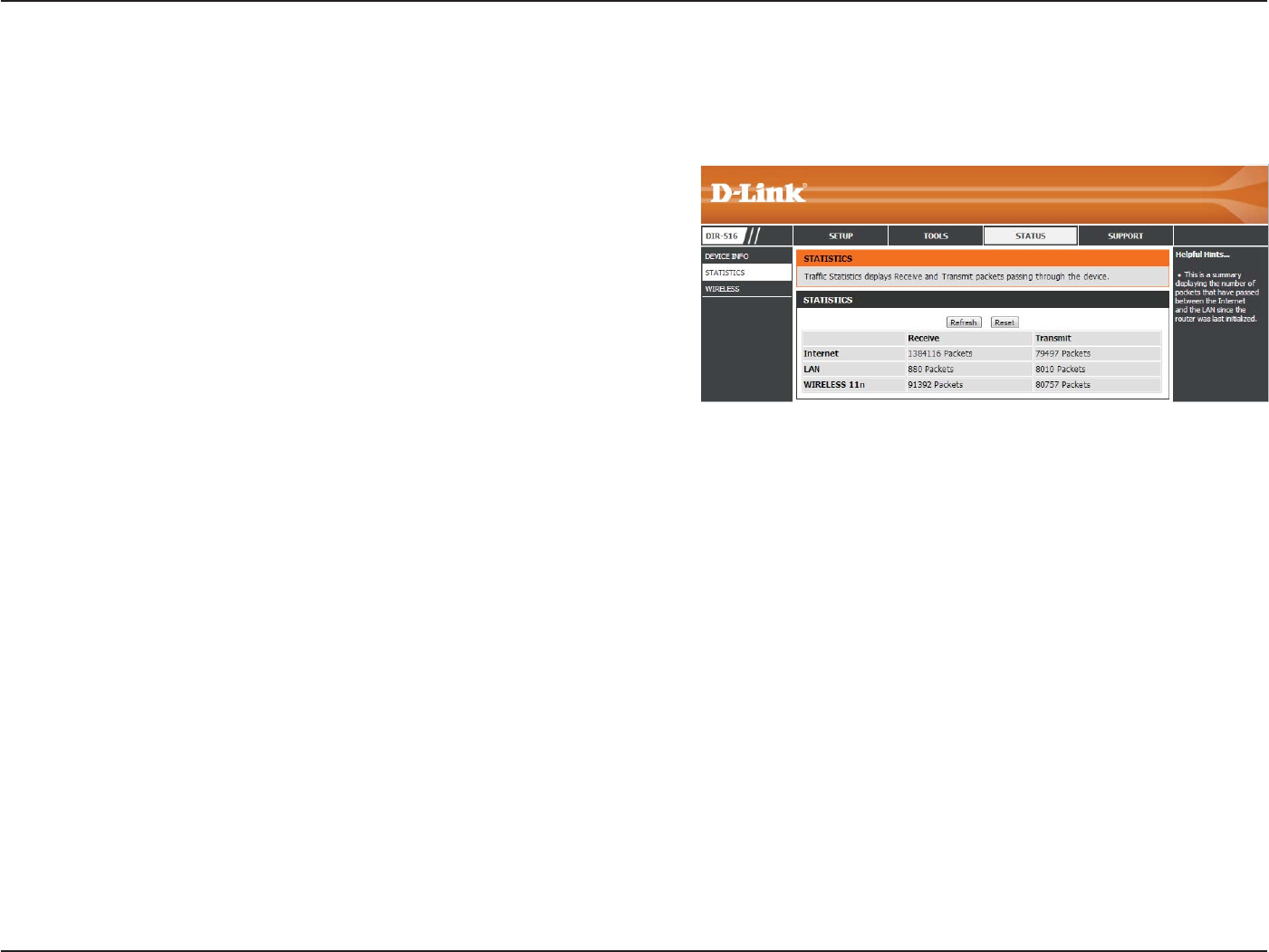
27D-Link DIR-516 User Manual
Section 2 - Setting Up With a Web Browser - Router Mode
Wireless
This table displays all active wired clients.
This table displays all active wireless clients.
Active Wired Client
Table:
Active Wireless
Client Table:
This page displays lists of all wired and wireless clients. The IP address and MAC address of each client is displayed in the tables.
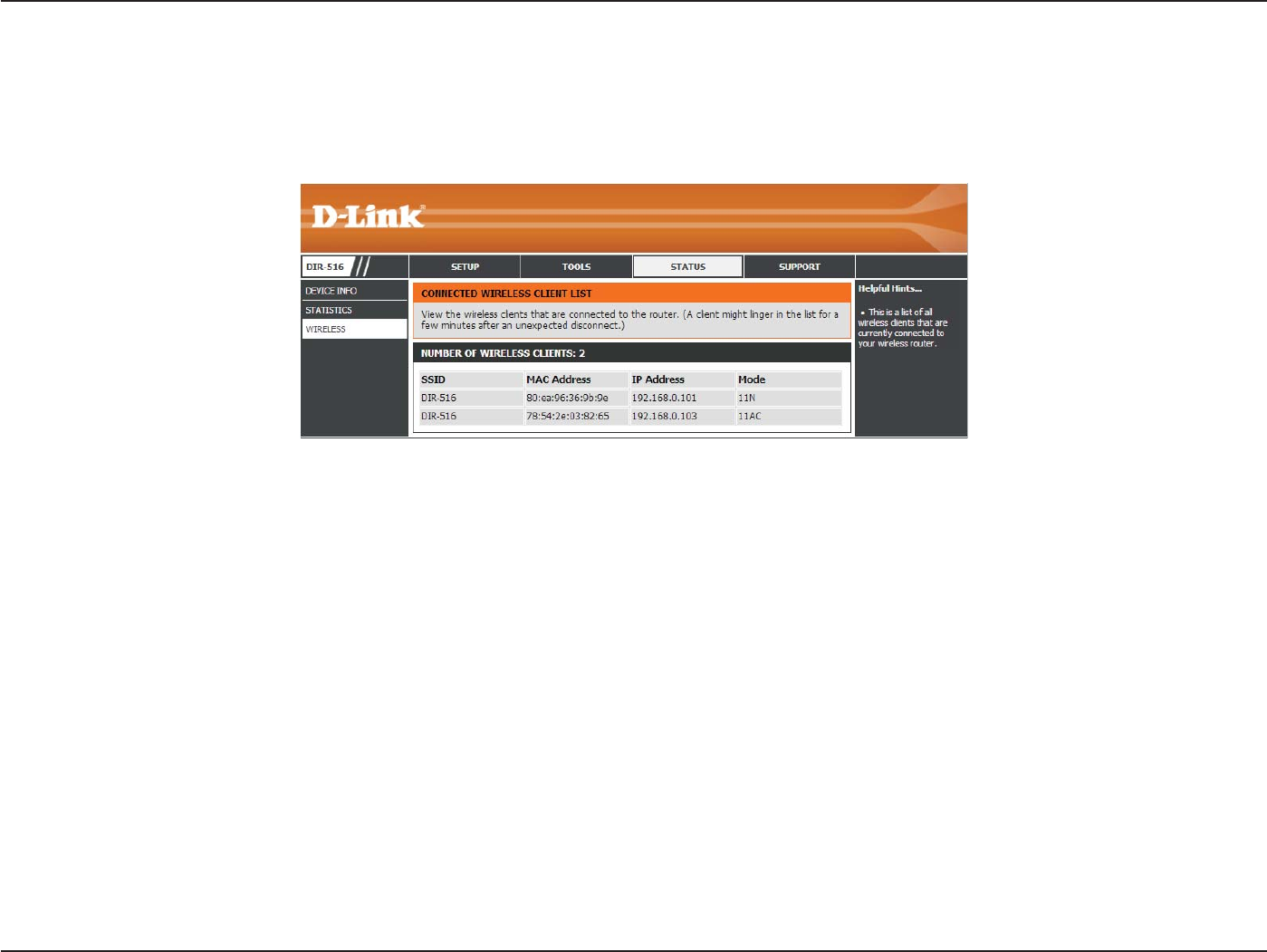
28D-Link DIR-516 User Manual
Section 2 - Setting Up With a Web Browser - Router Mode
Statistics
This page displays the statistics for packets that have been transmitted and received on the network on the router’s WAN and
LAN ports, and wireless bands.
Click the Refresh button to refresh the router’s trac statistics.
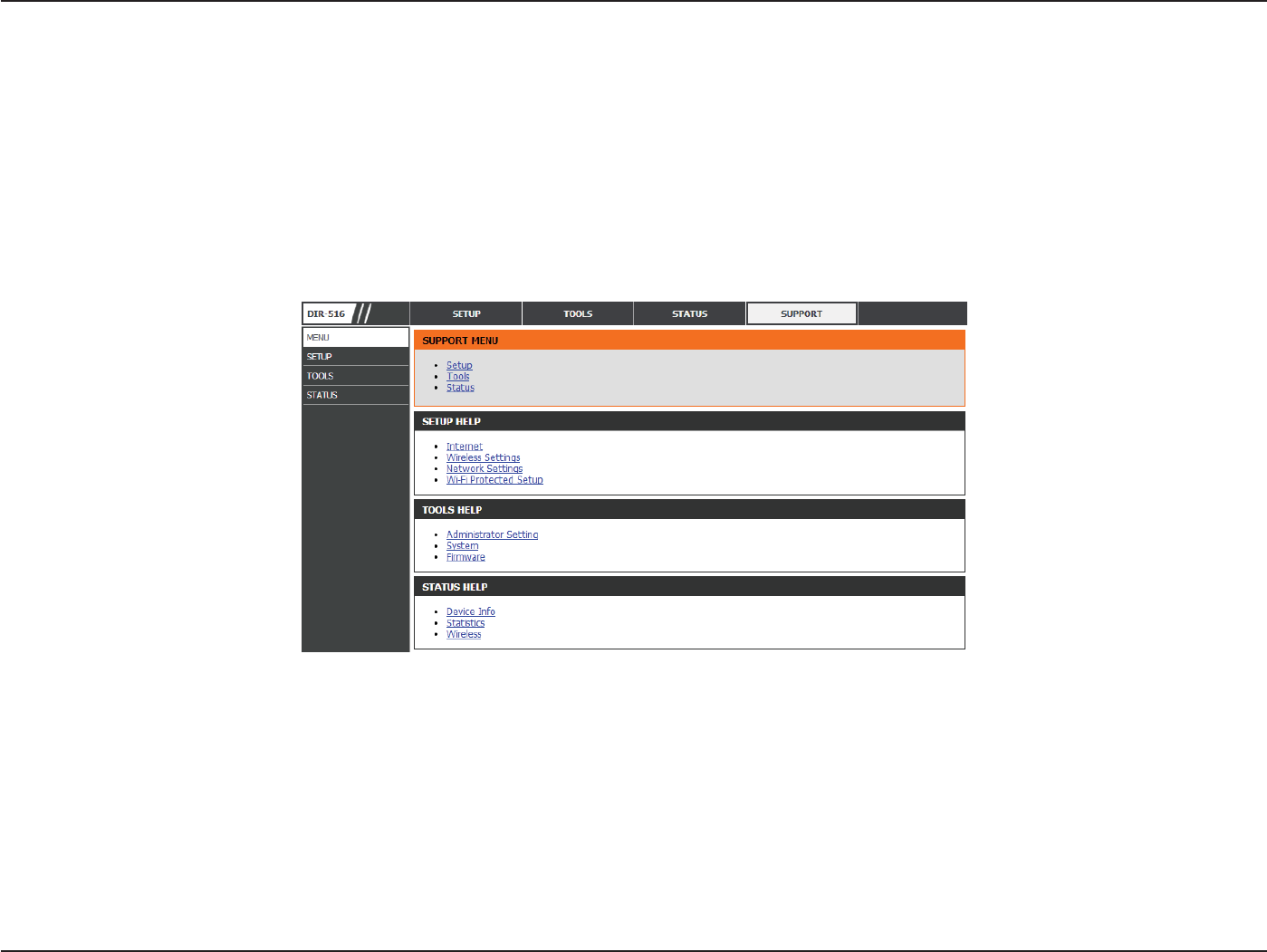
29D-Link DIR-516 User Manual
Section 2 - Setting Up With a Web Browser - Router Mode
Support
This section provides an explanation of each conguration or setting for the DIR-516. Click on the links to be taken to the help
text for that particular section of router’s setup.
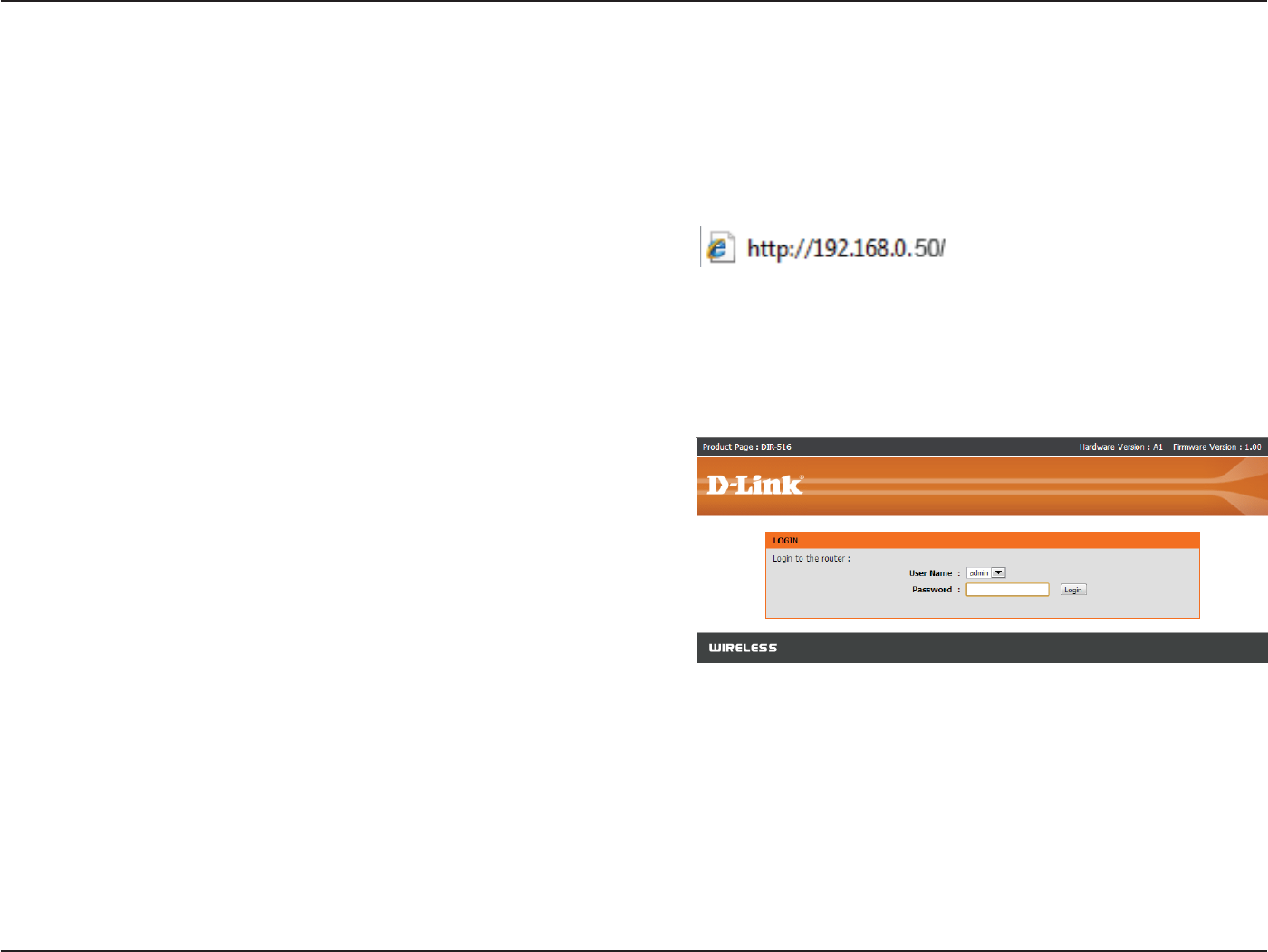
30D-Link DIR-516 User Manual
Section 2 - Setting Up With a Web Browser - Access Point Mode
This section will show you how to congure your new D-Link wireless router using the web-based conguration utility.
To access the conguration utility, open a web-browser such
as Internet Explorer and enter the IP address of the router
(192.168.0.50).
Enter admin in the User Name eld. Leave the password blank as
the default password.
If you get a Page Cannot be Displayed error, please refer to the
Troubleshooting section for assistance.
Manual Conguration
Access Point Mode
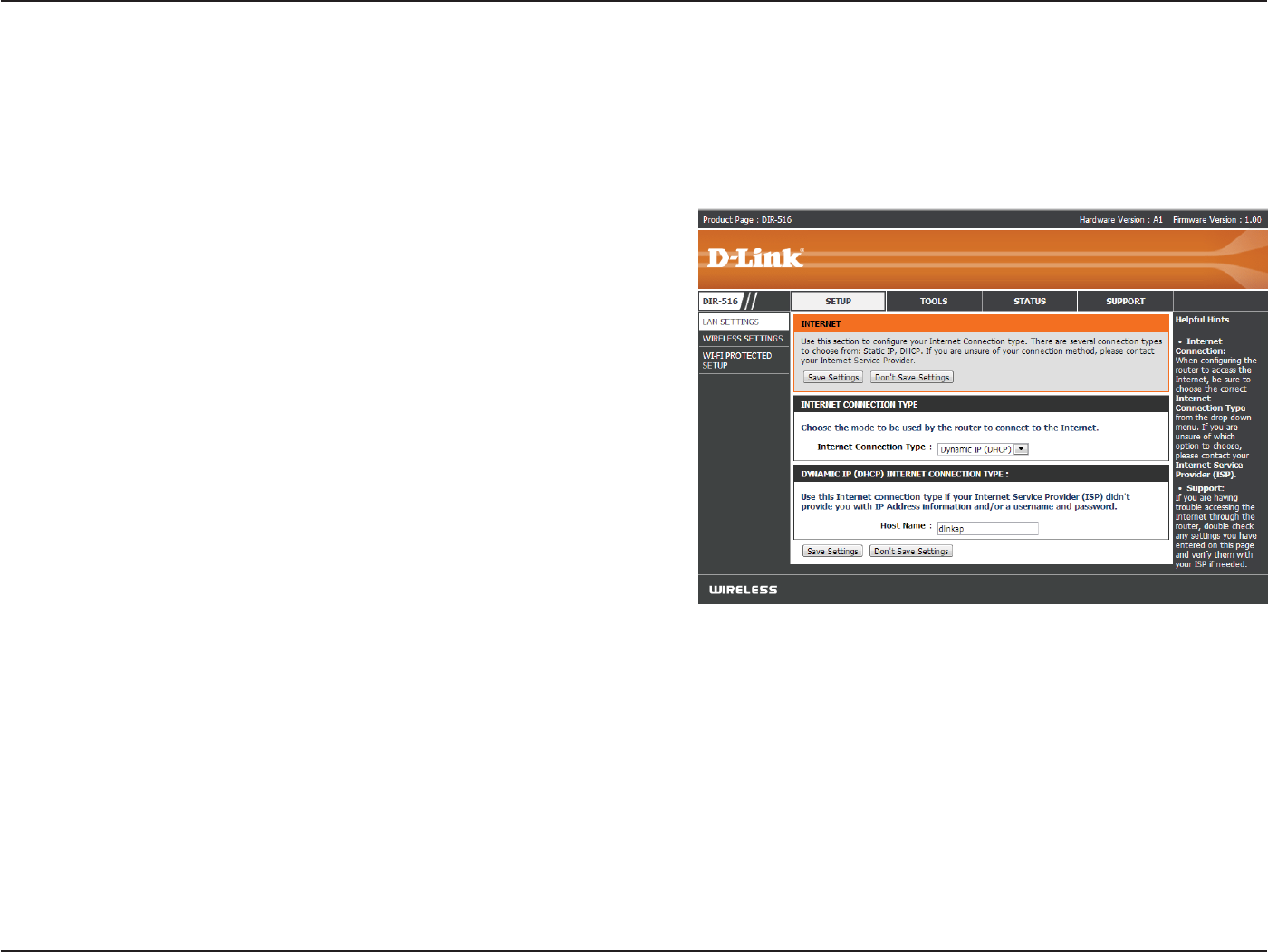
31D-Link DIR-516 User Manual
Section 2 - Setting Up With a Web Browser - Access Point Mode
This section will allow you to change the local network settings of the access point.
Local Network
Enter the IP address of the access point.
Enter the subnet mask of the access point.
IP Address:
Subnet Mask:
Setup
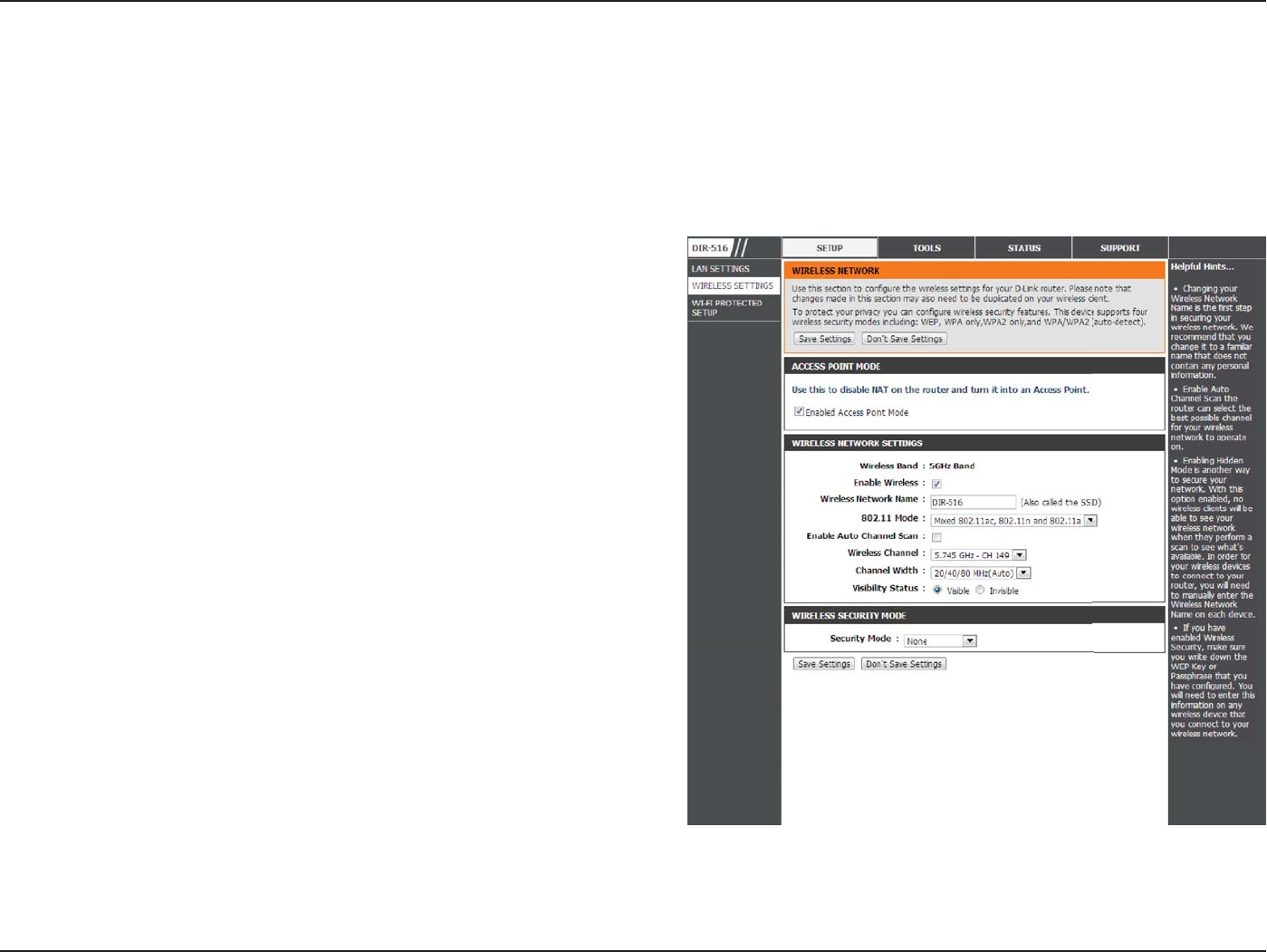
32D-Link DIR-516 User Manual
Section 2 - Setting Up With a Web Browser - Access Point Mode
Wireless Settings
Wireless
Use this to disable NAT on the router and turn it into an
Access Point.
Enable SSID broadcast if you want the router to transmit its
SSID publicly so other wireless devices can discover it.
Enable wireless isolation to prevent connected wireless
devices from connecting to other wireless devices that are
also connected to the router.
Enter the SSID name you want to use for the wireless
network.
Use the dropdown menu to specify the wireless mode.
Use the dropdown menu to select the wireless channel.
Use the dropdown menu to select the channel bandwidth.
If you selected the 802.11n, 802.11 b/g, or 802.11 b/g/n
wireless modes, the available options are 20 MHz and 20/40
MHz. For the others, 20 MHz is the only option.
Select a wireless security encryption option. You can also
choose to not use one by selecting None, but this is not
recommended.
Enabled Access
Point Mode:
Enable SSID
Broadcast:
Enable Wireless
Isolation:
Name (SSID):
Mode:
Channel:
Band Width:
Security
Options:
T
his page allows you to congure the wireless LAN settings. You can also congure the wireless encryption and wireless network
parameters.
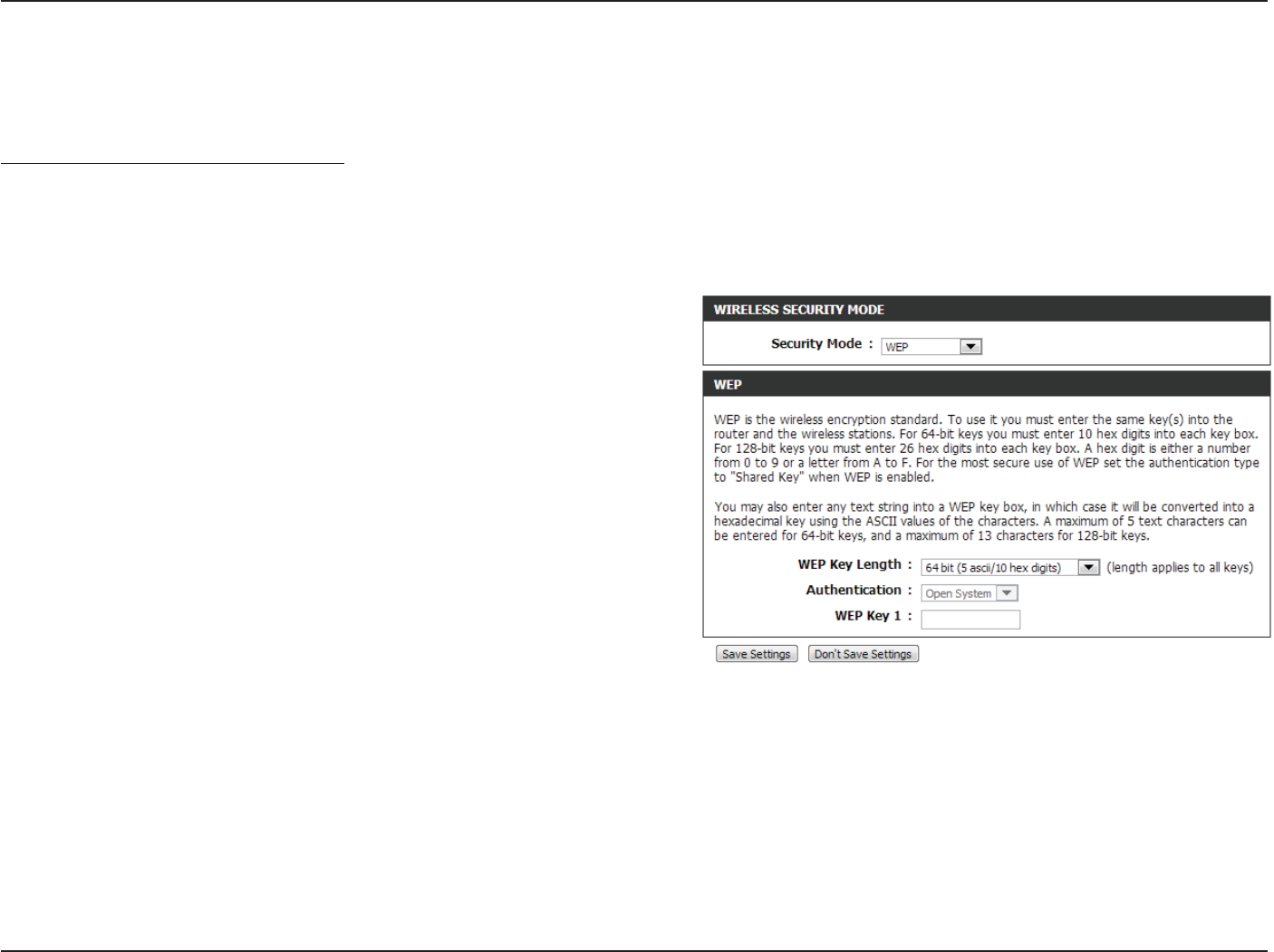
33D-Link DIR-516 User Manual
Section 2 - Setting Up With a Web Browser - Access Point Mode
Wireless security helps to prevent unauthorized users from accessing your wireless network, or seeing data being passed
between the router and wireless clients. The DIR-516 supports two popular wireless security protocols, you should select a
protocol based on the wireless clients which will be accessing your network.
Wired Equivalent Privacy (WEP)
This is an older form of wireless security and should only be used if your wireless clients do not support the newer WPA or
WPA2 protocols.
Select WEP from the drop-down menu.
Select either Automatic or Shared Key as the authentication
type.
Select the encryption strength from the drop-down menu.
64-bit - A 64-bit key comprises a string of 10 hexadecimal
characters, or 5 ASCII characters.
128-bit - A 128-bit key comprises a string of 26 hexadecimal
characters, or 13 ASCII characters.
You can predetermine up to 4 WEP keys. Select the WEP key
you wish to use by clicking on the radio buttons next to the
keys. Select whether you wish to use HEX or ASCII characters
in your key using the drop-down menu. Enter the desired
key in the eld provided.
Click Save Settings to save the current settings.
Security
Options:
Authentication
Type:
Encryption
Strength:
Key 1-4:
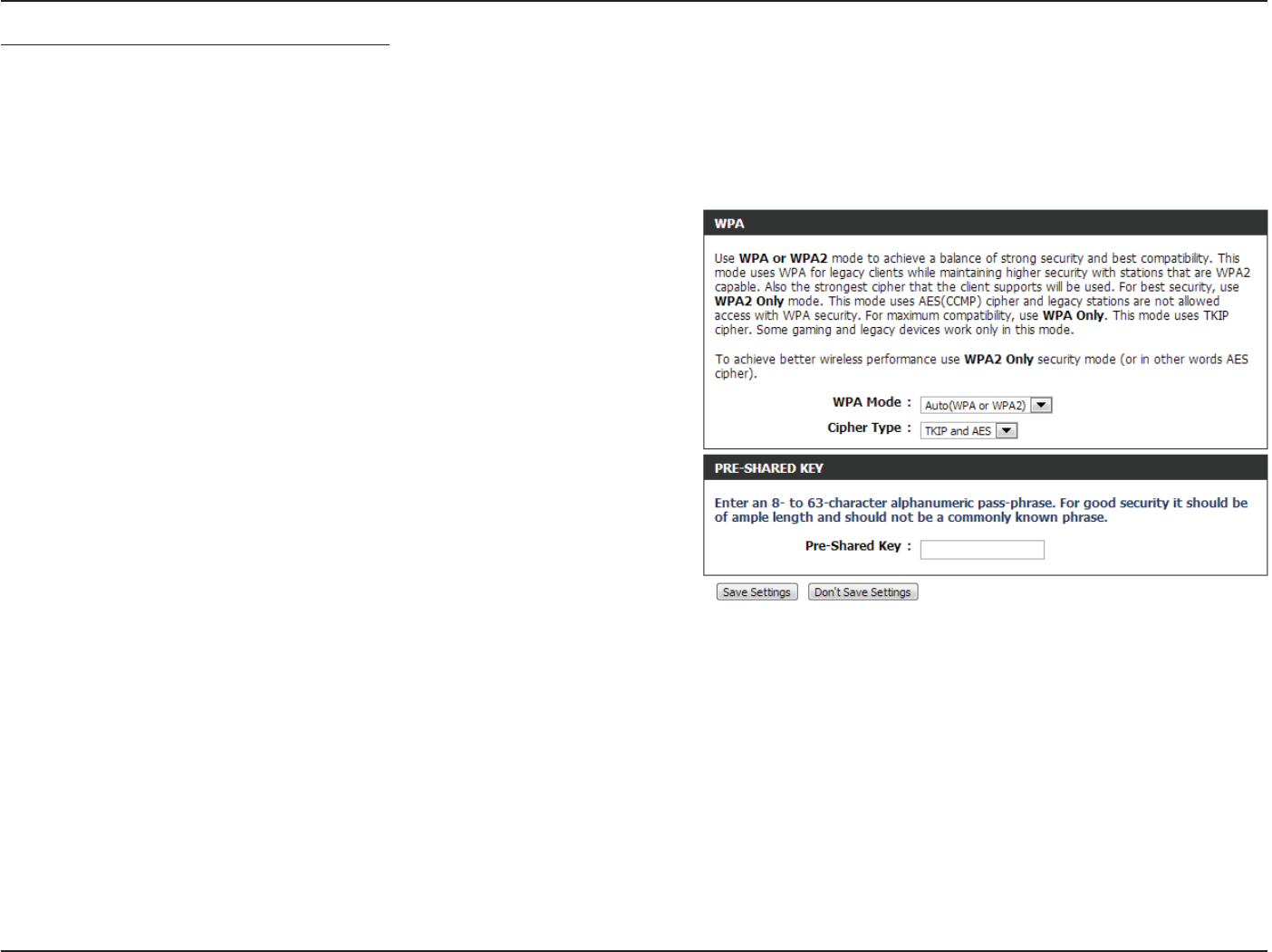
34D-Link DIR-516 User Manual
Section 2 - Setting Up With a Web Browser - Access Point Mode
Wi-Fi Protected Access (WPA/WPA2)
This is a newer and more secure protocol for wireless security. It uses a cipher combined with a pre-shared key (password) to
encrypt data being sent over the wireless network. It is recommended that you use this security method if it is supported by
your wireless clients.
Select WPA-PSK/WPA2-PSK AES from the drop-down
menu.
Enter a pre-shared key (password) to secure your wireless
network. Wireless clients will require this password in
order to connect to your network. It is recommended that
you make a record of this password for future reference.
Click Save Settings to save the current settings.
Security
Options:
Pre-Shared Key:
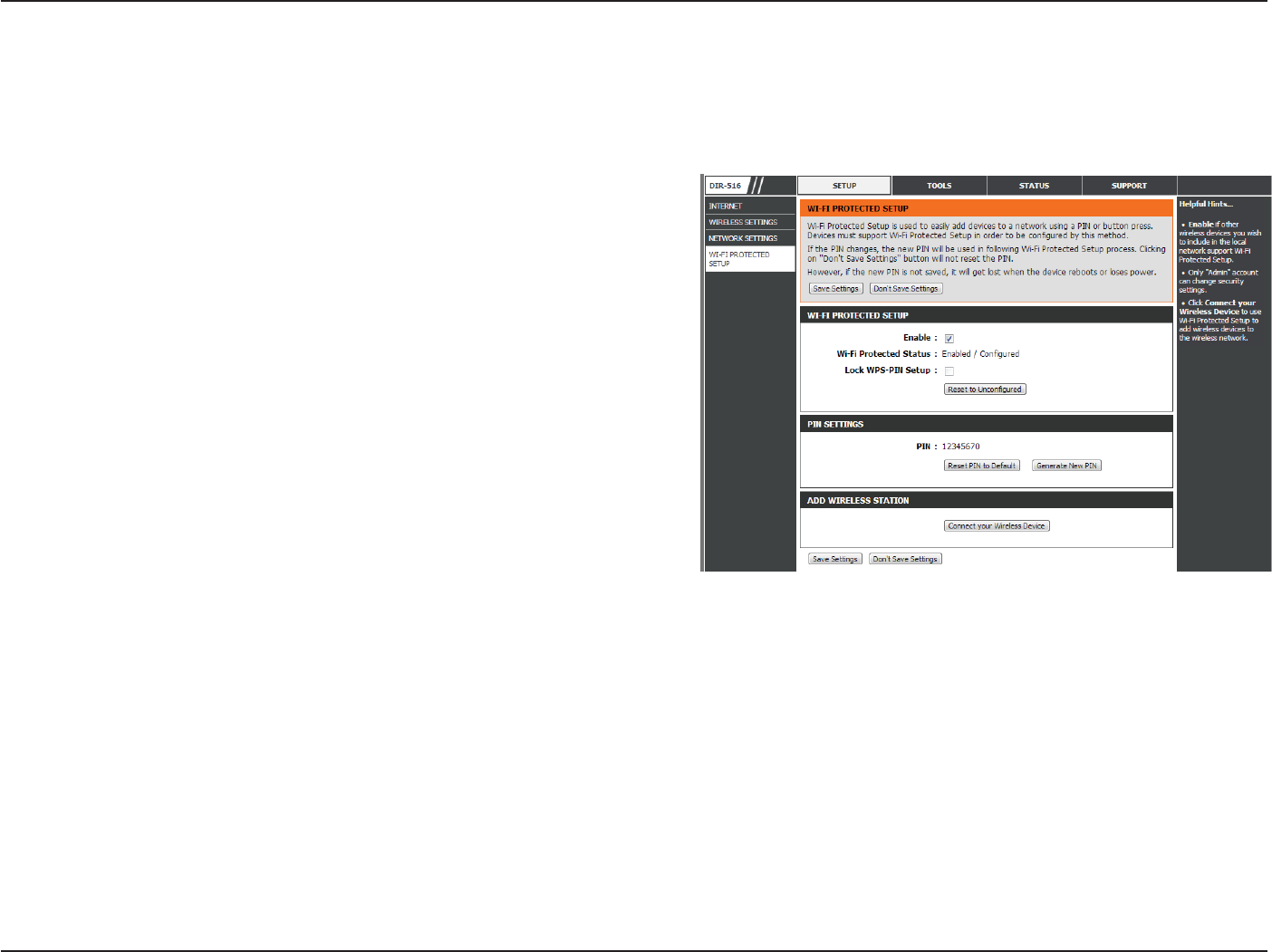
35D-Link DIR-516 User Manual
Section 2 - Setting Up With a Web Browser - Access Point Mode
Wi-Fi Protected (WPS) Setup
If you wish to use the Push-Button Connection (PBC) method, simply press
the WPS button on the side of the router. The power LED will begin to ash.
Within 120 seconds, press the WPS button on the device that you wish to
connect. The power LED will turn solid green if the connection is successful.
To connect using the PIN method, click Next to begin the WPS setup process.
Enter the PIN for the wireless NIC and click Start PIN. If successful, you will
then be taken to another screen and a message will tell you to run WPS in
the client device within 2 minutes.
Wi-Fi Protected Setup (WPS) System is a simplied method for securely connecting new devices to your network. The process
as easy as pressing a button (the Push-Button Connection method) or correctly entering the 8-digit code (the PIN method).
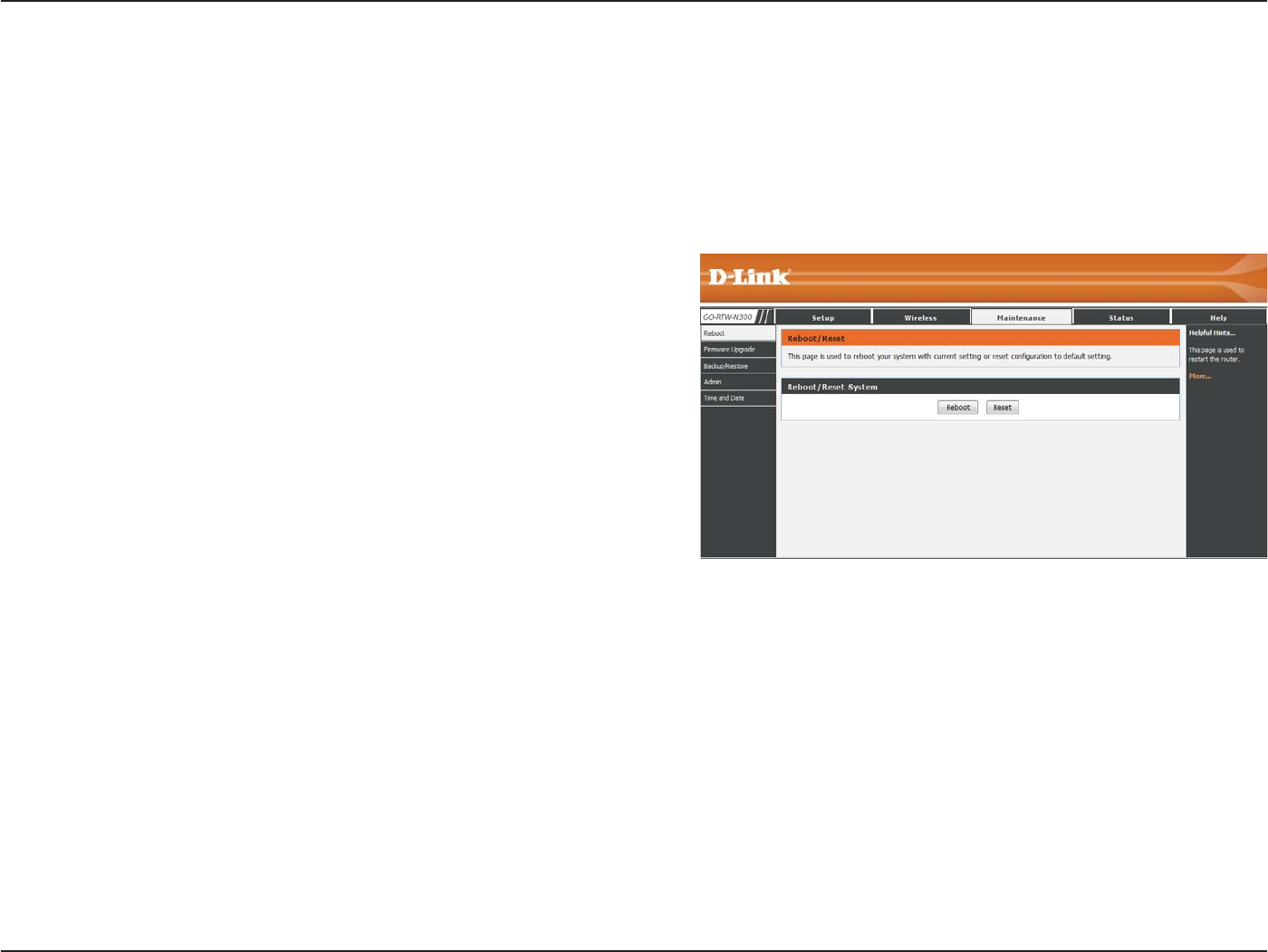
36D-Link DIR-516 User Manual
Section 2 - Setting Up With a Web Browser - Access Point Mode
This page allows you to reboot your router or reset it to the factory default settings.
Reboot
Maintenance
Click the Reboot button to reboot the system. To reset the system
to the factory default setting, click the Reset button. This will erase
the current settings.
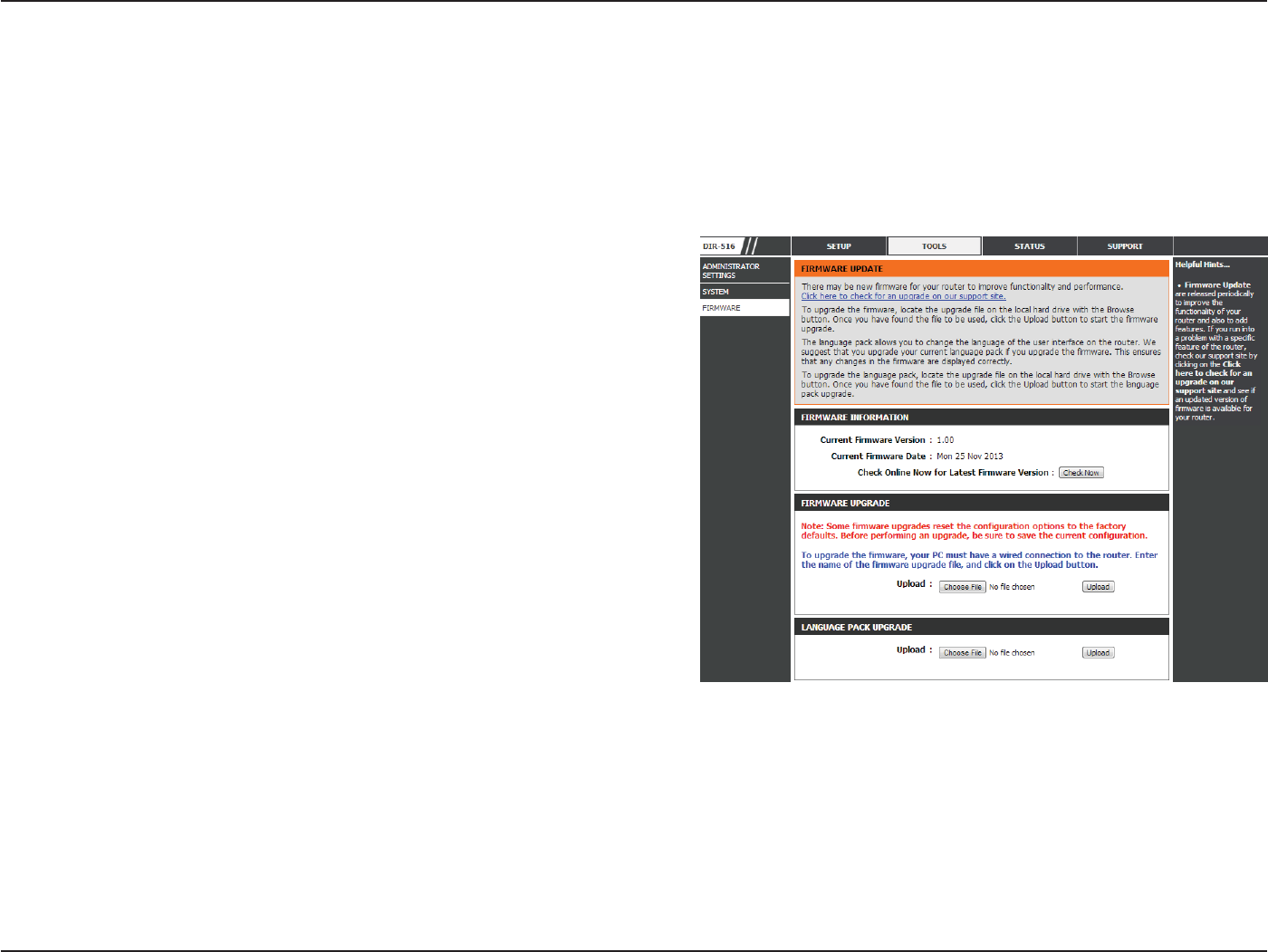
37D-Link DIR-516 User Manual
Section 2 - Setting Up With a Web Browser - Access Point Mode
Firmware
This page allows you to upgrade the rmware of the router. If you plan to install new rmware, make sure the rmware
you want to use is on the local hard drive of the computer. Please check the D-Link support site for rmware updates at
http://support.dlink.com. You can download rmware upgrades to your hard drive from the D-Link support site.
After you have downloaded the new rmware, click
Browse to locate the rmware update on your hard
drive.
Choose File:
Click the Upload button to upload a le to the router after you
have selected it, or click the Reset button to cancel the selection.
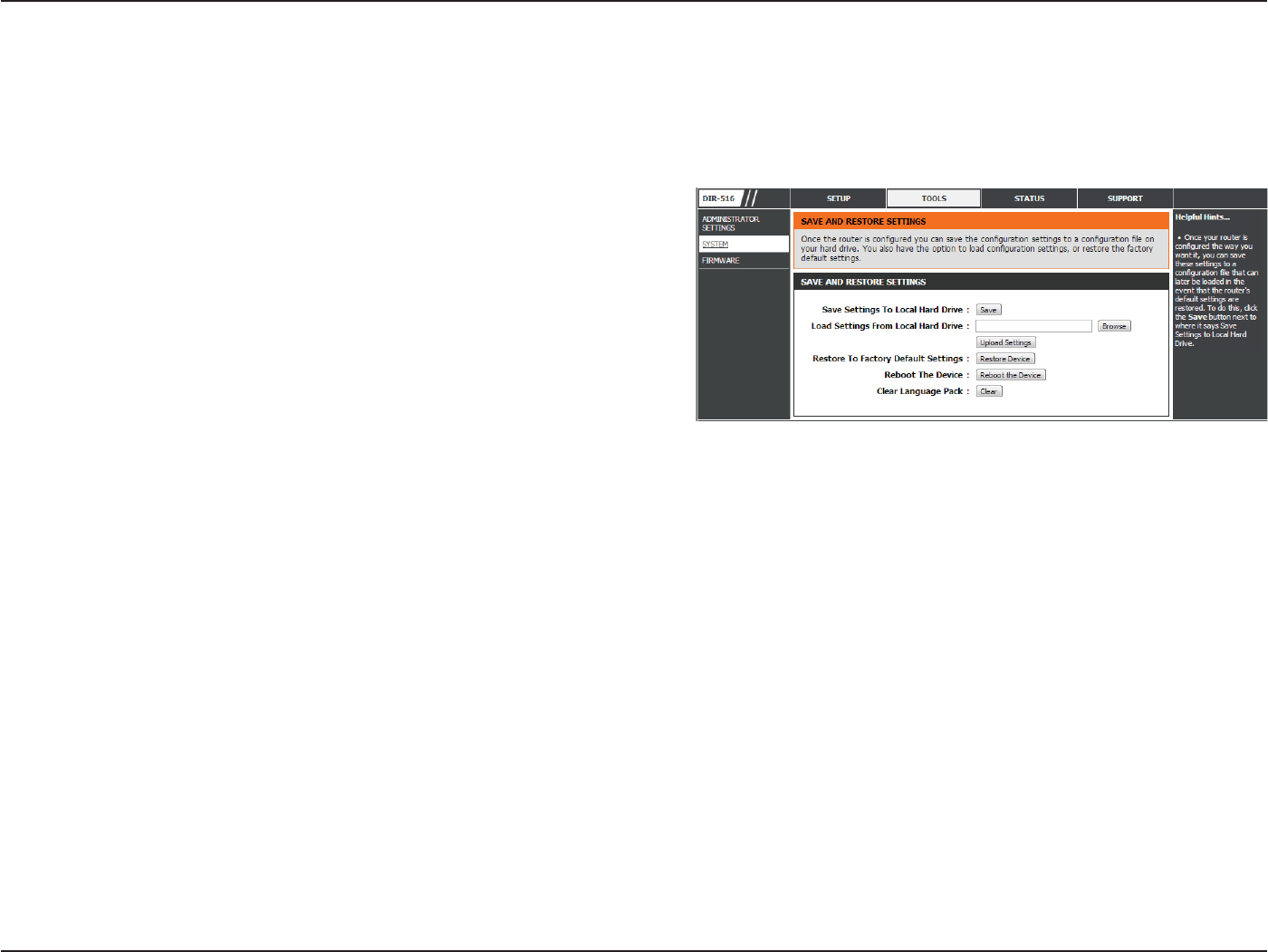
38D-Link DIR-516 User Manual
Section 2 - Setting Up With a Web Browser - Access Point Mode
System
This page allows you to save the router’s current conguration le onto your computer’s hard drive or load a saved le from
your hard drive.
Click the Save button to download the current conguration
settings as a le onto your hard drive.
To load a previously saved settings le, click the Browse button to
locate the le on your hard drive, then click the Upload button.
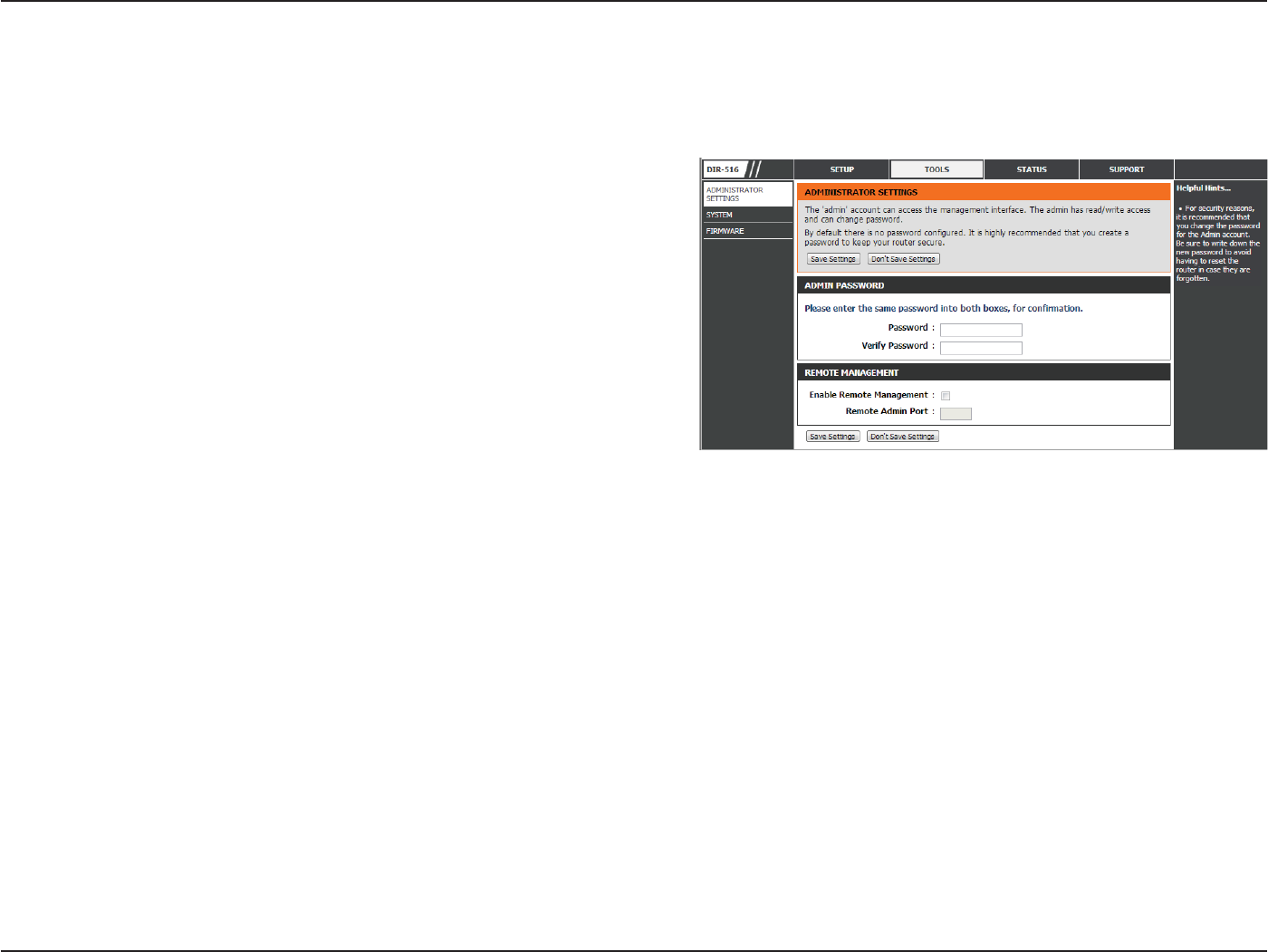
39D-Link DIR-516 User Manual
Section 2 - Setting Up With a Web Browser - Access Point Mode
Admin
Enter a username.
The user has root privilege.
Enter the current password of the account.
Enter the new password for the account.
Retype the new password.
User Name:
Privilege:
Old Password:
New Password:
Conrm Password:
This page allows you to add a user account to the router’s web server. You can also delete or modify existing accounts.
Click the Add button to save any changes made. The user account
will also be added to the User Account Table below. To modify an
existing user account, click the Select tab next to the user account
in the table, edit the user settings you wish to change, and then
click the Modify button.
To delete an existing account, click the Select tab next to the user
account in the table and then click the Delete button.
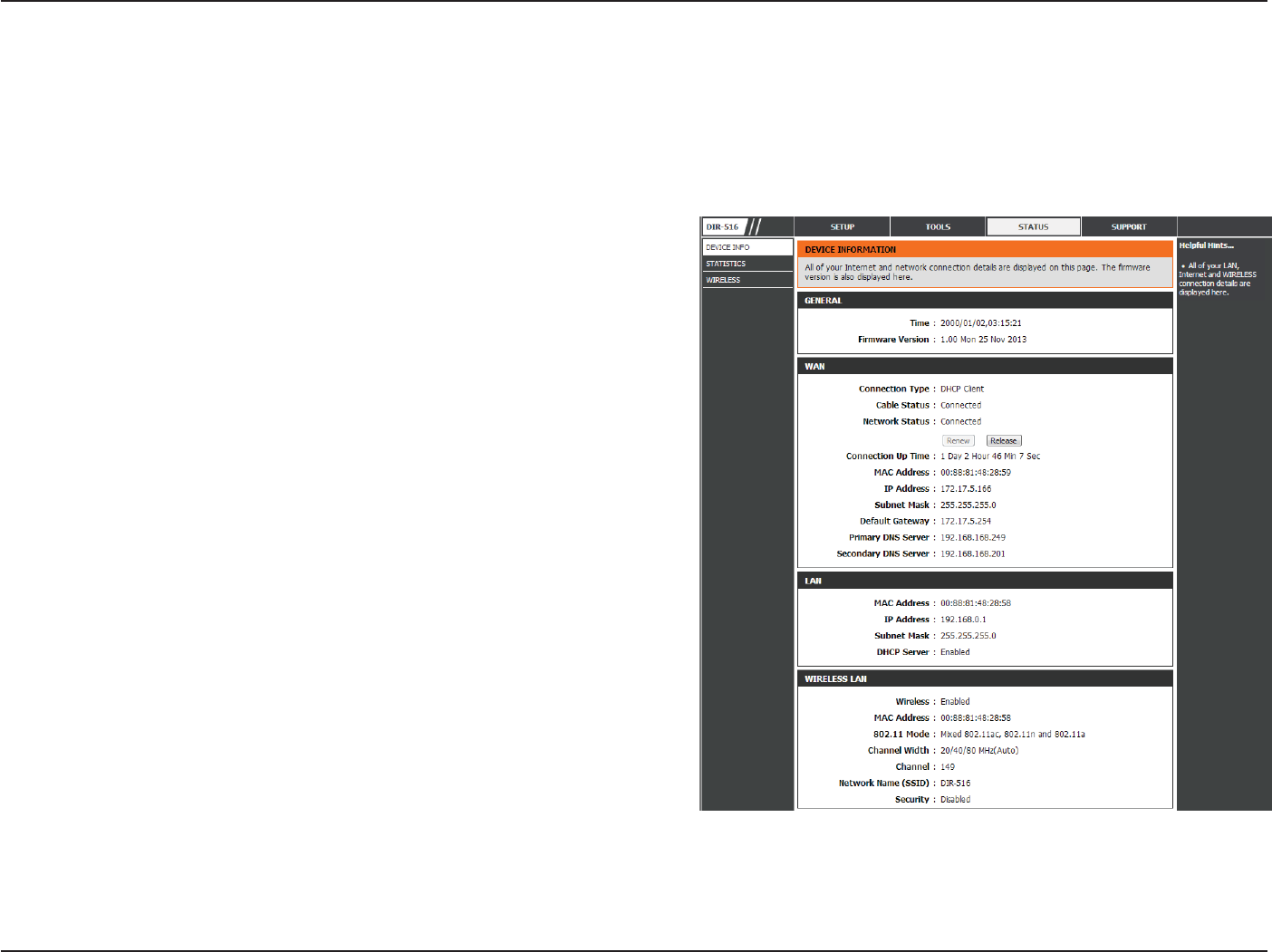
40D-Link DIR-516 User Manual
Section 2 - Setting Up With a Web Browser - Access Point Mode
Displays the router’s time and rmware version.
Displays the MAC address and the private (local) IP
settings for the router.
Displays the wireless MAC address and your wireless
settings such as SSID and Channel.
Displays the MAC address and the public IP settings for
the router.
System:
Device Info
T
his page displays the current status and basic settings of the router.
Status
LAN
Conguration:
WLAN
Conguration:
WAN
Conguration:
Click the Refresh button to view the most current information.
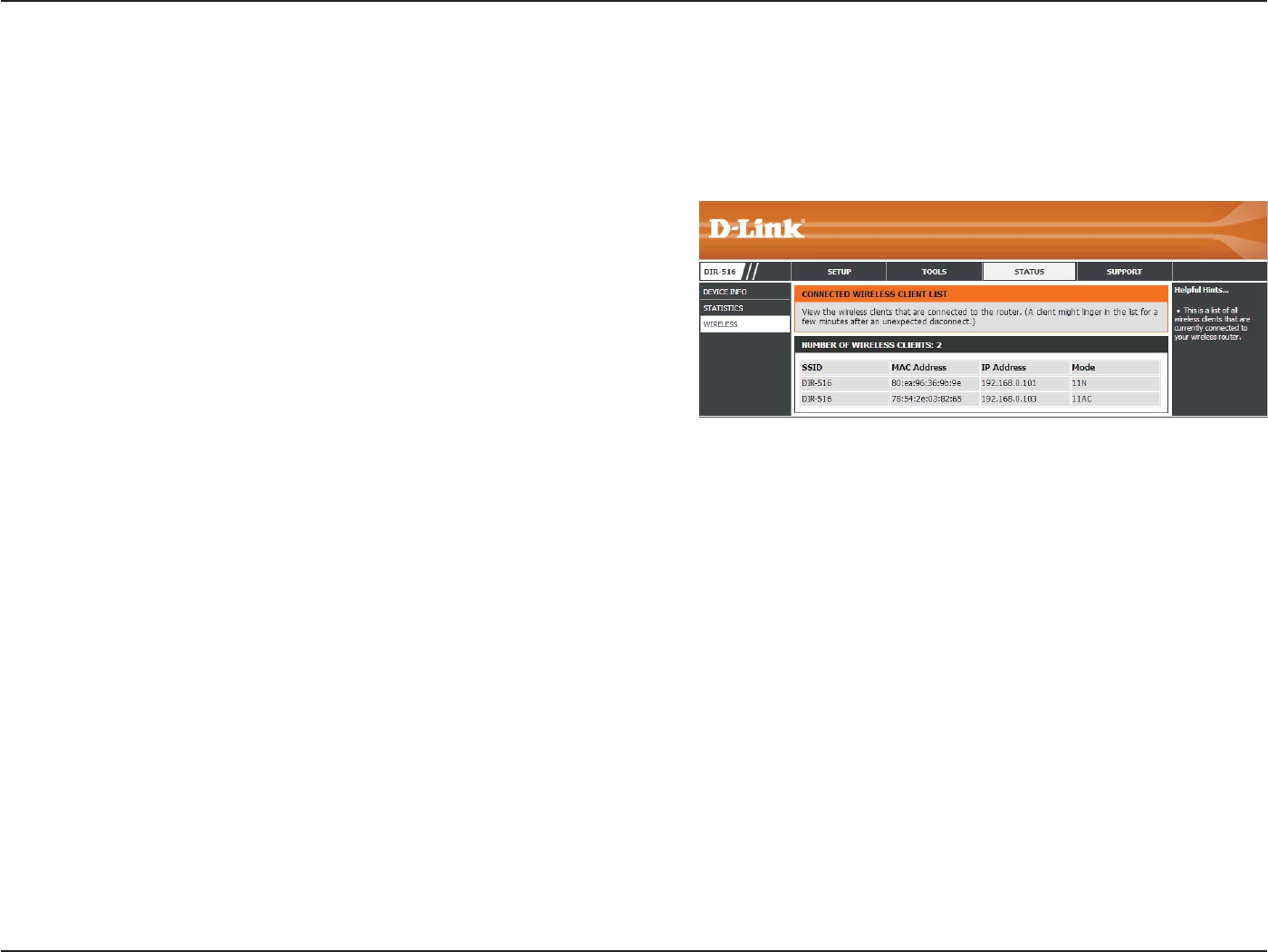
41D-Link DIR-516 User Manual
Section 2 - Setting Up With a Web Browser - Access Point Mode
Wireless
This table displays all active wired clients.
This table displays all active wireless clients.
Active Wired Client
Table:
Active Wireless
Client Table:
This page displays lists of all wired and wireless clients. The IP address and MAC address of each client is displayed in the tables.
Click the Save Settings button to save any changes made.
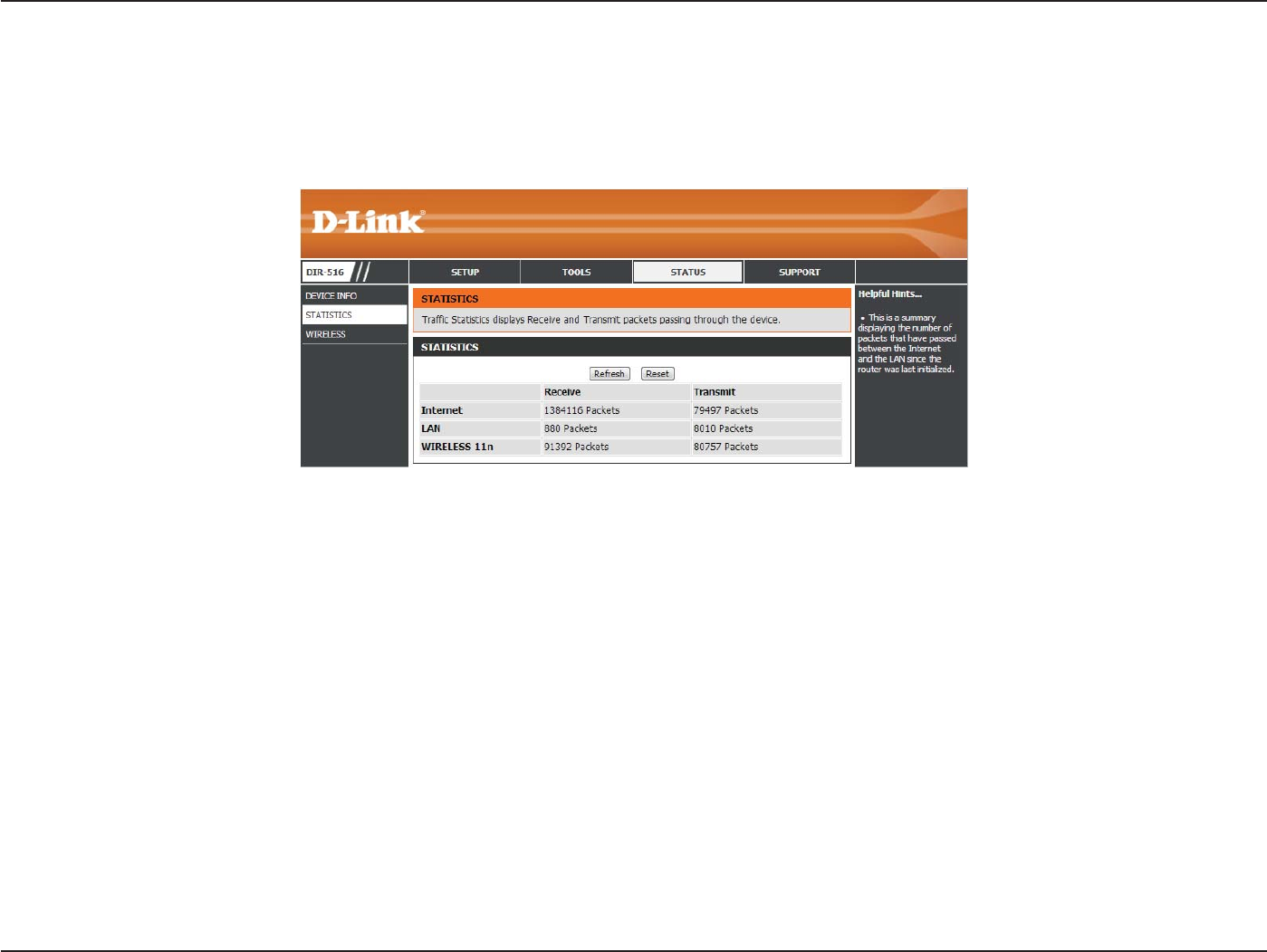
42D-Link DIR-516 User Manual
Section 2 - Setting Up With a Web Browser - Access Point Mode
Statistics
This page displays the statistics for packets that have been transmitted and received on the network on the router’s WAN and
LAN ports, and wireless bands.
Click the Refresh button to refresh the router’s trac statistics.
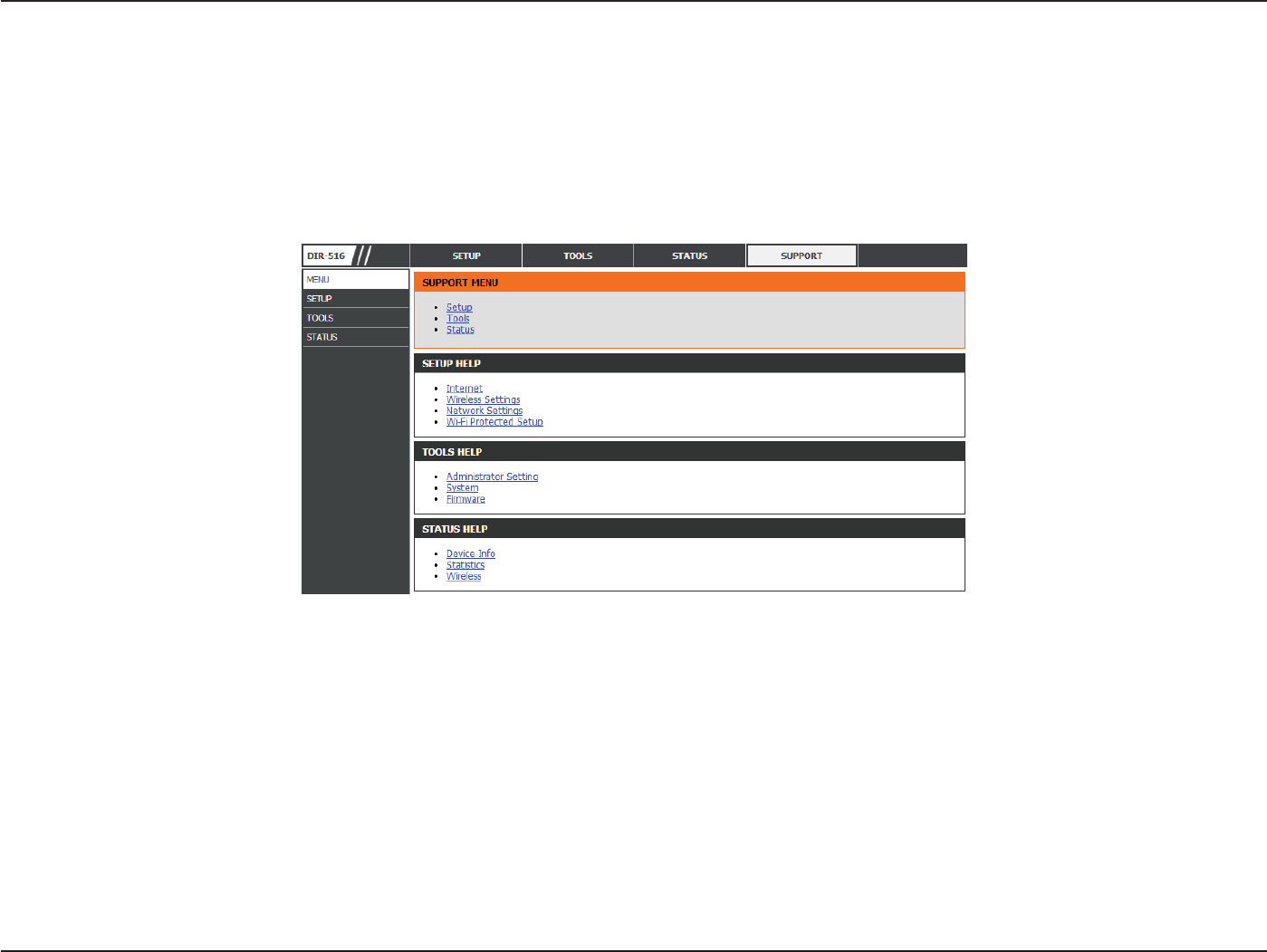
43D-Link DIR-516 User Manual
Section 2 - Setting Up With a Web Browser - Access Point Mode
Support
This section provides an explanation of each conguration or setting for the DIR-516. Click on the links to be taken to the help
text for that particular section of router’s setup.

44D-Link DIR-516 User Manual
Section 3 - Connecting a Wireless Client
Connecting a Wireless Client
WPS Button
Step 2 - Within 2 minutes, press the WPS button on your wireless
client (or launch the software utility and start the WPS
process).
The easiest and most secure way to connect your wireless devices to the router is WPS (Wi-Fi Protected Setup). Many wireless
devices will have a WPS button (or a software utility with WPS) that you can press to connect to the DIR-516 router. Please
refer to your user manual for the wireless device you want to connect to make sure you understand how to enable WPS on it.
Step 1 - Press the WPS button on the DIR-516 for about 1 second.
The WPS button will start to blink.
Step 3 - Allow up to 1 minute for the devices to congure your
connection. Once the WPS light stops blinking, you
will be connected and your wireless connection will be
secure with WPA2.
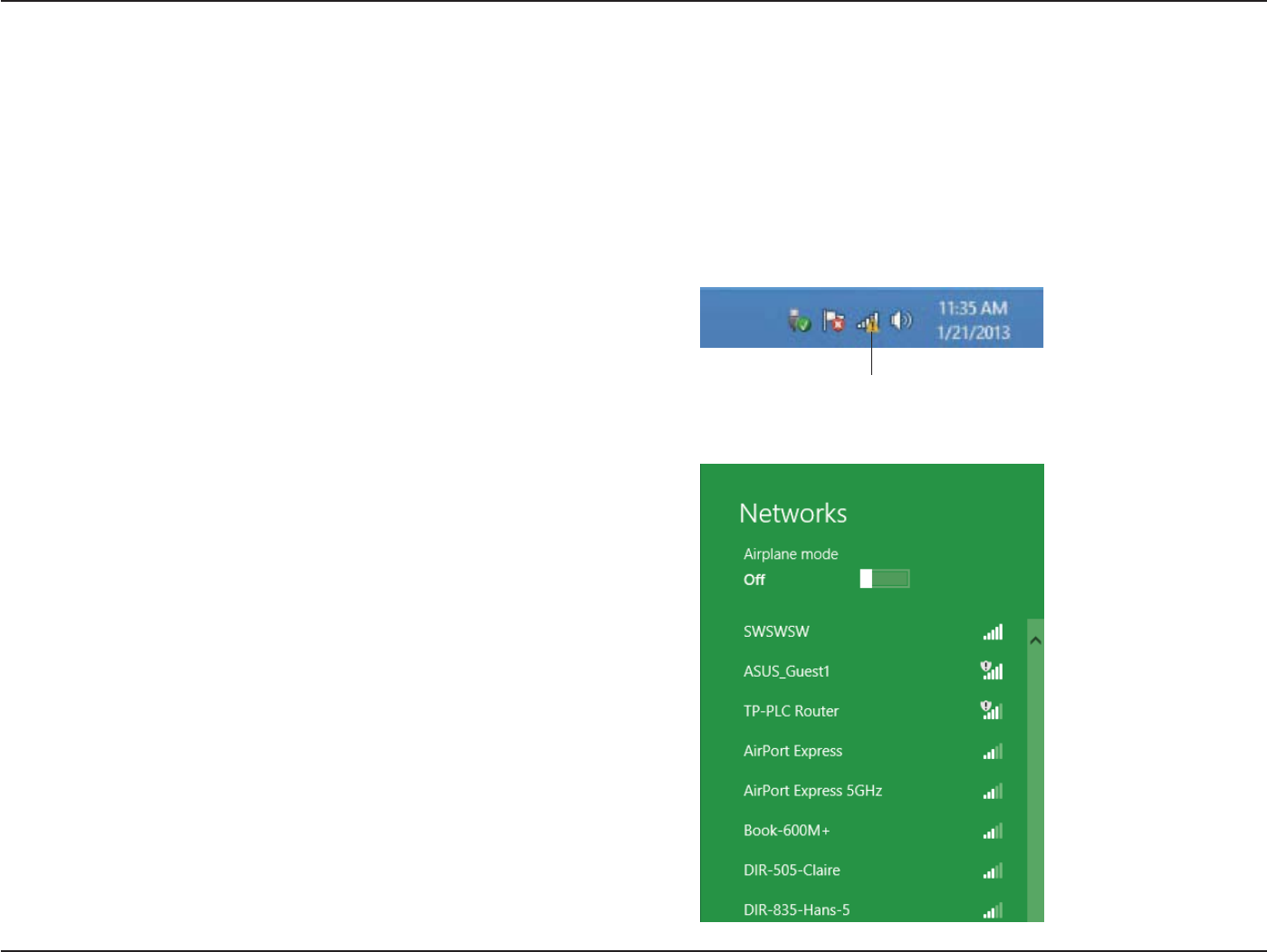
45D-Link DIR-516 User Manual
Section 3 - Connecting a Wireless Client
Windows® 8
WPA/WPA2
It is recommended to enable wireless security (WPA/WPA2) on your wireless router or access point before conguring your
wireless adapter. If you are joining an existing network, you will need to know the security key (Wi-Fi password) being used.
To join an existing network, locate the wireless network icon in
the taskbar, next to the time display.
Wireless Icon
Clicking on this icon will display a list of wireless networks which
are within connecting proximity of your computer. Select the
desired network by clicking on the network name.
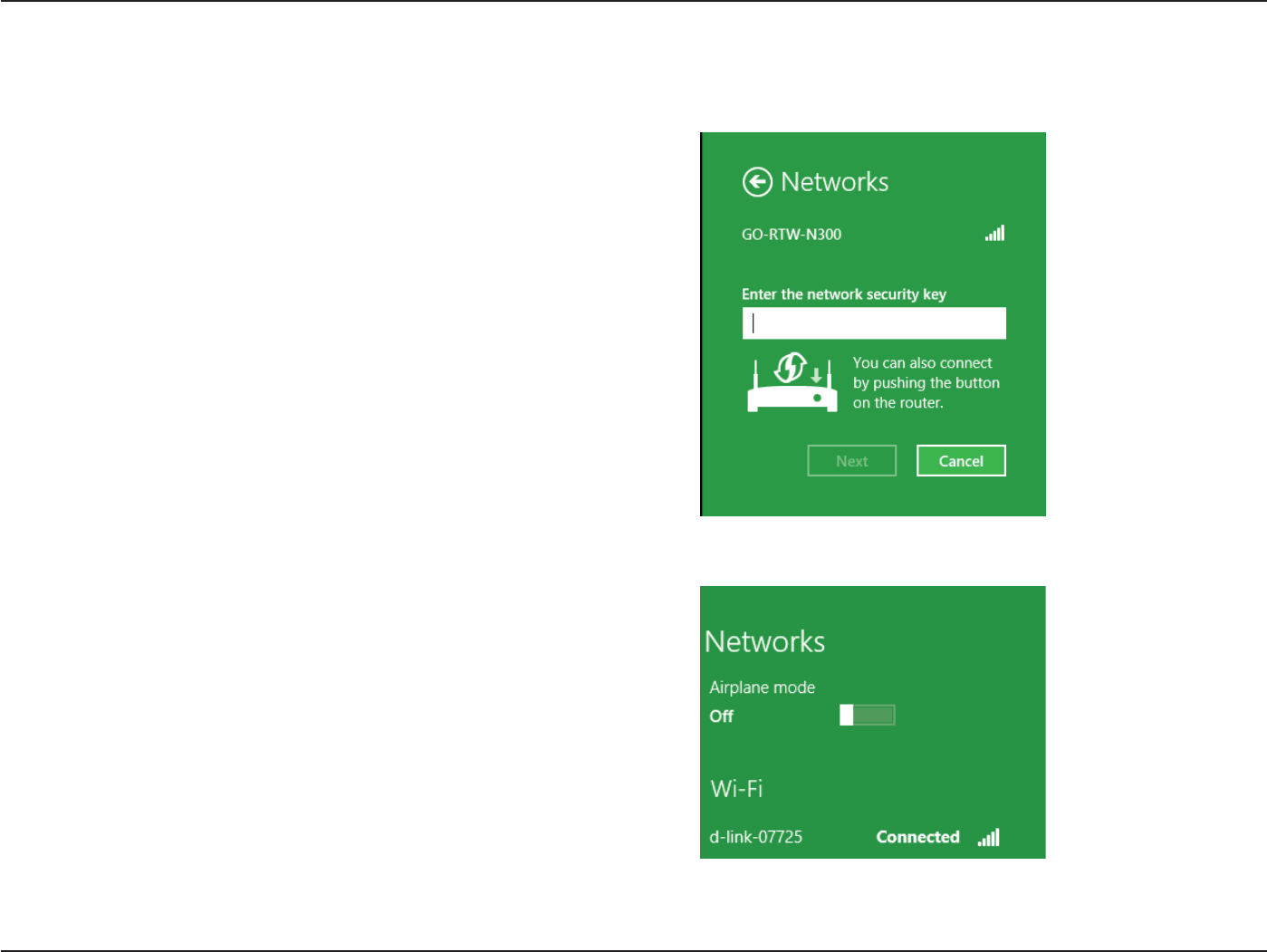
46D-Link DIR-516 User Manual
Section 3 - Connecting a Wireless Client
You will then be prompted to enter the network security key (Wi-Fi
password) for the wireless network. Enter the password into the
box and click Next.
If you wish to use Wi-Fi Protected Setup (WPS) to connect to the
router, you can also press the WPS button on your router at the
point to enable the WPS function.
When you have established a successful connection a wireless
network, the word Connected will appear next to the name of
the network to which you are connected.
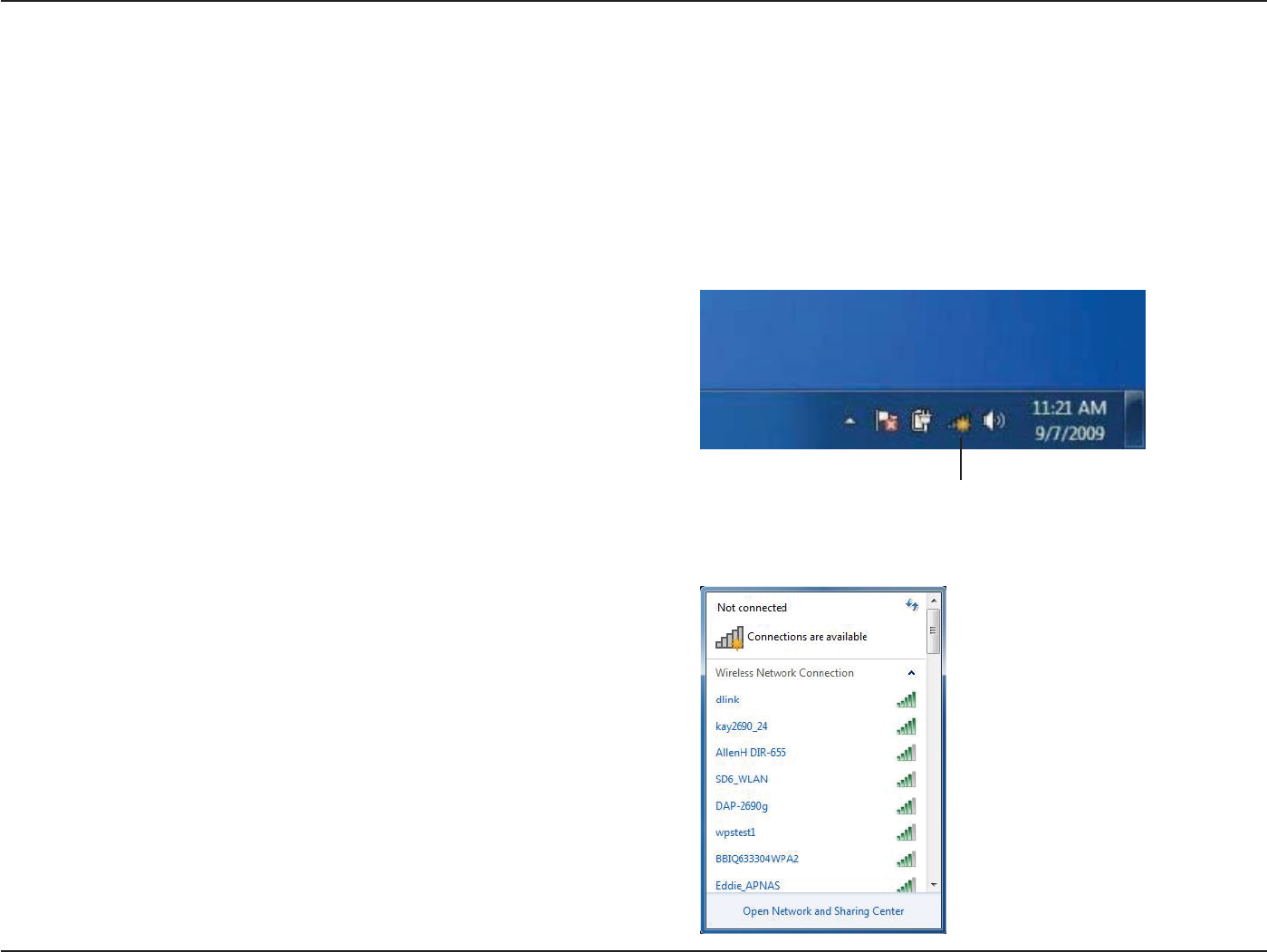
47D-Link DIR-516 User Manual
Section 3 - Connecting a Wireless Client
Windows® 7
It is recommended to enable wireless security (WPA/WPA2) on your wireless router or access point before conguring your
wireless adapter. If you are joining an existing network, you will need to know the security key or passphrase being used.
1. Click on the wireless icon in your system tray (lower-right
corner).
2. The utility will display any available wireless networks in your
area.
Wireless Icon
WPA/WPA2
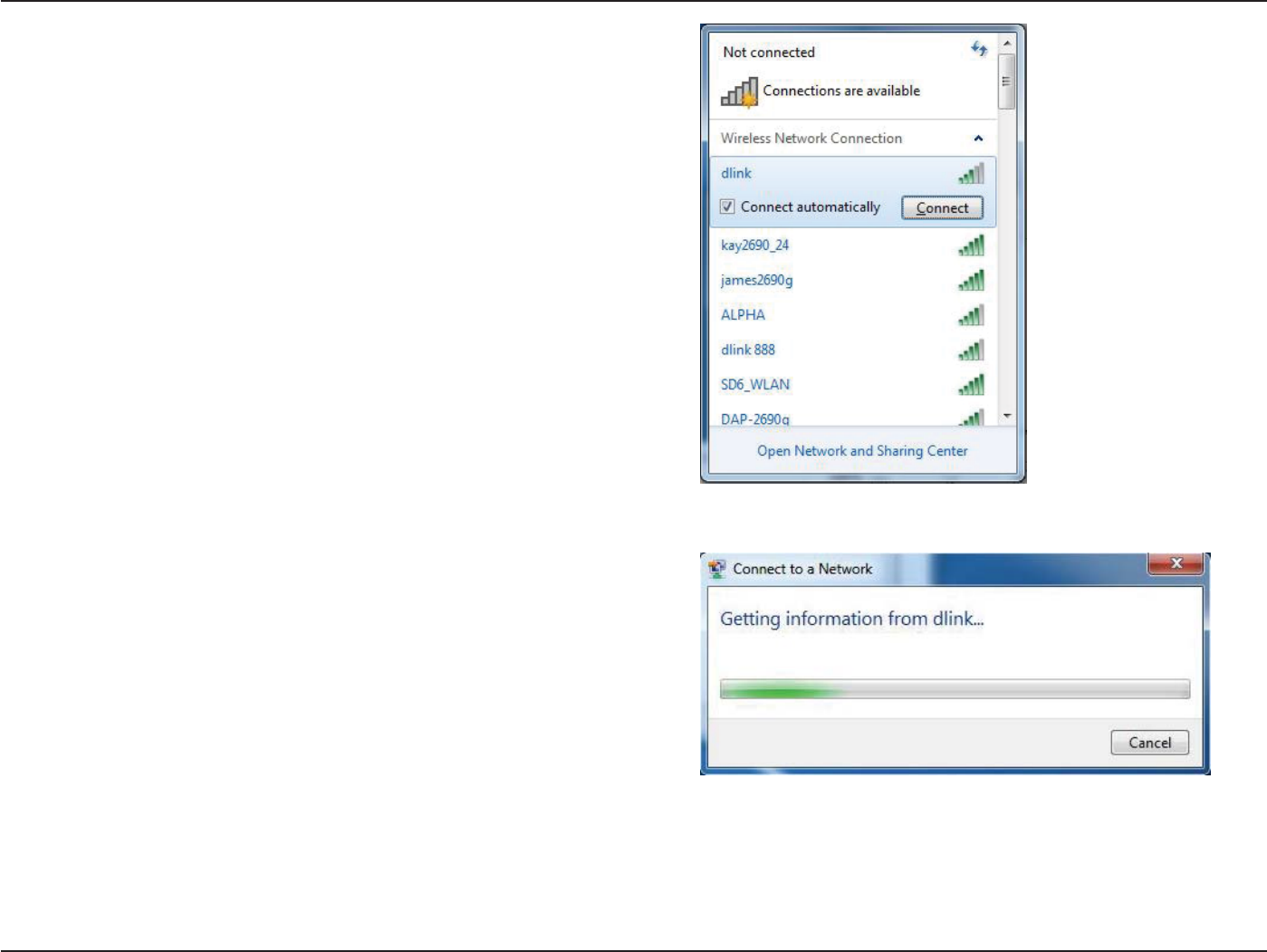
48D-Link DIR-516 User Manual
Section 3 - Connecting a Wireless Client
3. Highlight the wireless network (SSID) you would like to connect
to and click the Connect button.
If you get a good signal but cannot access the Internet, check
your TCP/IP settings for your wireless adapter. Refer to the
Networking Basics section in this manual for more information.
4. The following window appears while your computer tries to
connect to the router.
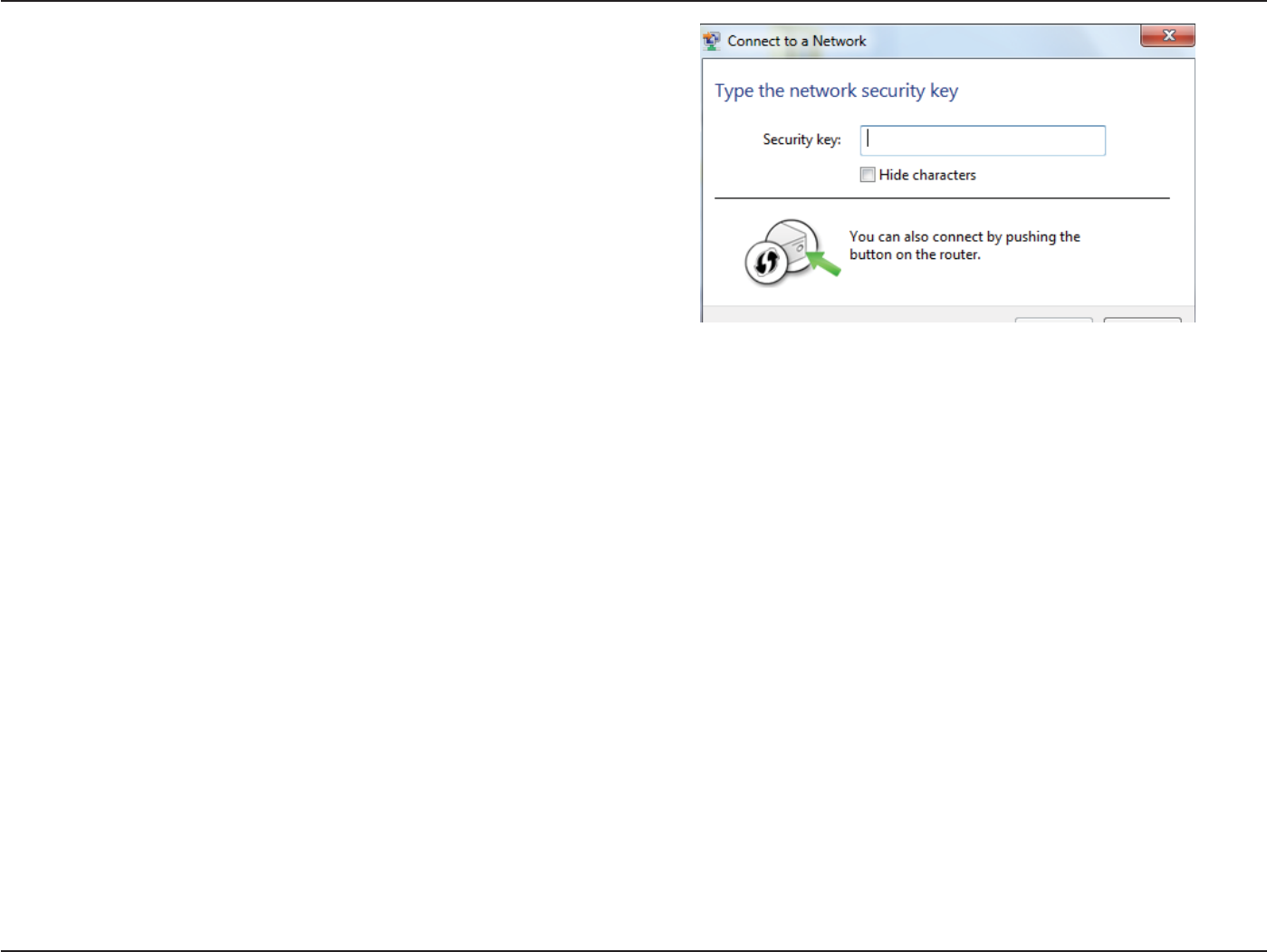
49D-Link DIR-516 User Manual
Section 3 - Connecting a Wireless Client
5. Enter the same security key or passphrase that is on your router
and click Connect. You can also connect by pushing the WPS
button on the router.
It may take 20-30 seconds to connect to the wireless network. If
the connection fails, please verify that the security settings are
correct. The key or passphrase must be exactly the same as on
the wireless router.
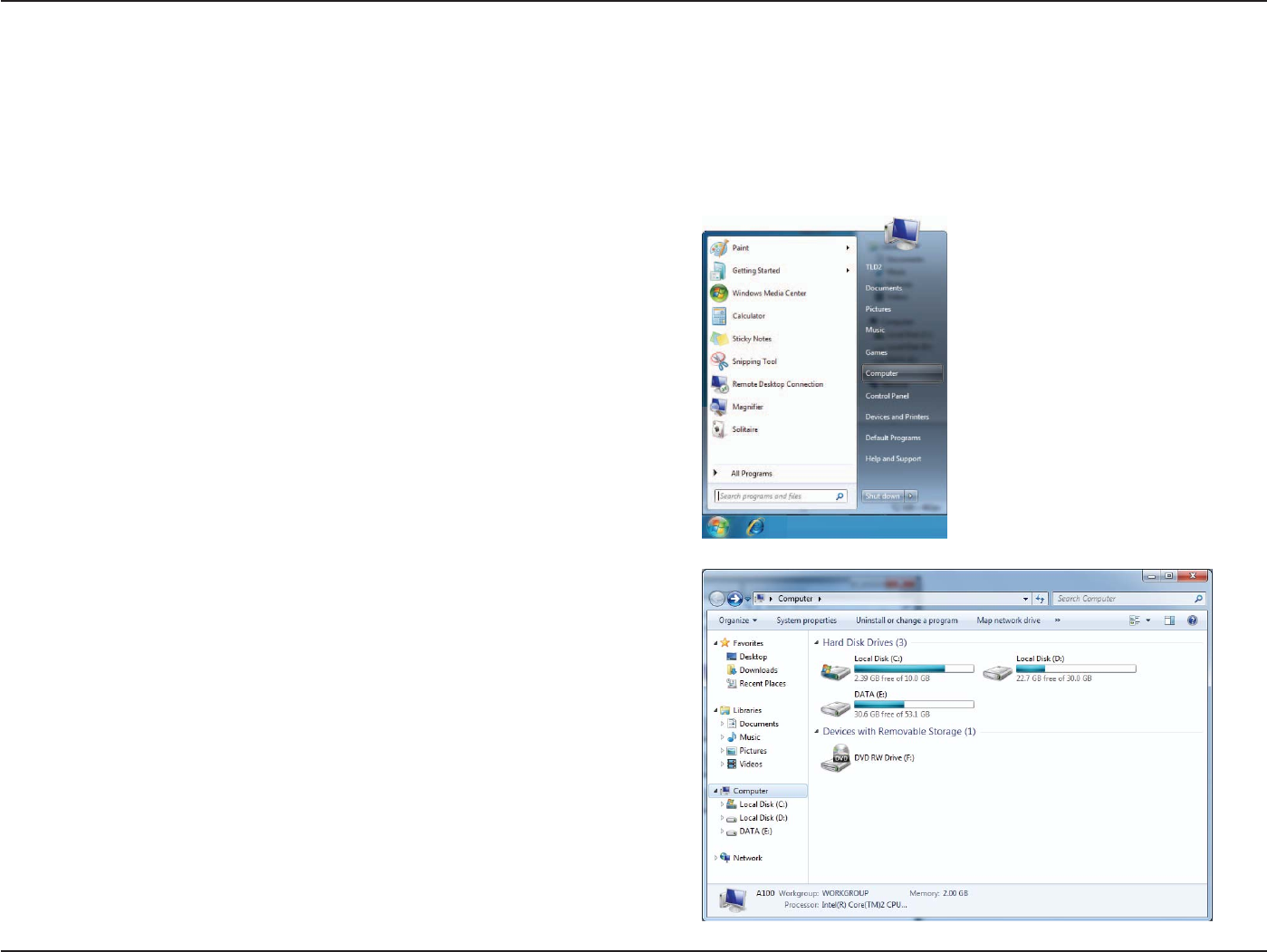
50D-Link DIR-516 User Manual
Section 3 - Connecting a Wireless Client
WPS
The WPS feature of the DIR-516 can be congured using Windows® 7. Carry out the following steps to use Windows® 7 to
congure the WPS feature:
1. Click the Start button and select Computer from the Start menu.
2. Click Network on the left side.
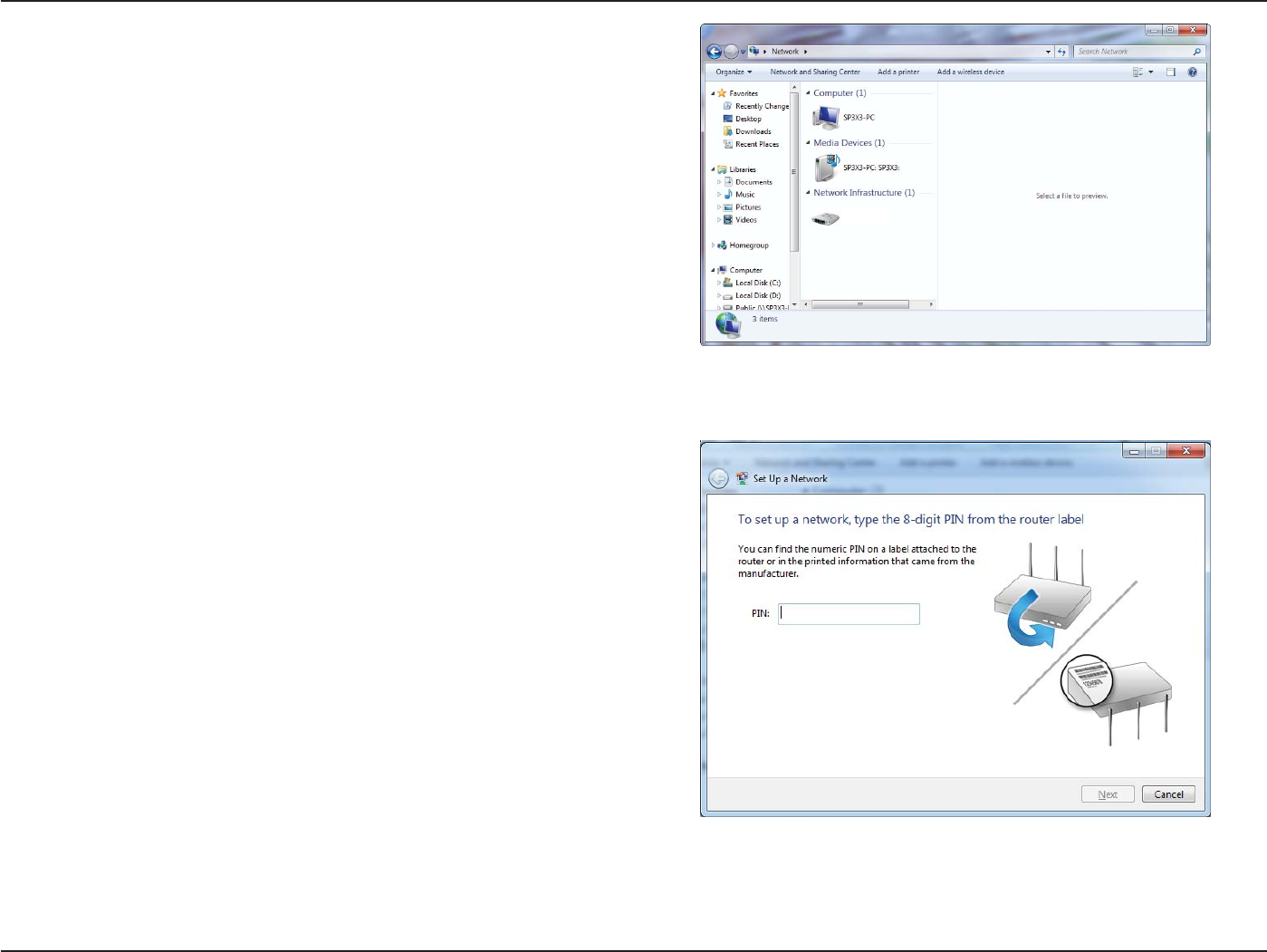
51D-Link DIR-516 User Manual
Section 3 - Connecting a Wireless Client
3. Double-click the DIR-516.
4. Input the WPS PIN number (displayed in the WPS window on
the Router’s LCD screen or in the Setup > Wireless Setup menu
in the Router’s Web UI) and click Next.
',5
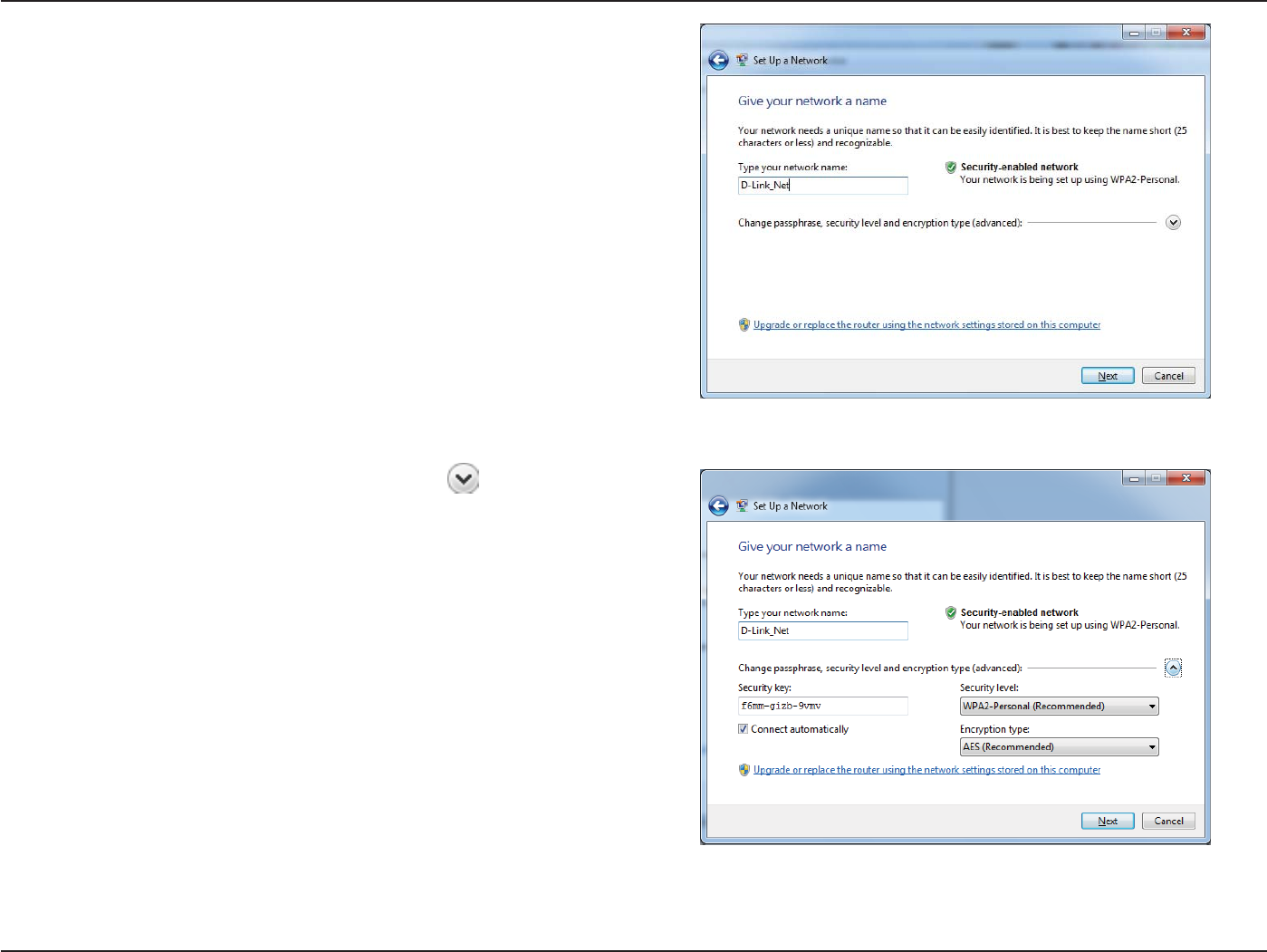
52D-Link DIR-516 User Manual
Section 3 - Connecting a Wireless Client
5. Type a name to identify the network.
6. To congure advanced settings, click the icon.
Click Next to continue.
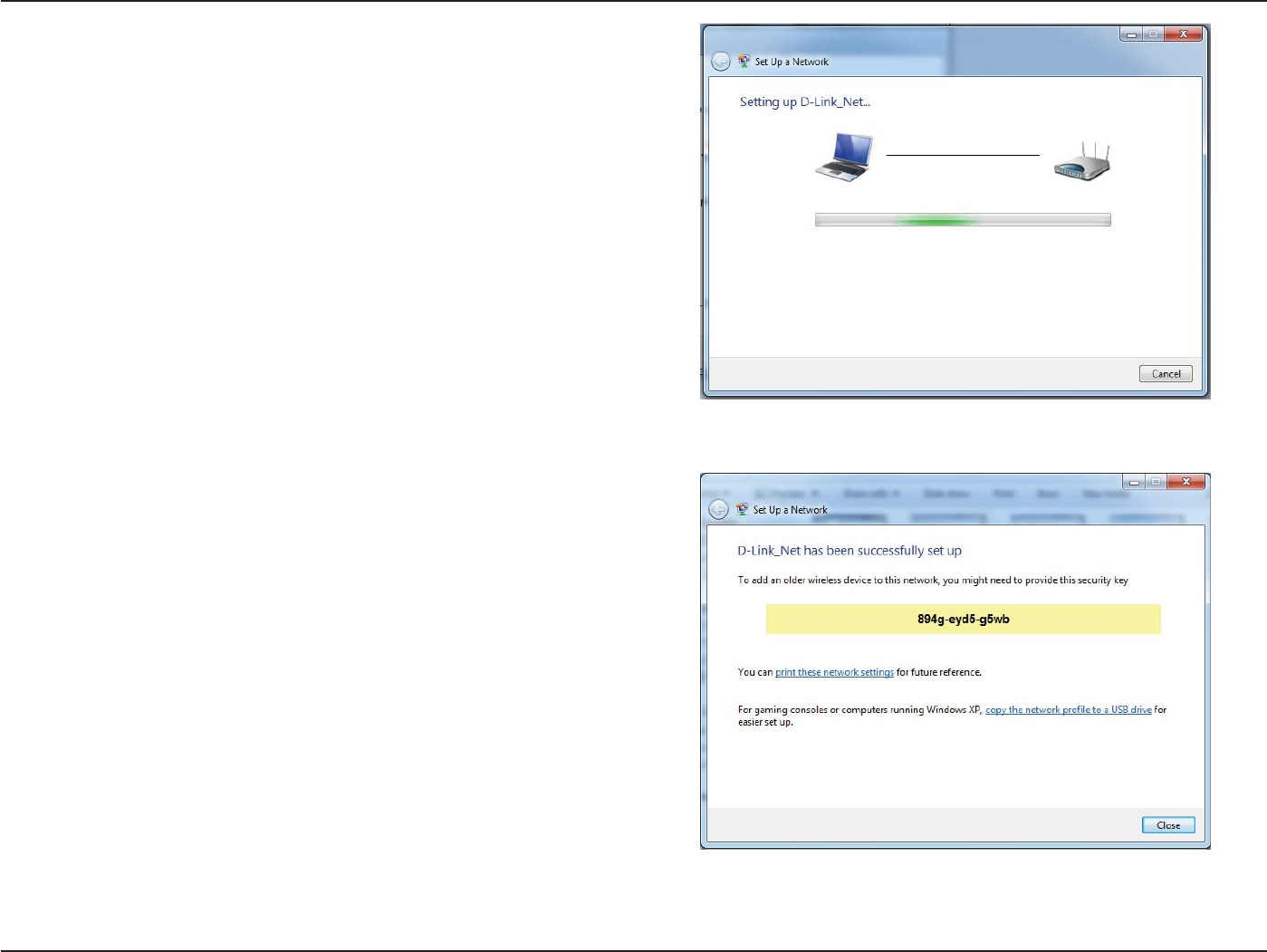
53D-Link DIR-516 User Manual
Section 3 - Connecting a Wireless Client
7. The following window appears while the Router is being
congured.
Wait for the conguration to complete.
8. The following window informs you that WPS on the router has
been setup successfully.
Make a note of the security key as you may need to provide this
security key if adding an older wireless device to the network
in the future.
9. Click Close to complete WPS setup.
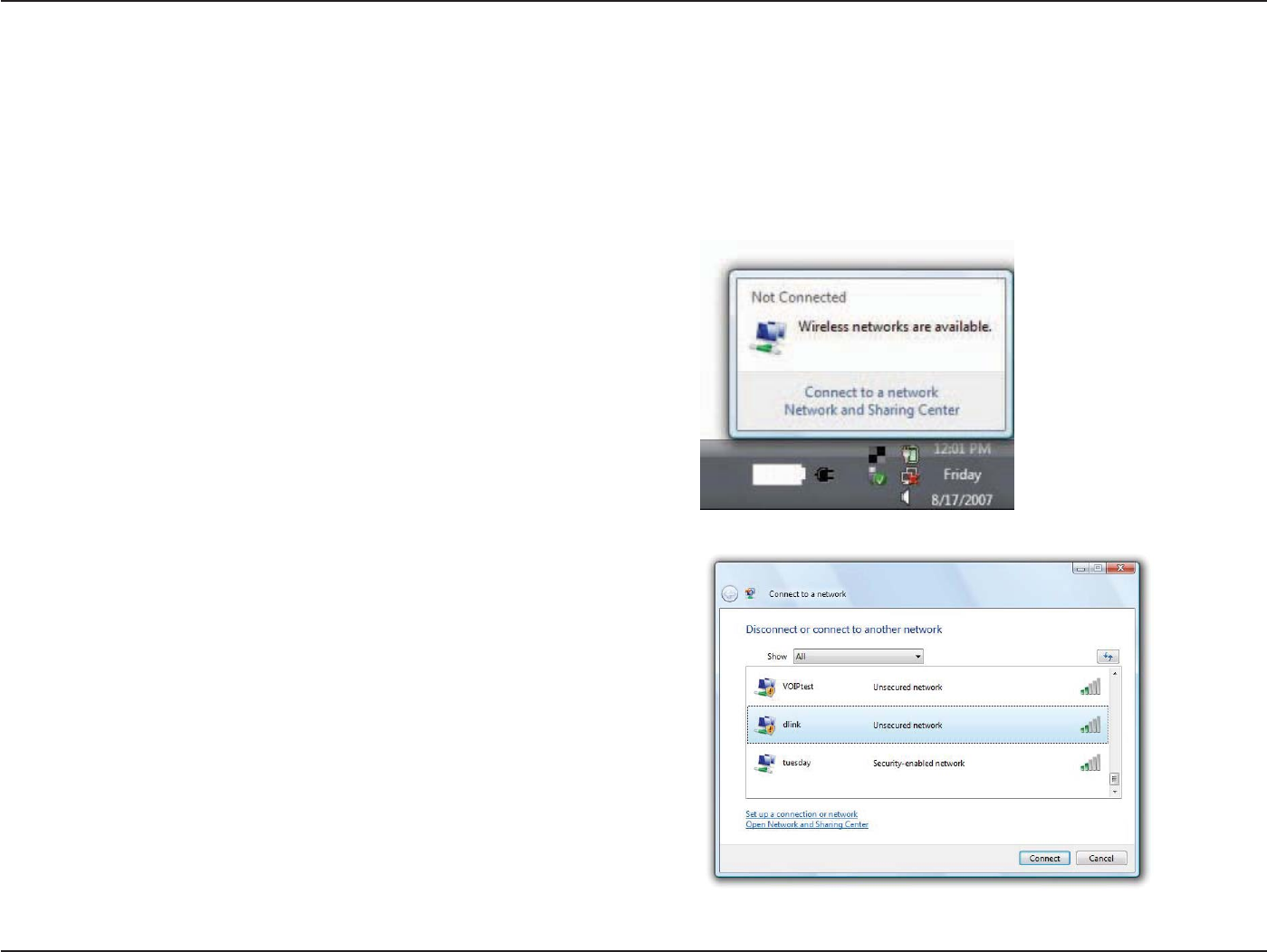
54D-Link DIR-516 User Manual
Section 3 - Connecting a Wireless Client
Windows Vista®
Windows Vista® users may use the built-in wireless utility. If you are using another company’s utility or Windows® 2000, please
refer to the user manual of your wireless adapter for help with connecting to a wireless network. Most utilities will have a “site
survey” option similar to the Windows Vista® utility as seen below.
Right-click on the wireless computer icon in your system tray
(lower-right corner next to the time). Select Connect to a network.
If you receive the Wireless Networks Detected bubble, click on
the center of the bubble to access the utility.
or
The utility will display any available wireless networks in your
area. Click on a network (displayed using the SSID) and click the
Connect button.
If you get a good signal but cannot access the Internet, check you
TCP/IP settings for your wireless adapter. Refer to the Networking
Basics section in this manual for more information.
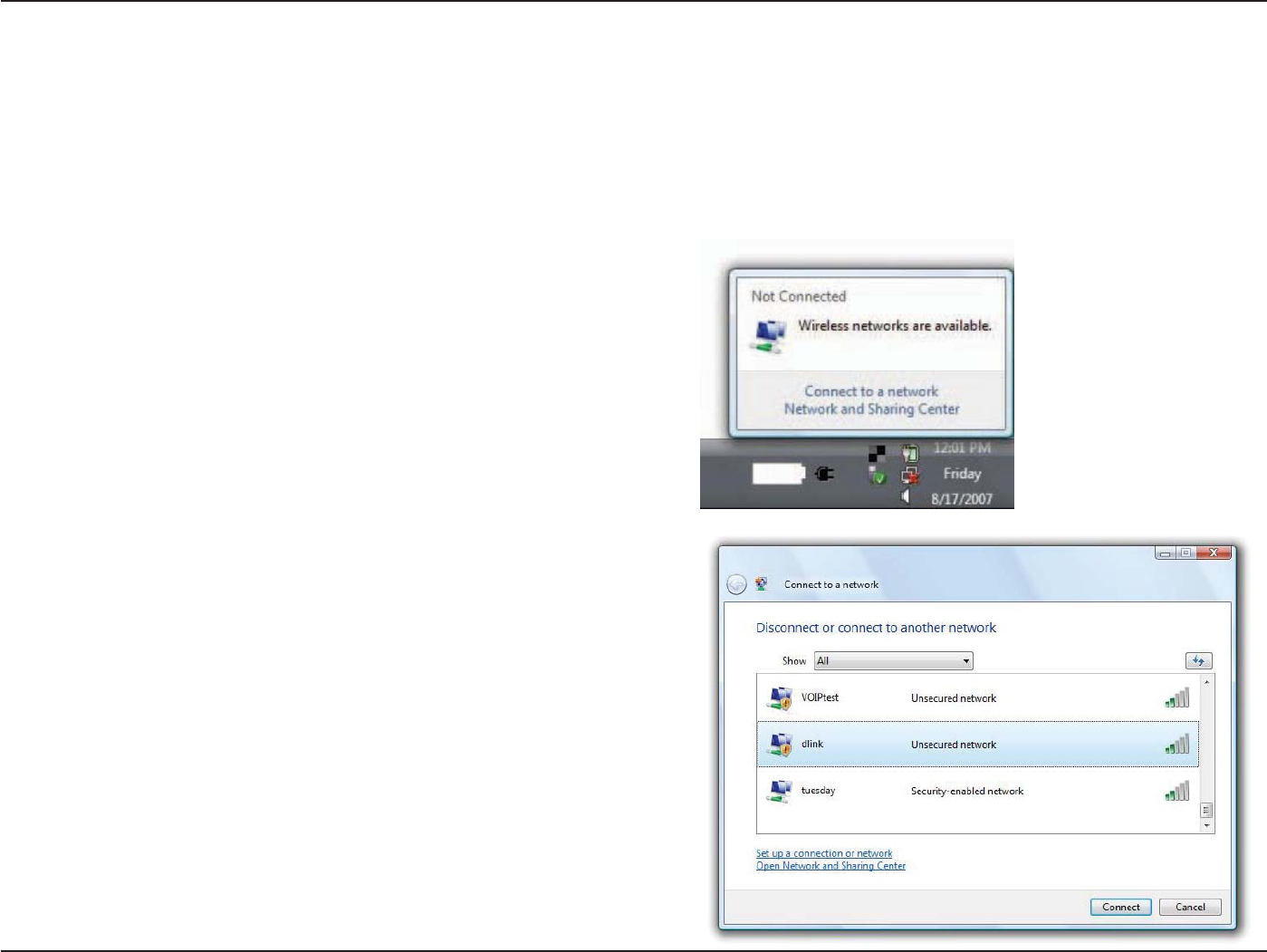
55D-Link DIR-516 User Manual
Section 3 - Connecting a Wireless Client
WPA/WPA2
It is recommended to enable wireless security (WPA/WPA2) on your wireless router or access point before conguring your
wireless adapter. If you are joining an existing network, you will need to know the security key or passphrase being used.
2. Highlight the wireless network (SSID) you would like to
connect to and click Connect.
1. Open the Windows Vista® Wireless Utility by right-clicking on
the wireless computer icon in your system tray (lower right
corner of screen). Select Connect to a network.
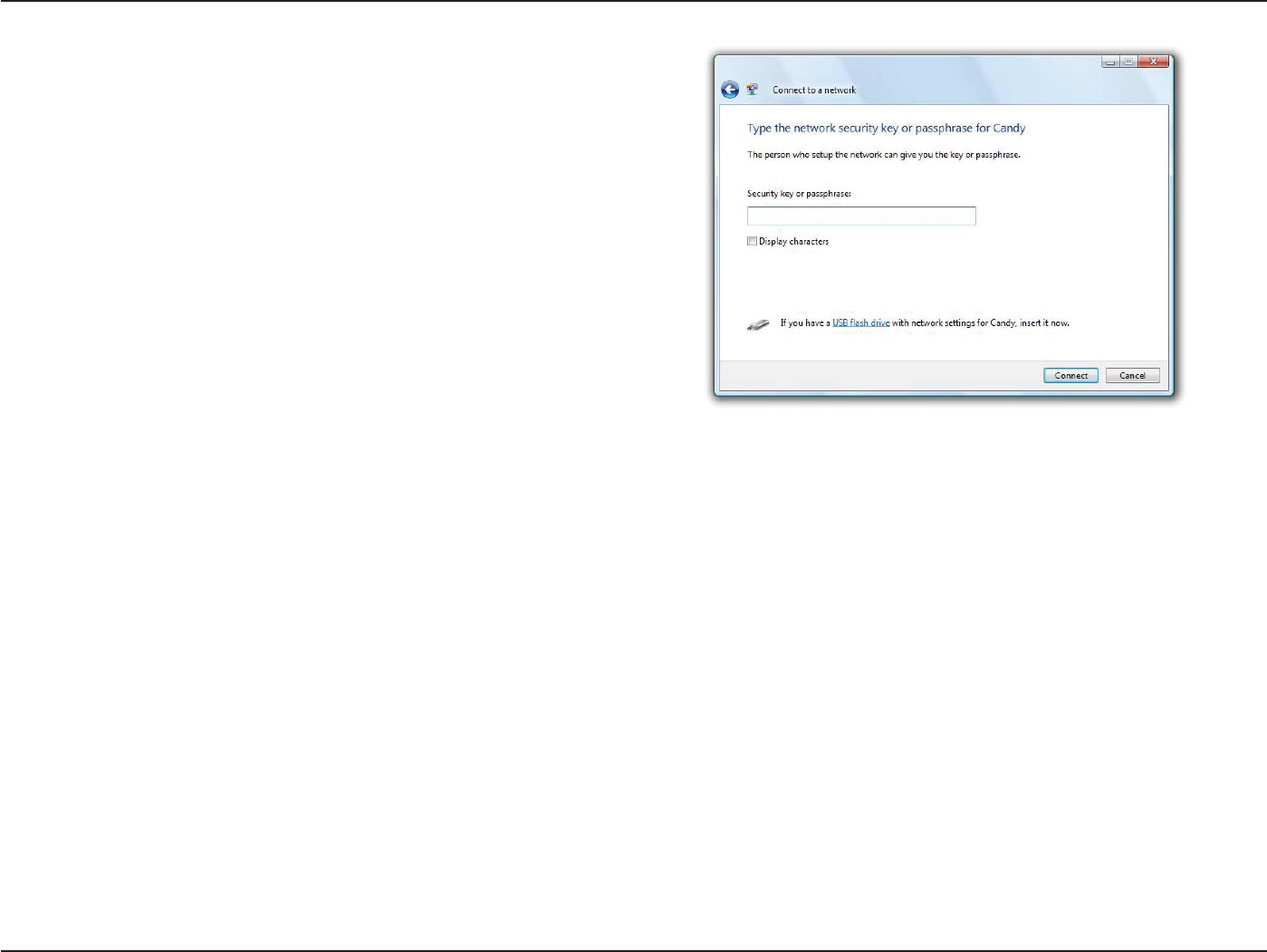
56D-Link DIR-516 User Manual
Section 3 - Connecting a Wireless Client
3. Enter the same security key or passphrase that is on your router
and click Connect.
It may take 20-30 seconds to connect to the wireless network. If
the connection fails, please verify that the security settings are
correct. The key or passphrase must be exactly the same as on
the wireless router.
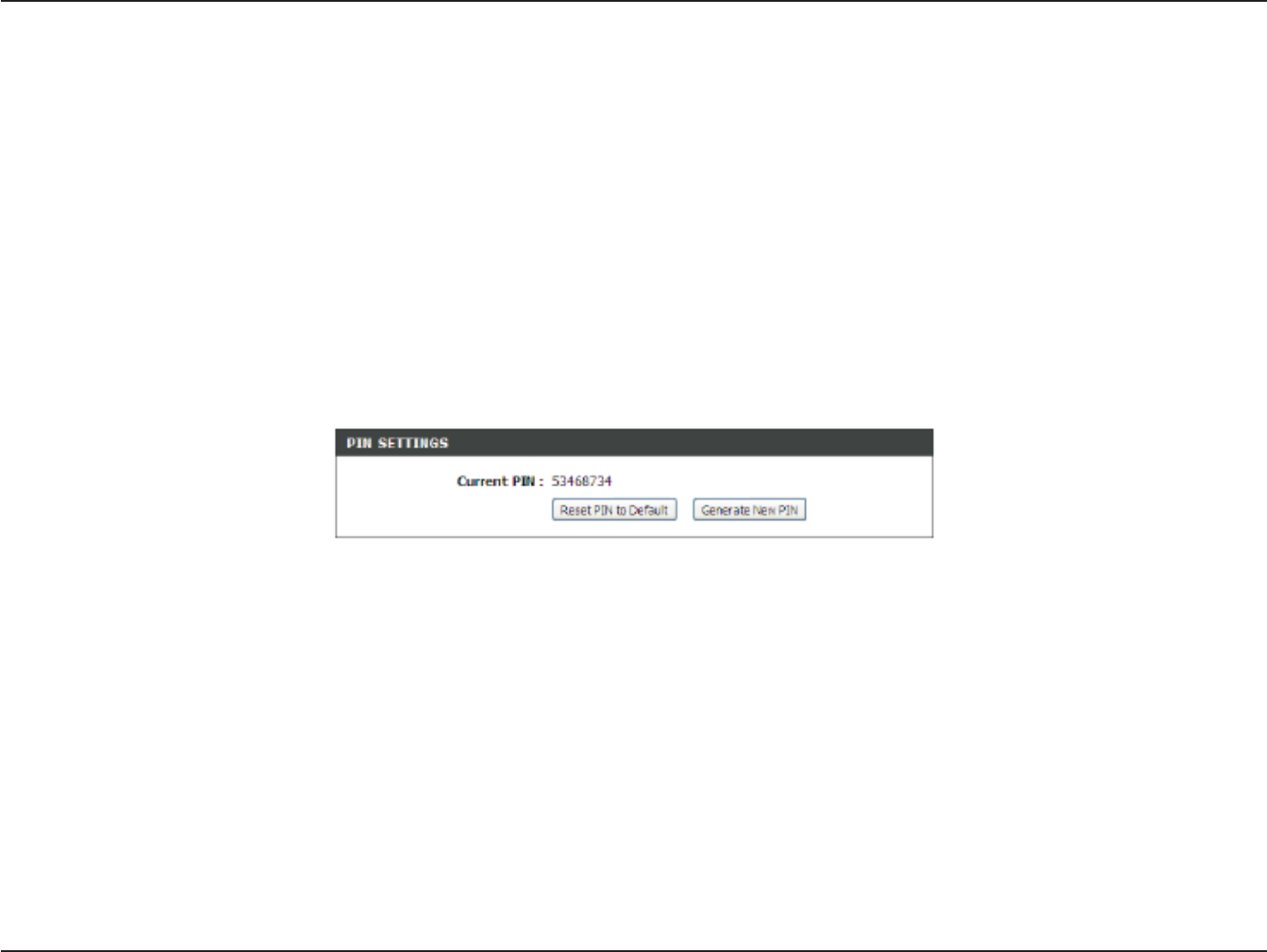
57D-Link DIR-516 User Manual
Section 3 - Connecting a Wireless Client
WPS/WCN 2.0
The router supports Wi-Fi protection, referred to as WCN 2.0 in Windows Vista®. The following instructions for setting this up
depends on whether you are using Windows Vista® to congure the router or third party software.
When you rst set up the router, Wi-Fi protection is disabled and uncongured. To enjoy the benets of Wi-Fi protection, the
router must be both enabled and congured. There are three basic methods to accomplish this: use Windows Vista’s built-in
support for WCN 2.0, use software provided by a third party, or manually congure.
If you are running Windows Vista®, log into the router and click the Enable checkbox in the Basic > Wireless section. Use the
Current PIN that is displayed on the Advanced > Wi-Fi Protected Setup section or choose to click the Generate New PIN
button or Reset PIN to Default button.
If you are using third party software to set up Wi-Fi Protection, carefully follow the directions. When you are nished, proceed
to the next section to set up the newly-congured router.
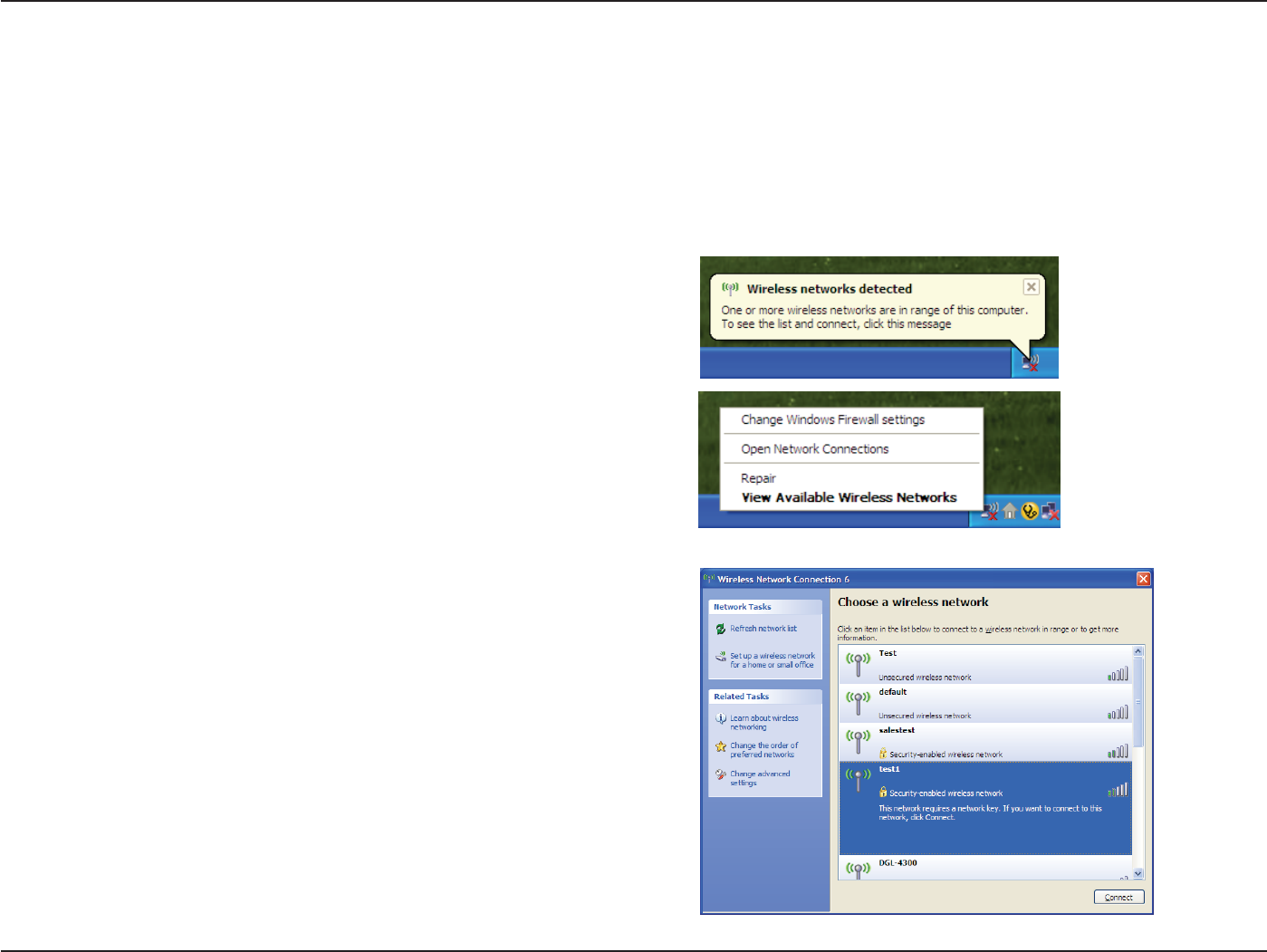
58D-Link DIR-516 User Manual
Section 3 - Connecting a Wireless Client
Windows® XP
Windows® XP users may use the built-in wireless utility (Zero Conguration Utility). The following instructions are for Service
Pack 2 users. If you are using another company’s utility, please refer to the user manual of your wireless adapter for help with
connecting to a wireless network. Most utilities will have a “site survey” option similar to the Windows® XP utility as seen below.
Right-click on the wireless computer icon in your system tray (lower-
right corner next to the time). Select View Available Wireless
Networks.
If you receive the Wireless Networks Detected bubble, click on
the center of the bubble to access the utility.
or
The utility will display any available wireless networks in your
area. Click on a network (displayed using the SSID) and click the
Connect button.
If you get a good signal but cannot access the Internet, check you
TCP/IP settings for your wireless adapter. Refer to the Networking
Basics section in this manual for more information.
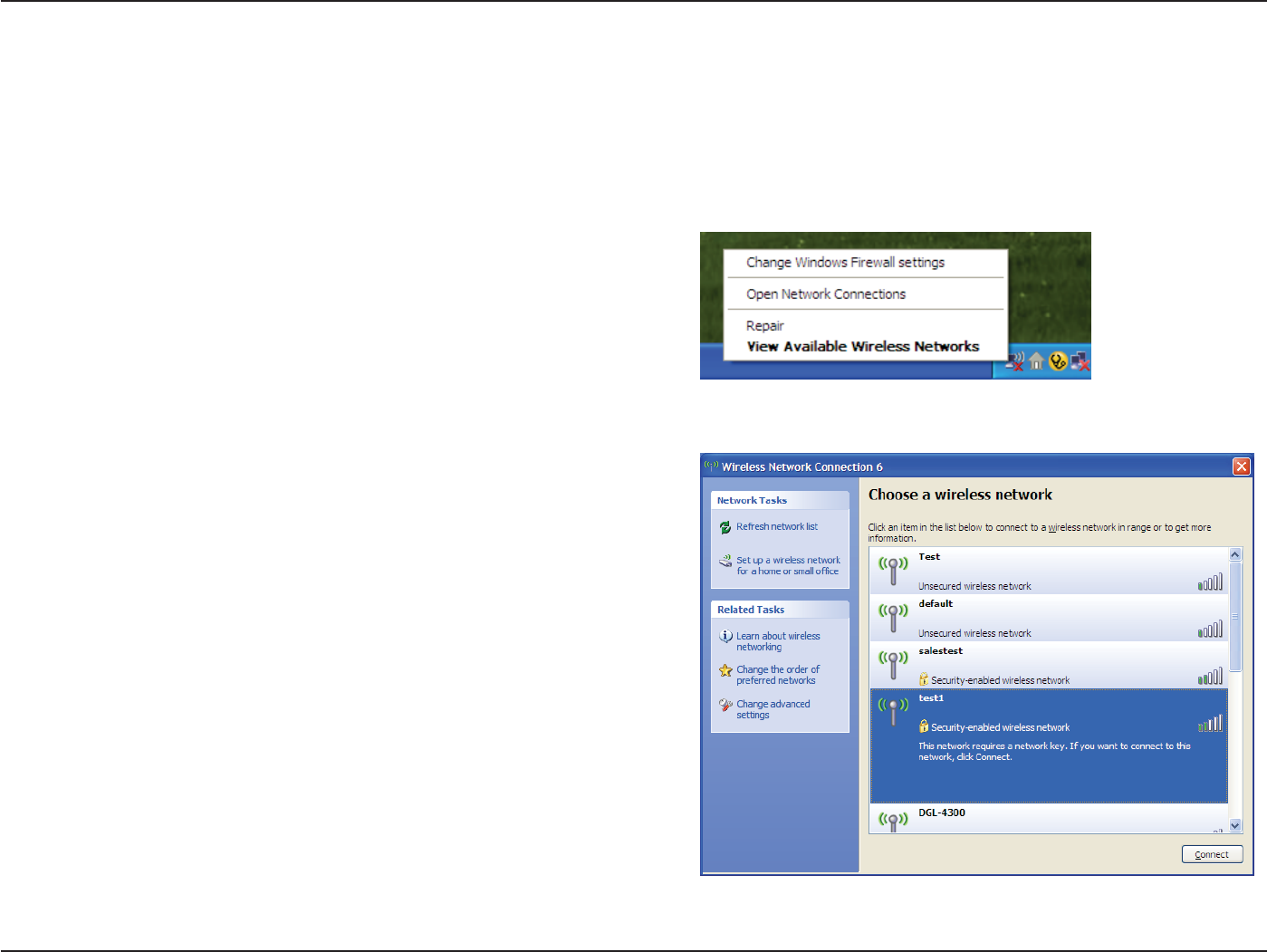
59D-Link DIR-516 User Manual
Section 3 - Connecting a Wireless Client
It is recommended to enable WPA on your wireless router or access point before conguring your wireless adapter. If you are
joining an existing network, you will need to know the WPA key being used.
2. Highlight the wireless network (SSID) you would like to
connect to and click Connect.
1. Open the Windows® XP Wireless Utility by right-clicking on the
wireless computer icon in your system tray (lower-right corner
of screen). Select View Available Wireless Networks.
WPA/WPA2
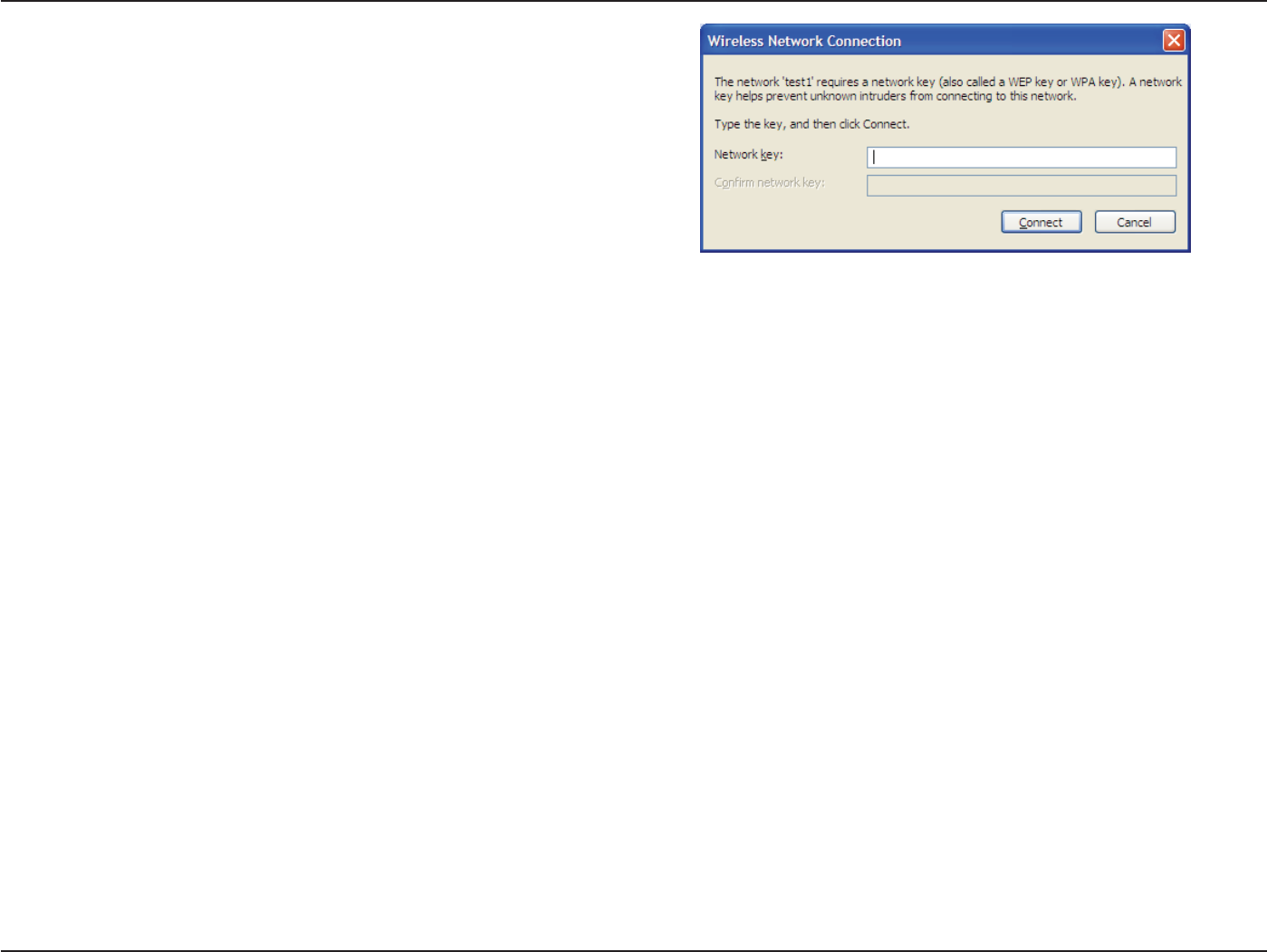
60D-Link DIR-516 User Manual
Section 3 - Connecting a Wireless Client
3. The Wireless Network Connection box will appear. Enter the
WPA-PSK passphrase and click Connect.
It may take 20-30 seconds to connect to the wireless network. If
the connection fails, please verify that the WPA-PSK settings are
correct. The WPA-PSK passphrase must be exactly the same as on
the wireless router.

61D-Link DIR-516 User Manual
Section 4 - Troubleshooting
Troubleshooting
This chapter provides solutions to problems that can occur during the installation and operation of the DIR-516. Read the
following descriptions if you are having problems. The examples below are illustrated in Windows® XP. If you have a dierent
operating system, the screenshots on your computer will look similar to the following examples.
1. Why can’t I access the web-based conguration utility?
When entering the IP address of the D-Link router (192.168.0.1 for example), you are not connecting to a website nor do you
have to be connected to the Internet. The device has the utility built-in to a ROM chip in the device itself. Your computer must
be on the same IP subnet to connect to the web-based utility.
• Make sure you have an updated Java-enabled web browser. We recommend the following:
- Microsoft Internet Explorer® 6.0 and higher
- Mozilla Firefox 3.0 and higher
- Google™ Chrome 2.0 and higher
- Apple Safari 3.0 and higher
• Verify physical connectivity by checking for solid link lights on the device. If you do not get a solid link light, try using a
dierent cable or connect to a dierent port on the device if possible. If the computer is turned o, the link light may not be
on.
• Disable any Internet security software running on the computer. Software rewalls such as ZoneAlarm, BlackICE, Sygate,
Norton Personal Firewall, and Windows® XP rewall may block access to the conguration pages. Check the help les included
with your rewall software for more information on disabling or conguring it.

62D-Link DIR-516 User Manual
Section 4 - Troubleshooting
• Congure your Internet settings:
• Go to Start > Settings > Control Panel. Double-click the Internet Options Icon. From the Security tab, click
the button to restore the settings to their defaults.
• Click the Connection tab and set the dial-up option to Never Dial a Connection. Click the LAN Settings button.
Make sure nothing is checked. Click OK.
• Go to the Advanced tab and click the button to restore these settings to their defaults. Click OK three times.
• Close your web browser (if open) and open it.
• Access the web management. Open your web browser and enter the IP address of your D-Link router in the address bar. This
should open the login page for your web management.
• If you still cannot access the conguration, unplug the power to the router for 10 seconds and plug back in. Wait about 30
seconds and try accessing the conguration. If you have multiple computers, try connecting using a dierent computer.
2. What can I do if I forgot my password?
If you forgot your password, you must reset your router. Unfortunately this process will change all your settings back to the
factory defaults.
To reset the router, locate the reset button (hole) on the rear panel of the unit. With the router powered on, use a paperclip
to hold the button down for 10 seconds. Release the button and the router will go through its reboot process. Wait about 30
seconds to access the router. The default IP address is 192.168.0.1. When logging in, the username is admin and leave the
password box empty.
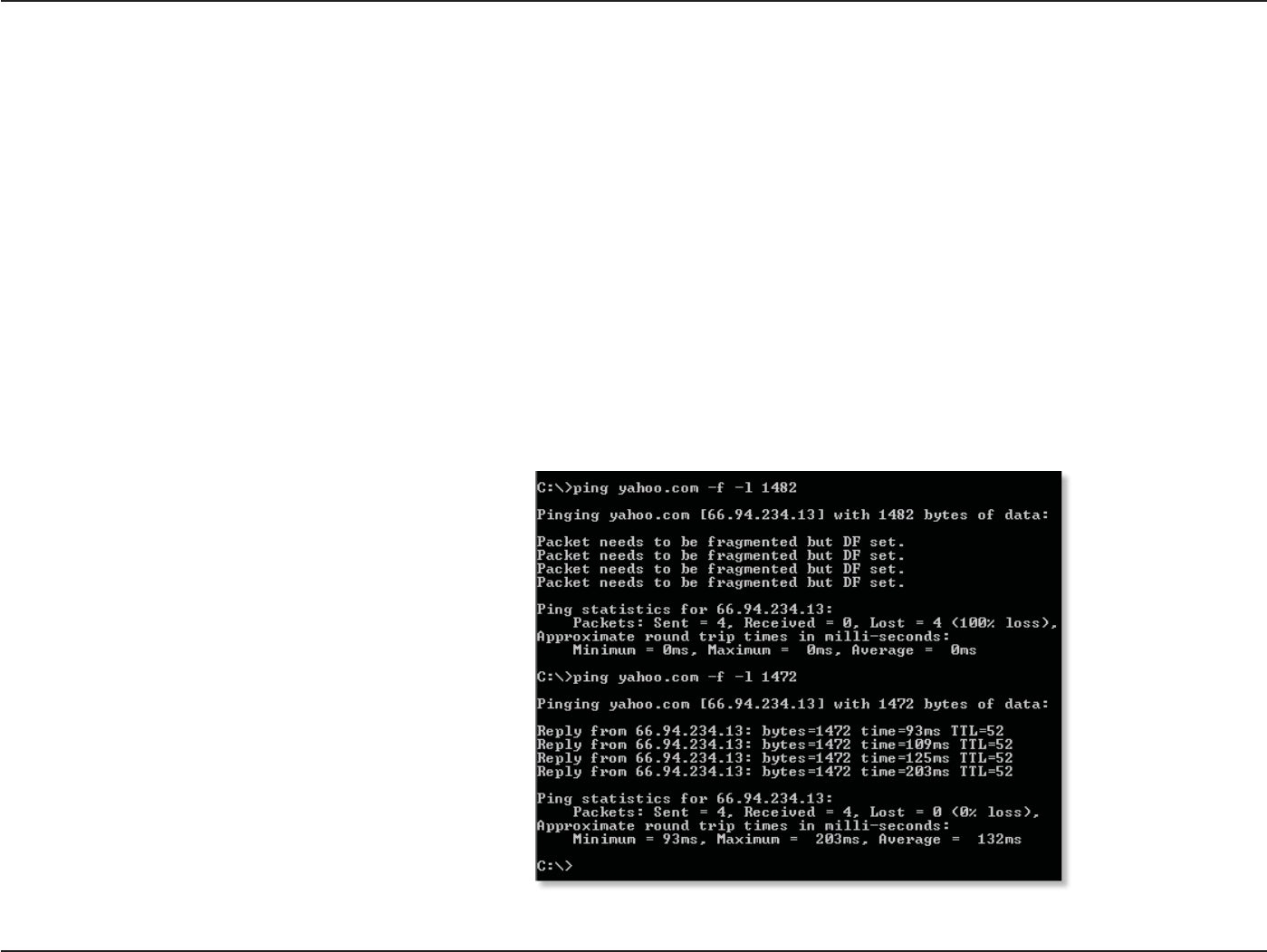
63D-Link DIR-516 User Manual
Section 4 - Troubleshooting
3. Why can’t I connect to certain sites or send and receive emails when connecting through my router?
If you are having a problem sending or receiving email, or connecting to secure sites such as eBay, banking sites, and Hotmail,
we suggest lowering the MTU in increments of ten (Ex. 1492, 1482, 1472, etc).
To nd the proper MTU Size, you’ll have to do a special ping of the destination you’re trying to go to. A destination could be
another computer, or a URL.
• Click on Start and then click Run.
• Windows® 95, 98, and Me users type in command (Windows® NT, 2000, XP, Vista®, 7 and 8 users type in cmd)
and press Enter (or click OK).
• Once the window opens, you’ll need to do a special ping. Use the following syntax:
ping [url] [-f] [-l] [MTU value]
Example: ping yahoo.com -f -l 1472

64D-Link DIR-516 User Manual
Section 4 - Troubleshooting
You should start at 1472 and work your way down by 10 each time. Once you get a reply, go up by 2 until you get a fragmented
packet. Take that value and add 28 to the value to account for the various TCP/IP headers. For example, lets say that 1452 was the
proper value, the actual MTU size would be 1480, which is the optimum for the network we’re working with (1452+28=1480).
Once you nd your MTU, you can now congure your router with the proper MTU size.
To change the MTU rate on your router follow the steps below:
• Open your browser, enter the IP address of your router (192.168.0.1) and click OK.
• Enter your username (admin) and password (blank by default). Click OK to enter the web conguration page
for the device.
• Click on Setup and then click Manual Congure.
• To change the MTU enter the number in the MTU eld and click Save Settings to save your settings.
• Test your email. If changing the MTU does not resolve the problem, continue changing the MTU in increments
of ten.

65D-Link DIR-516 User Manual
Appendix A - Wireless Basics
D-Link wireless products are based on industry standards to provide easy-to-use and compatible high-speed wireless
connectivity within your home, business or public access wireless networks. Strictly adhering to the IEEE standard, the D-Link
wireless family of products will allow you to securely access the data you want, when and where you want it. You will be able
to enjoy the freedom that wireless networking delivers.
A wireless local area network (WLAN) is a cellular computer network that transmits and receives data with radio signals instead
of wires. Wireless LANs are used increasingly in both home and oce environments, and public areas such as airports, coee
shops, and universities. Innovative ways to utilize WLAN technology are helping people to work and communicate more
eciently. Increased mobility and the absence of cabling and other xed infrastructure have proven to be benecial for many
users.
Wireless users can use the same applications they use on a wired network. Wireless adapter cards used on laptop and desktop
systems support the same protocols as Ethernet adapter cards.
Under many circumstances, it may be desirable for mobile network devices to link to a conventional Ethernet LAN in order to
use servers, printers or an Internet connection supplied through the wired LAN. A wireless router is a device used to provide
this link.
Wireless Basics

66D-Link DIR-516 User Manual
Appendix A - Wireless Basics
What is Wireless?
Wireless or Wi-Fi technology is another way of connecting your computer to the network without using wires. Wi-Fi uses radio
frequency to connect wirelessly, so you have the freedom to connect computers anywhere in your home or oce network.
Why D-Link Wireless?
D-Link is the worldwide leader and award winning designer, developer, and manufacturer of networking products. D-Link
delivers the performance you need at a price you can aord. D-Link has all the products you need to build your network.
How does wireless work?
Wireless works similar to how cordless phone work, through radio signals to transmit data from one point A to point B. But
wireless technology has restrictions as to how you can access the network. You must be within the wireless network range area
to be able to connect your computer. There are two dierent types of wireless networks: Wireless Local Area Network (WLAN),
and Wireless Personal Area Network (WPAN).
Wireless Local Area Network (WLAN)
In a wireless local area network, a device called an Access Point (AP) connects computers to the network. The access point has
a small antenna attached to it, which allows it to transmit data back and forth over radio signals. With an indoor access point
as seen in the picture, the signal can travel up to 300 feet. With an outdoor access point the signal can reach out up to 30 miles
to serve places like manufacturing plants, industrial locations, college and high school campuses, airports, golf courses, and
many other outdoor venues.

67D-Link DIR-516 User Manual
Appendix A - Wireless Basics
Wireless Personal Area Network (WPAN)
Bluetooth is the industry standard wireless technology used for WPAN. Bluetooth devices in WPAN operate in a range up to
30 feet away.
Compared to WLAN the speed and wireless operation range are both less than WLAN, but in return it doesn’t use nearly as
much power which makes it ideal for personal devices, such as mobile phones, PDAs, headphones, laptops, speakers, and other
devices that operate on batteries.
Who uses wireless?
Wireless technology as become so popular in recent years that almost everyone is using it, whether it’s for home, oce, business,
D-Link has a wireless solution for it.
Home
• Gives everyone at home broadband access
• Surf the web, check email, instant message, etc.
• Gets rid of the cables around the house
• Simple and easy to use
Small Oce and Home Oce
• Stay on top of everything at home as you would at oce
• Remotely access your oce network from home
• Share Internet connection and printer with multiple computers
• No need to dedicate oce space

68D-Link DIR-516 User Manual
Appendix A - Wireless Basics
Where is wireless used?
Wireless technology is expanding everywhere not just at home or oce. People like the freedom of mobility and it’s becoming
so popular that more and more public facilities now provide wireless access to attract people. The wireless connection in public
places is usually called “hotspots”.
Using a D-Link CardBus Adapter with your laptop, you can access the hotspot to connect to Internet from remote locations
such as airports, hotels, coee shops, libraries, restaurants, and convention centers.
A wireless network is easy to setup, but if you’re installing it for the rst time it could be quite a task not knowing where to start.
That’s why we’ve put together a few setup steps and tips to help you through the process of setting up a wireless network.
Tips
Here are a few things to keep in mind, when you install a wireless network.
Centralize your router or Access Point
Make sure you place the router/access point in a centralized location within your network for the best performance. Try to
place the router/access point as high as possible in the room, so the signal gets dispersed throughout your home. If you have
a two-story home, you may need a repeater to boost the signal to extend the range.
Eliminate Interference
Place home appliances such as cordless telephones, microwaves, and televisions as far away as possible from the router/access
point. This would signicantly reduce any interference that the appliances might cause since they operate on same frequency.
Security
Don’t let you next-door neighbors or intruders connect to your wireless network. Secure your wireless network by turning on
the WPA or WEP security feature on the router. Refer to product manual for detail information on how to set it up.
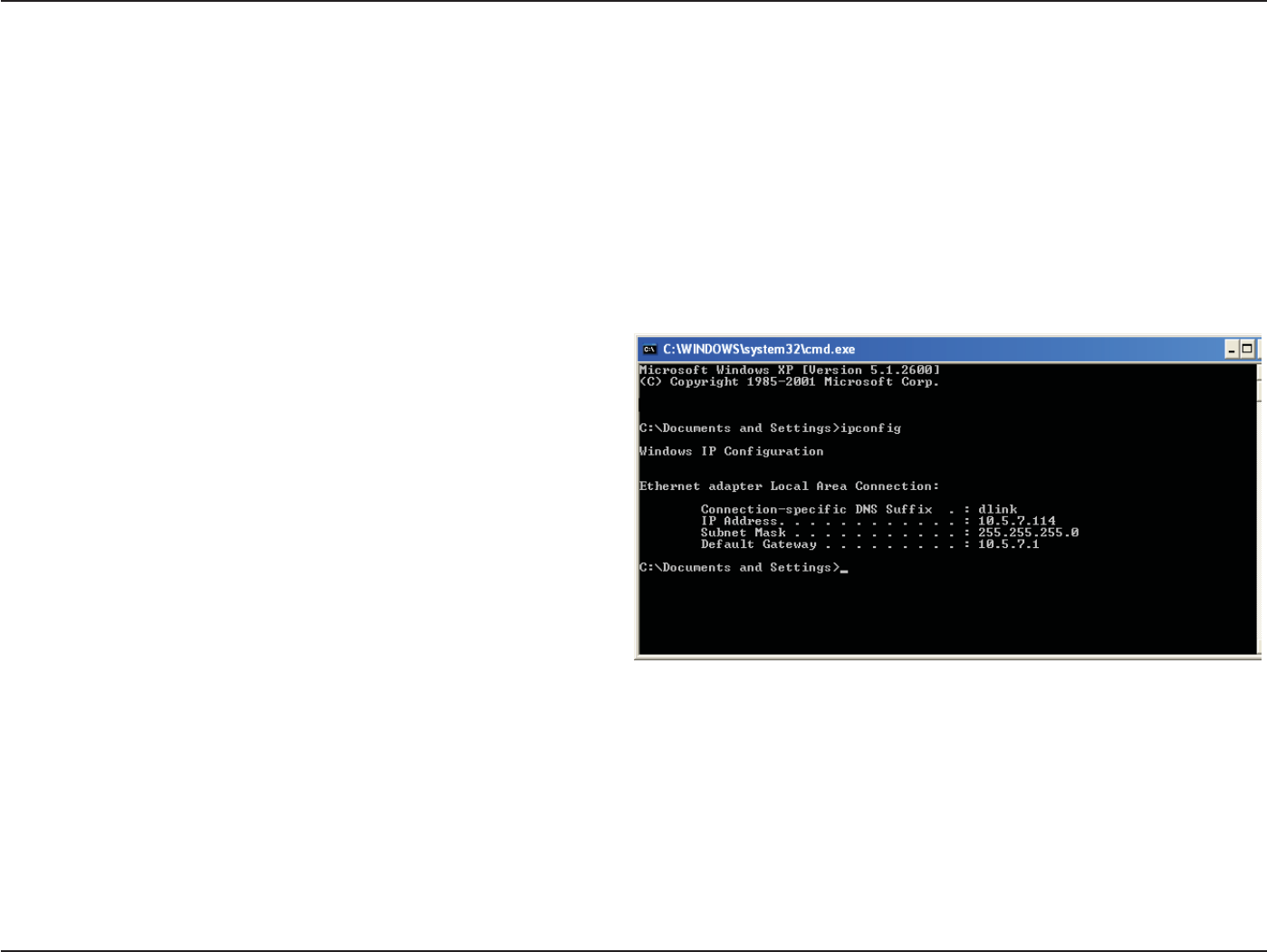
69D-Link DIR-516 User Manual
Appendix B - Networking Basics
Networking Basics
Check your IP address
After you install your new D-Link adapter, by default, the TCP/IP settings should be set to obtain an IP address from a DHCP
server (i.e. wireless router) automatically. To verify your IP address, please follow the steps below.
Click on Start > Run. In the run box type cmd and click OK. (Windows® 8/7/Vista® users type cmd in the Start Search box.)
At the prompt, type ipcong and press Enter.
This will display the IP address, subnet mask, and the default
gateway of your adapter.
If the address is 0.0.0.0, check your adapter installation,
security settings, and the settings on your router. Some
rewall software programs may block a DHCP request on
newly installed adapters.
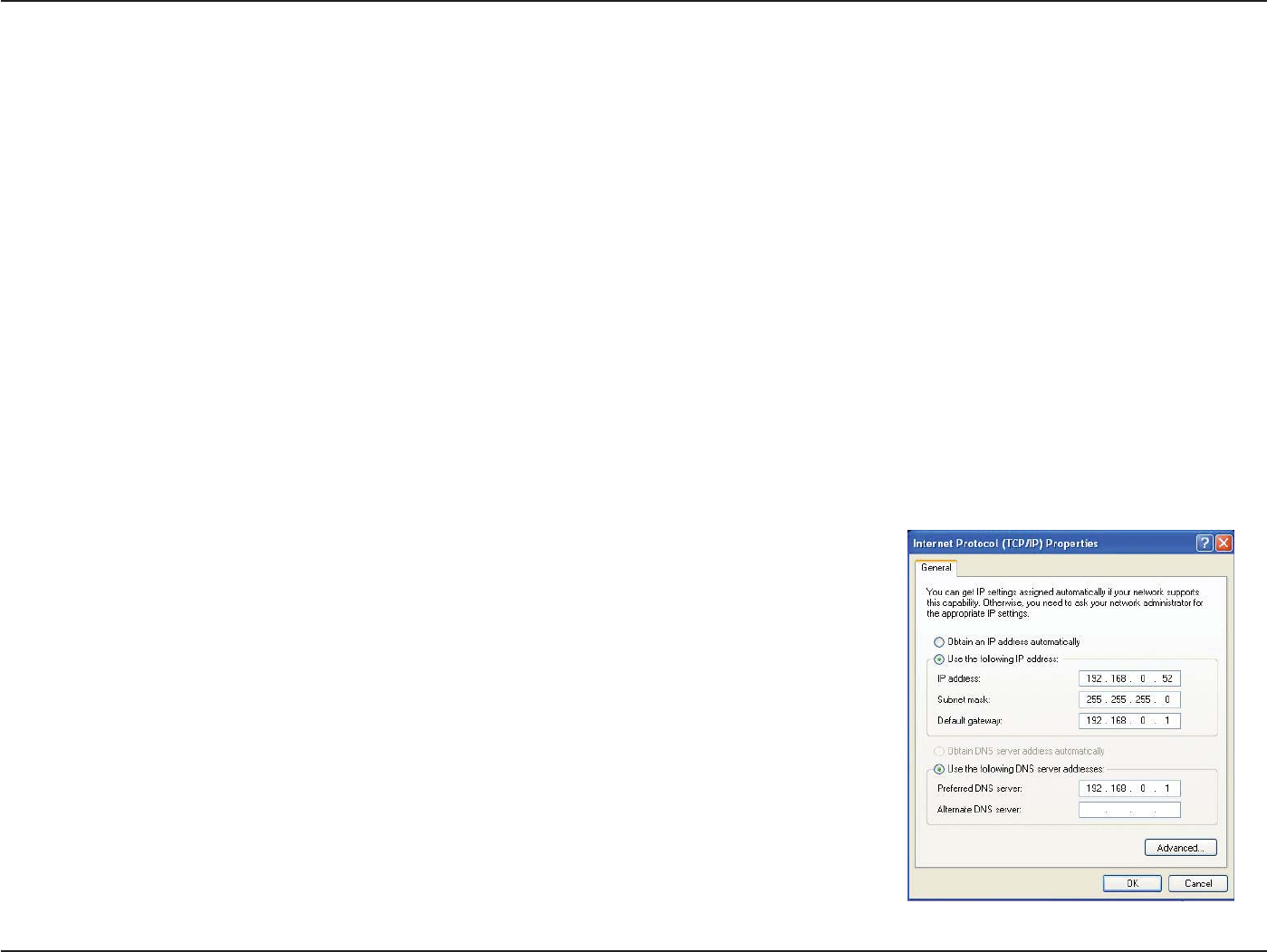
70D-Link DIR-516 User Manual
Appendix B - Networking Basics
Statically Assign an IP address
If you are not using a DHCP capable gateway/router, or you need to assign a static IP address, please follow the steps below:
Step 1
Windows® 7 - Click on Start > Control Panel > Network and Internet > Network and Sharing Center.
Windows Vista® - Click on Start > Control Panel > Network and Internet > Network and Sharing Center > Manage Network
Connections.
Windows® XP - Click on Start > Control Panel > Network Connections.
Windows® 2000 - From the desktop, right-click My Network Places > Properties.
Step 2
Right-click on the Local Area Connection which represents your network adapter and select Properties.
Step 3
Highlight Internet Protocol (TCP/IP) and click Properties.
Step 4
Click Use the following IP address and enter an IP address that is on the same subnet
as your network or the LAN IP address on your router.
Example: If the router´s LAN IP address is 192.168.0.1, make your IP address 192.168.0.X
where X is a number between 2 and 99. Make sure that the number you choose is not
in use on the network. Set the Default Gateway the same as the LAN IP address of your
router (I.E. 192.168.0.1).
Set Primary DNS the same as the LAN IP address of your router (192.168.0.1). The
Secondary DNS is not needed or you may enter a DNS server from your ISP.
Step 5
Click OK twice to save your settings.

71D-Link DIR-516 User Manual
Appendix C - Technical Specications
Technical Specications
Standards
• IEEE 802.11a
• IEEE 802.11b
• IEEE 802.11g
• IEEE 802.11n
• IEEE 802.11ac(Draft)
Interfaces
• 802.11n/g/b wireless
• 10/100 WAN/LAN port
• WPS button
• Reset button
• Switch Button for 2.4GHz/5GHz
Wireless Modes
• Router Mode
• Access Point Mode
Wireless Frequency Range1
• 2.4 GHz to 2.4835 GHz
• 5.15~5.25GHz, 5.725 ~ 5.85GHz
Antennas
• Internal Antenna
Security
• Wi-Fi Protected Access (WPA/WPA2)
• WPS™ (PBC)
Diagnostic LEDs
• Power
• Internet
Operating Temperature
• 0 to 40 ˚C (32 to 104 ˚F)
Operating Humidity
• 0% to 90% non-condensing
Power
• 5 V DC
Certications
• CE
• Wi-Fi Certied
• FCC
Dimensions
• 63x44x23mm
Weight
• 29.72g
1 Frequency Range varies depending on local regulations.
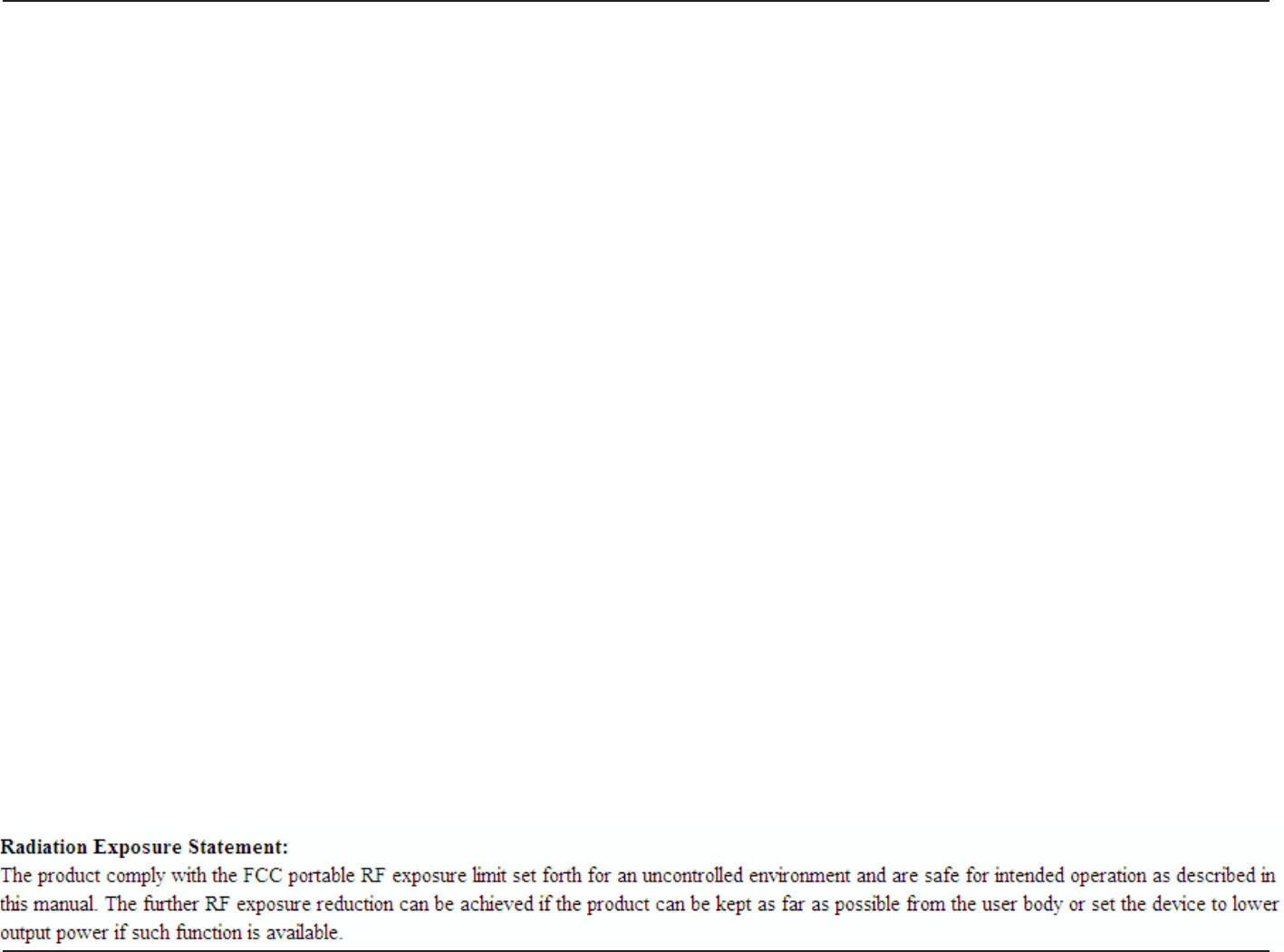
72D-Link DIR-516 User Manual
Appendix D - Safety Statements
Safety Statements
CE Mark Warning:
This is a Class B product. In a domestic environment, this product may cause radio interference, in which case the user may be required to take
adequate measures.
Federal Communication Commission Interference Statement
This device complies with Part 15 of the FCC Rules. Operation is subject to the following two conditions: (1) This device may not cause harmful
interference, and (2) this device must accept any interference received, including interference that may cause undesired operation.
This equipment has been tested and found to comply with the limits for a Class B digital device, pursuant to Part 15 of the FCC Rules. These limits are
designed to provide reasonable protection against harmful interference in a residential installation. This equipment generates, uses and can radiate
radio frequency energy and, if not installed and used in accordance with the instructions, may cause harmful interference to radio communications.
However, there is no guarantee that interference will not occur in a particular installation. If this equipment does cause harmful interference to radio
or television reception, which can be determined by turning the equipment o and on, the user is encouraged to try to correct the interference by
one of the following measures:
- Reorient or relocate the receiving antenna.
- Increase the separation between the equipment and receiver.
- Connect the equipment into an outlet on a circuit dierent from that to which the receiver is connected.
- Consult the dealer or an experienced radio/TV technician for help.
FCC Caution: Any changes or modications not expressly approved by the party responsible for compliance could void the user’s authority to
operate this equipment.
This transmitter must not be co-located or operating in conjunction with any other antenna or transmitter.
For operation within 5.15 ~ 5.25GHz frequency range, it is restricted to indoor environment. This device meets all the other requirements specied
in Part 15E, Section 15.407 of the FCC Rules.
Radiation Exposure Statement:
This equipment complies with FCC radiation exposure limits set forth for an uncontrolled environment. This equipment should be installed and
operated with minimum distance 20cm between the radiator & your body.

AppendixDͲSafetyStatements
_____________________________________________________________________
ThemodelDIRͲ516isintendedforusewithothercertifiedequipmentwithlimited
powersource,wherethesuitabilityofthecombinationistobedetermined.
㲐シ!
ὅ㒂Ỷ≇䌯暣㲊廣⮬⿏暣㨇䭉䎮彎㱽䫔⋩Ḵ㡅烉䴻✳⺷娵嫱⎰㟤ᷳỶ≇䌯⮬柣
暣㨇炻朆䴻姙⎗炻℔⎠ˣ⓮嘇ㆾἧ䓐侭⛯ᶵ⼿㑭冒嬲㚜柣䌯ˣ≈⣏≇䌯ㆾ嬲㚜⍇
姕妰ᷳ䈡⿏⍲≇傥ˤ䫔⋩⚃㡅烉Ỷ≇䌯⮬柣暣㨇ᷳἧ䓐ᶵ⼿⼙枧梃凒⬱ℐ⍲⸚
㒦⎰㱽忂ᾉ烊䴻䘤䎦㚱⸚㒦䎦尉㗪炻ㅱ䩳⌛ 䓐炻᷎㓡┬军䃉⸚㒦㗪㕡⼿两临ἧ
䓐ˤ⇵枭⎰㱽忂ᾉ炻㊯ὅ暣ᾉ夷⭂ἄ㤕ᷳ䃉䶂暣ᾉˤỶ≇䌯⮬柣暣㨇枰⽵⍿⎰㱽
忂ᾉㆾⶍ㤕ˣ䥹⬠⍲慓䗪䓐暣㲊廣⮬⿏暣㨇姕⁁ᷳ⸚㒦ˤ